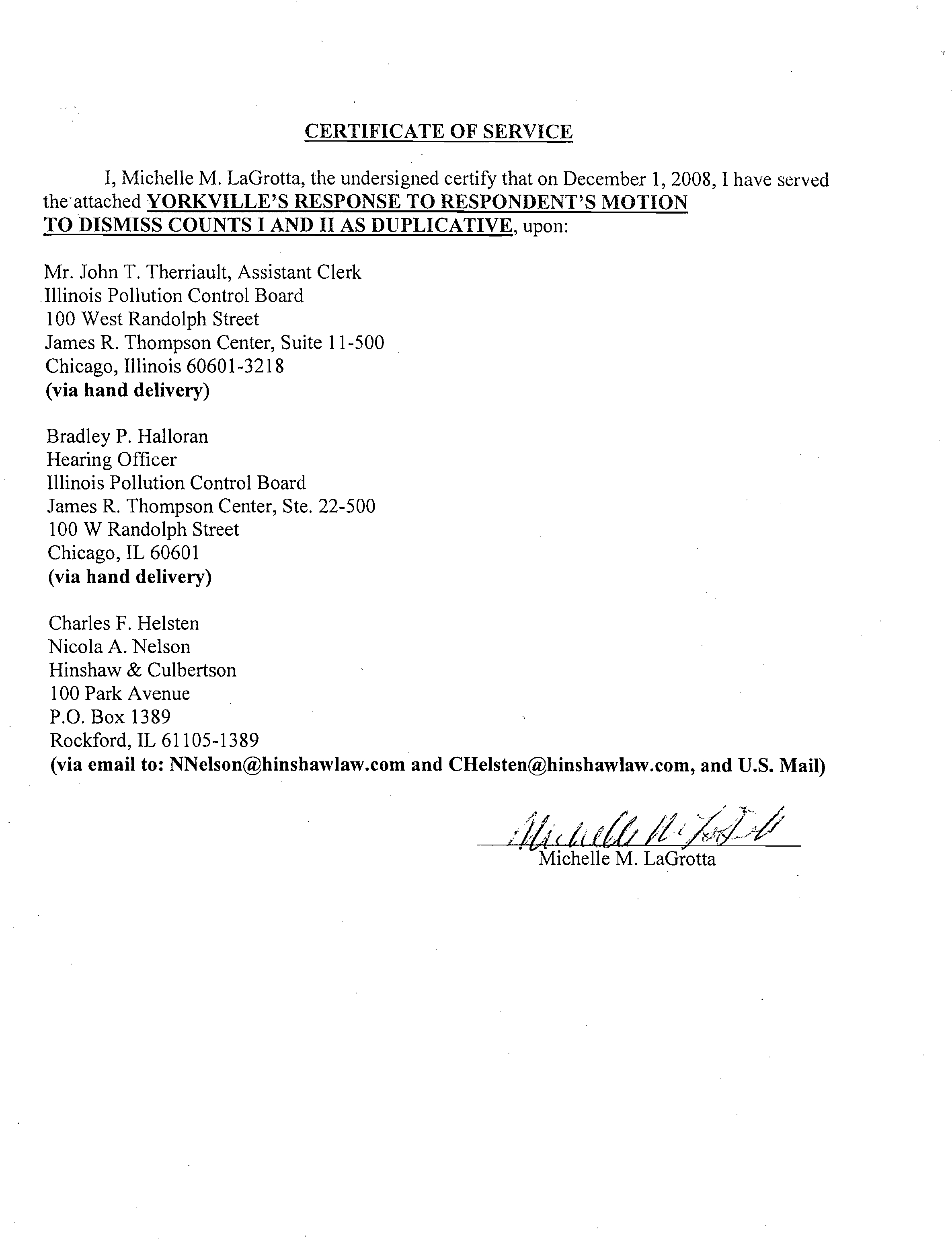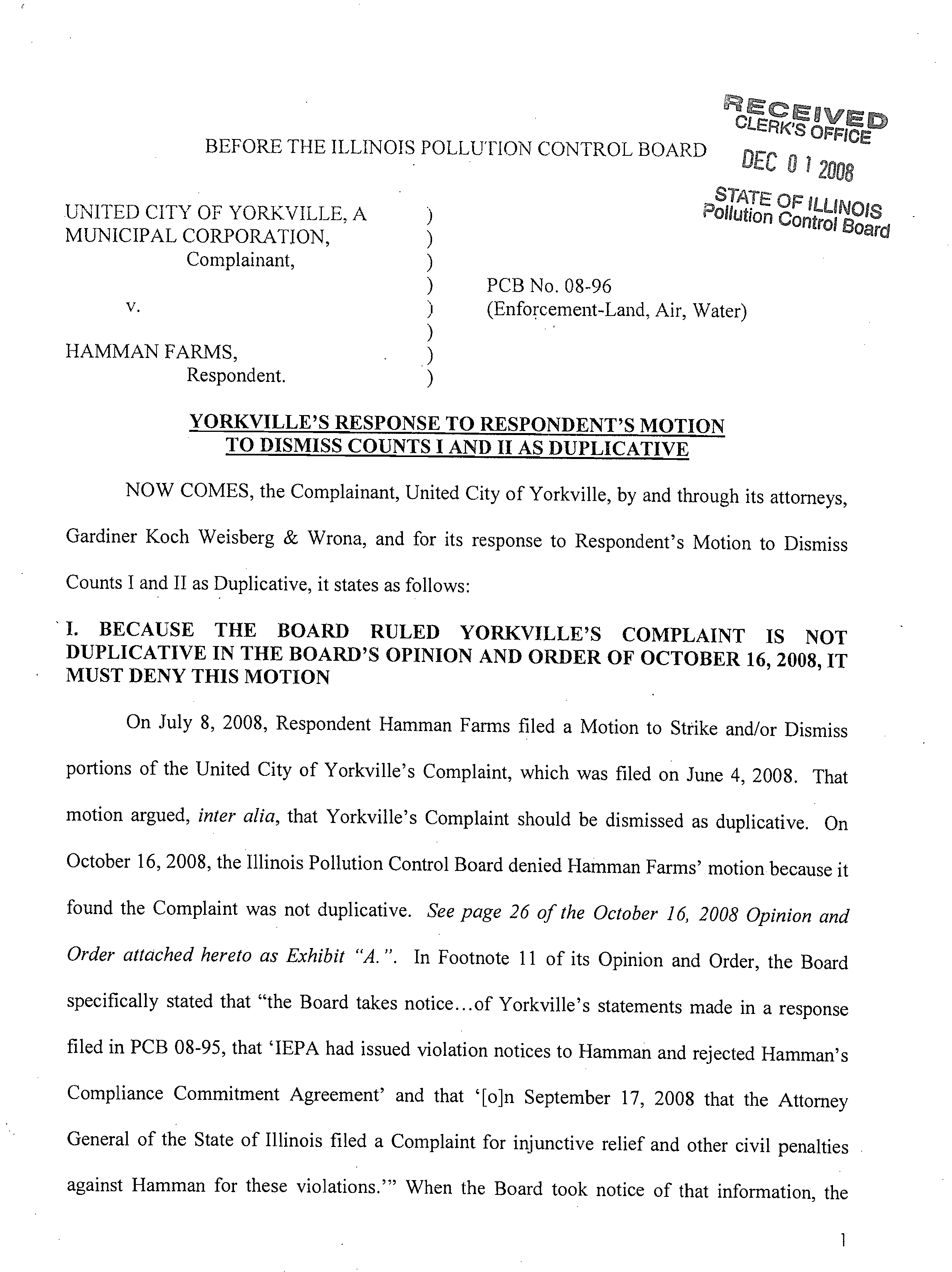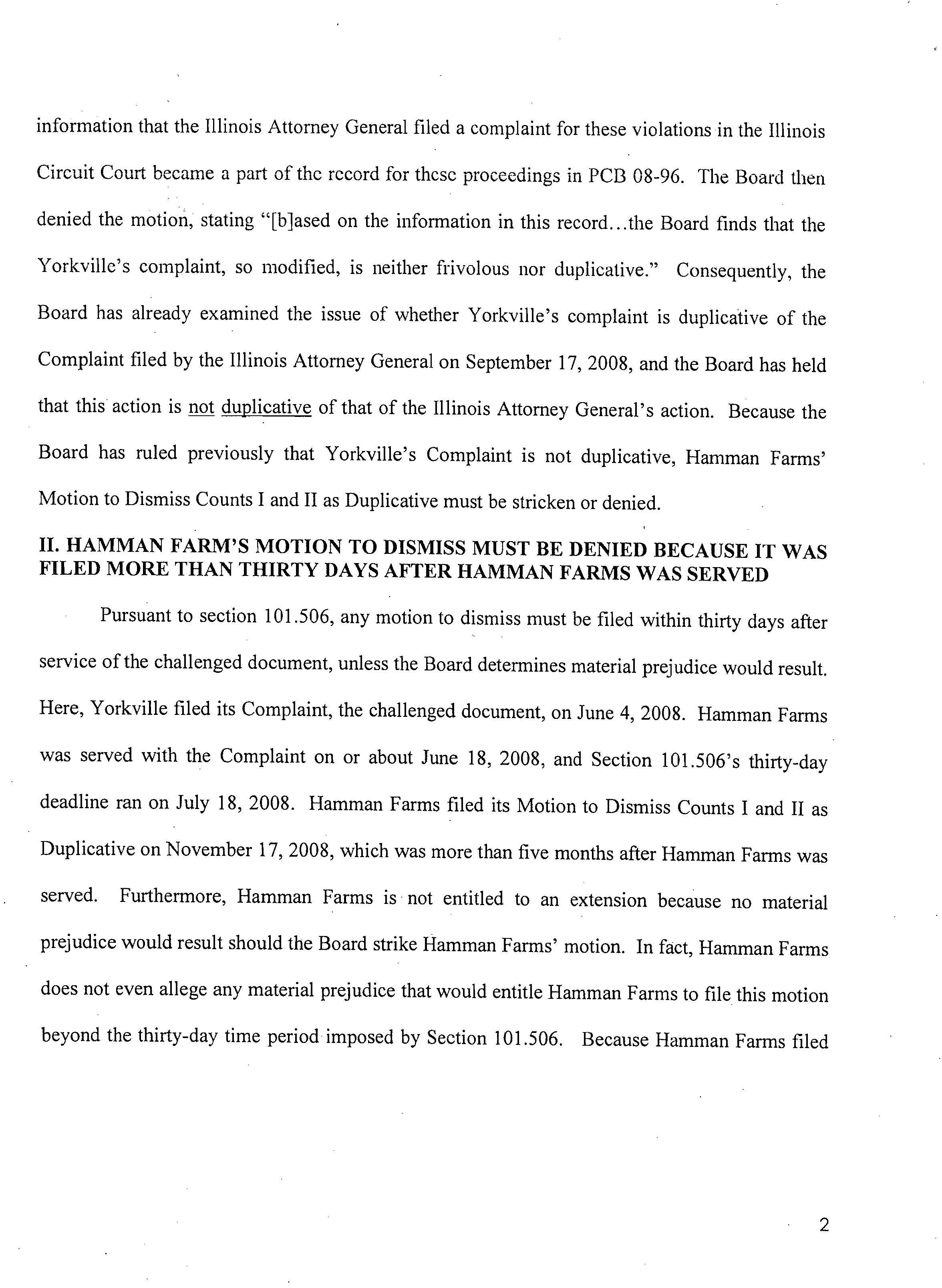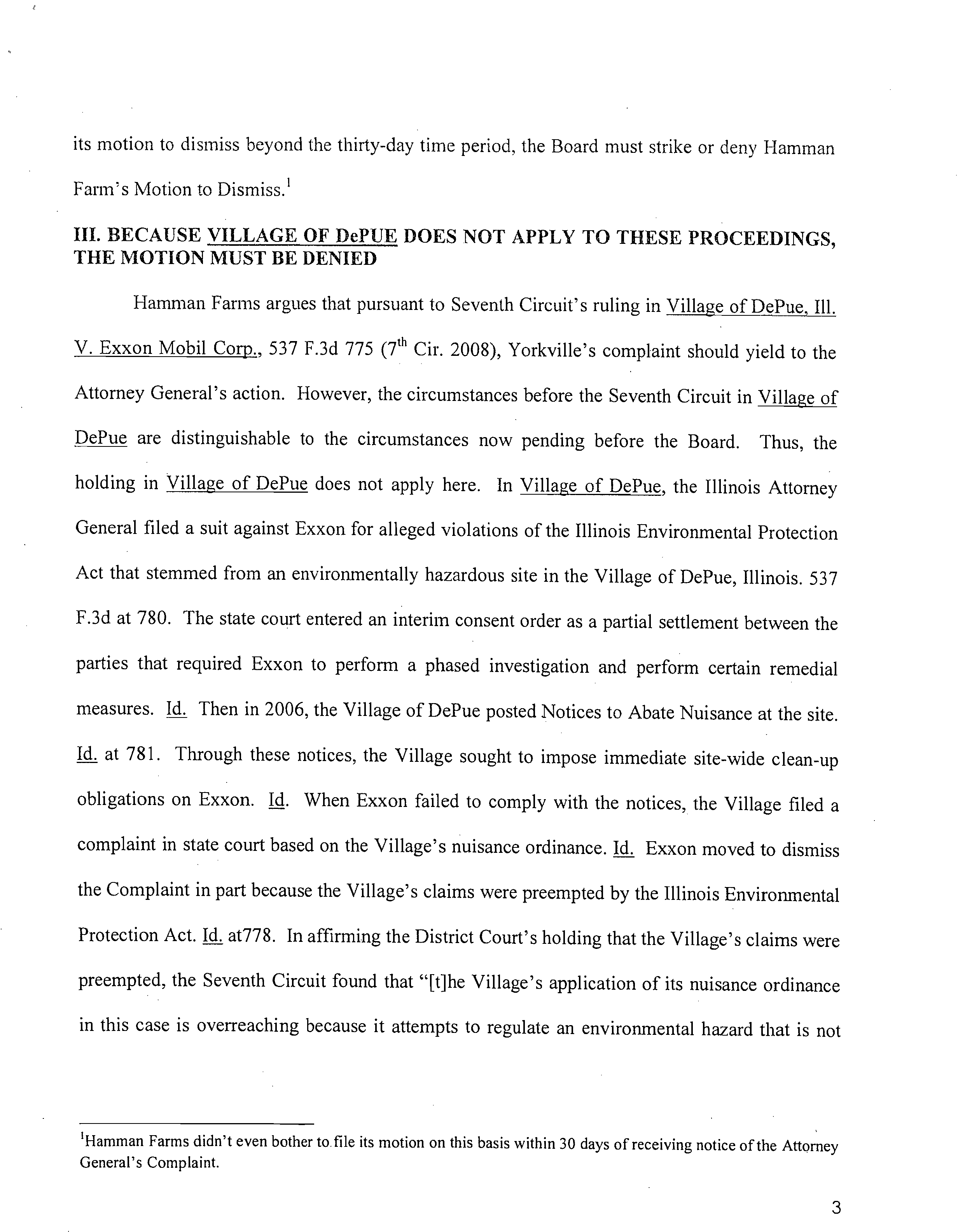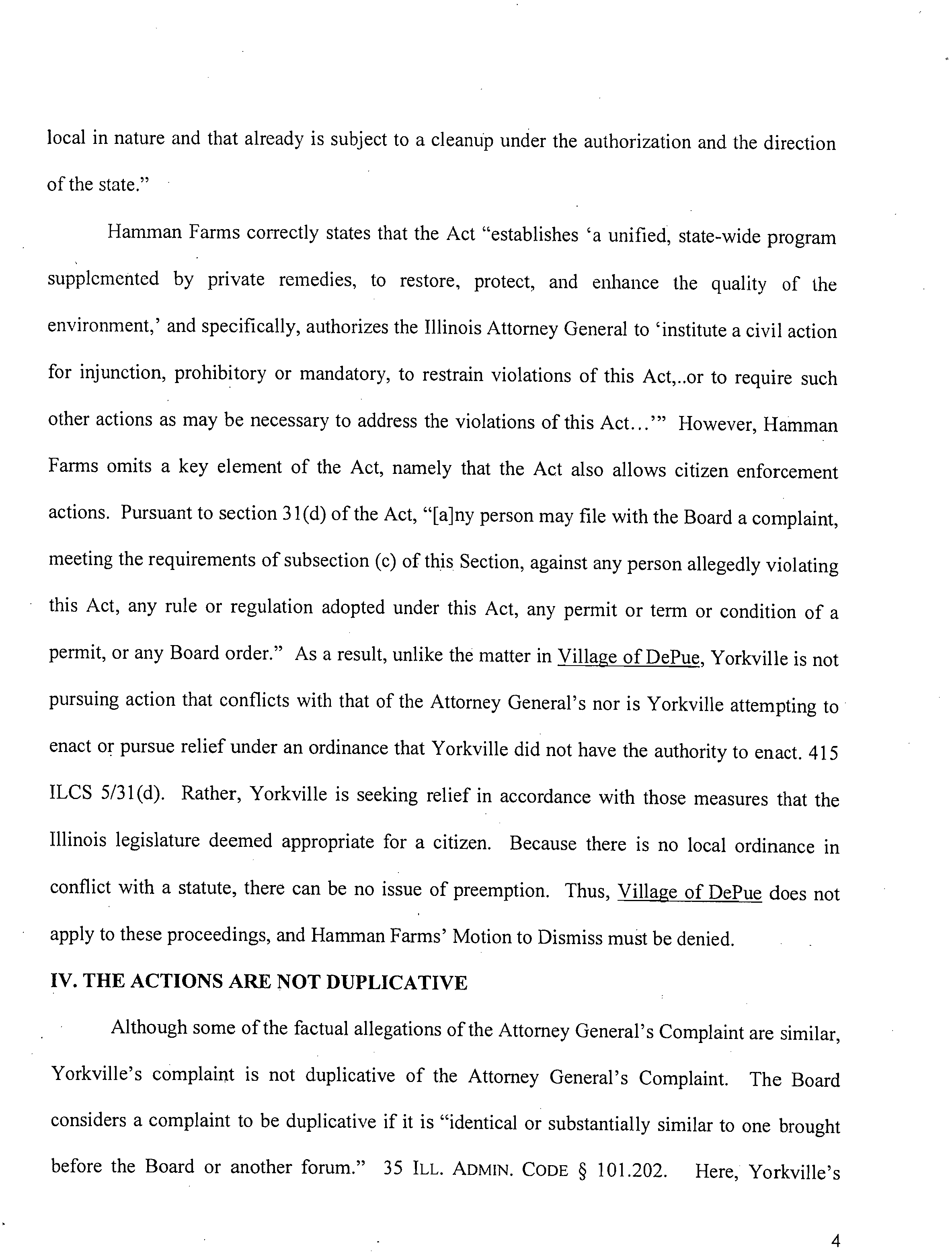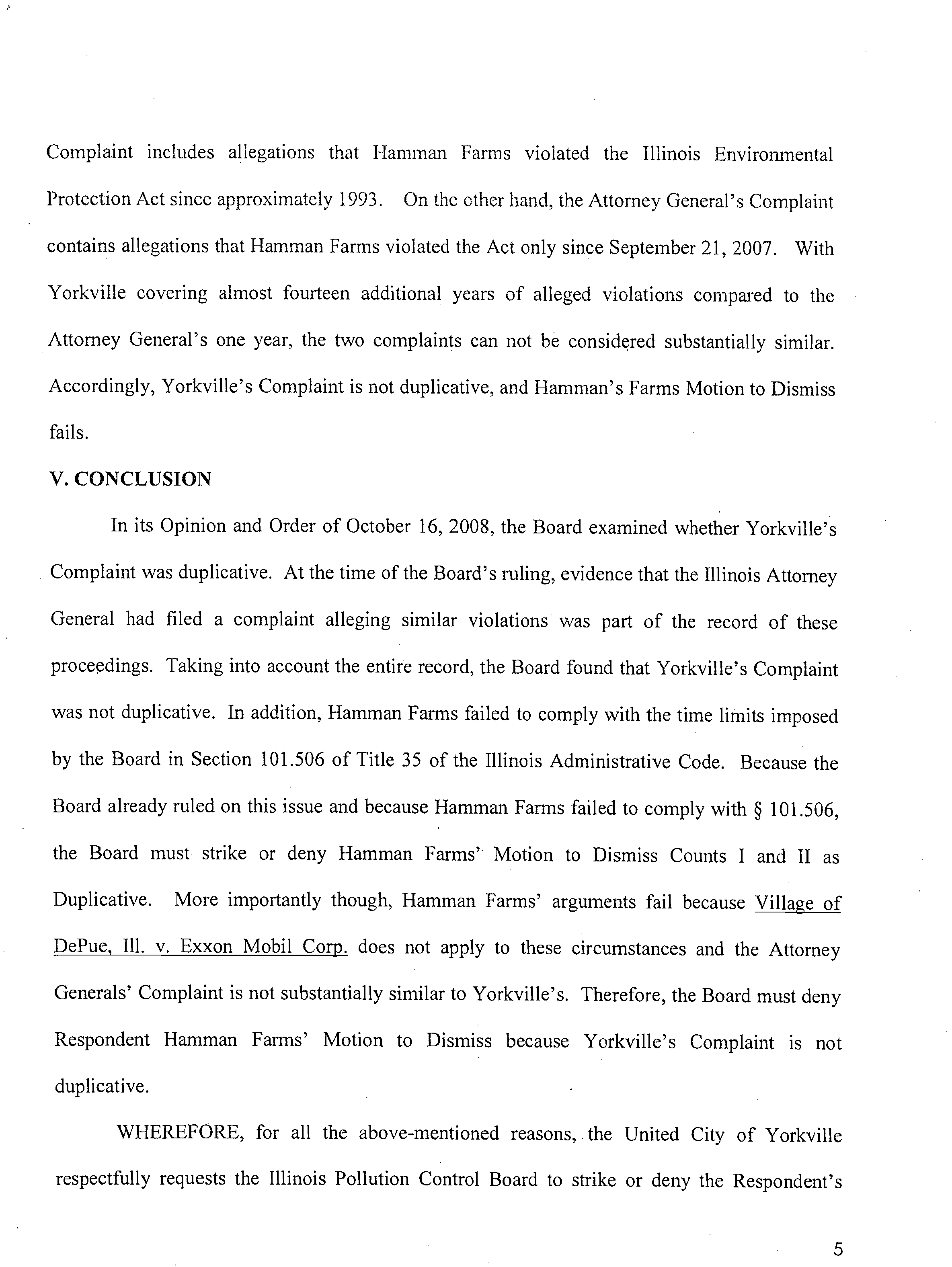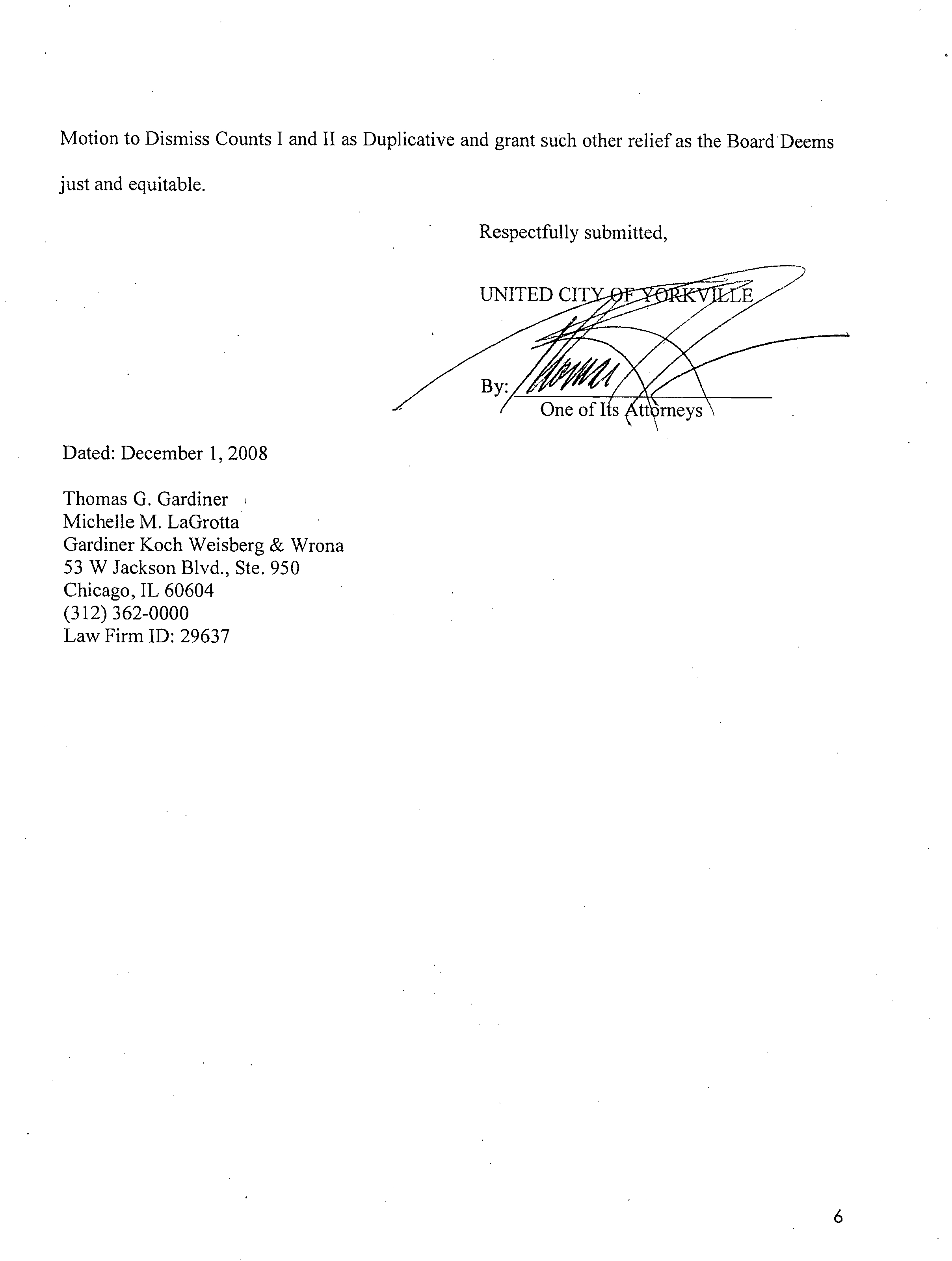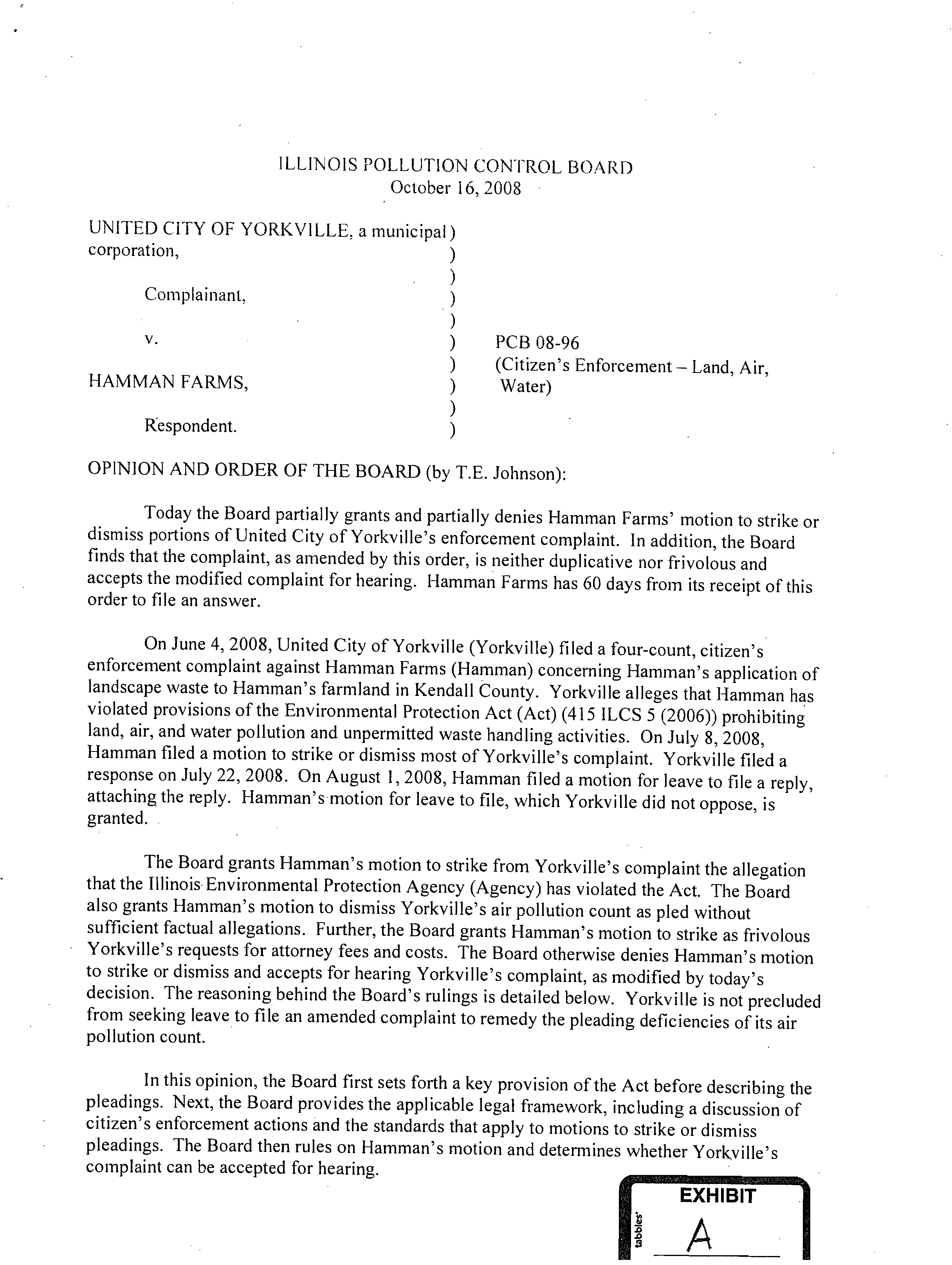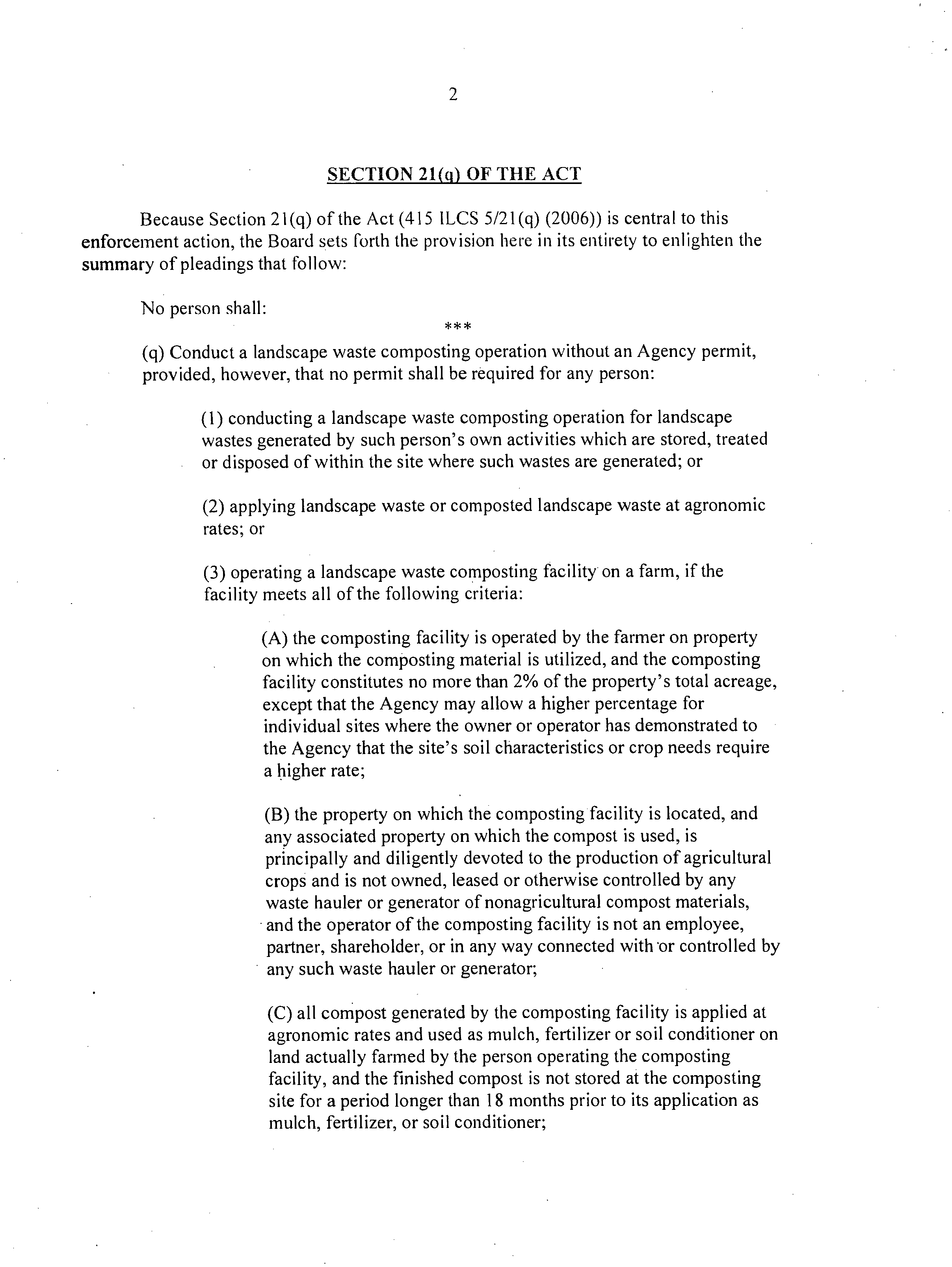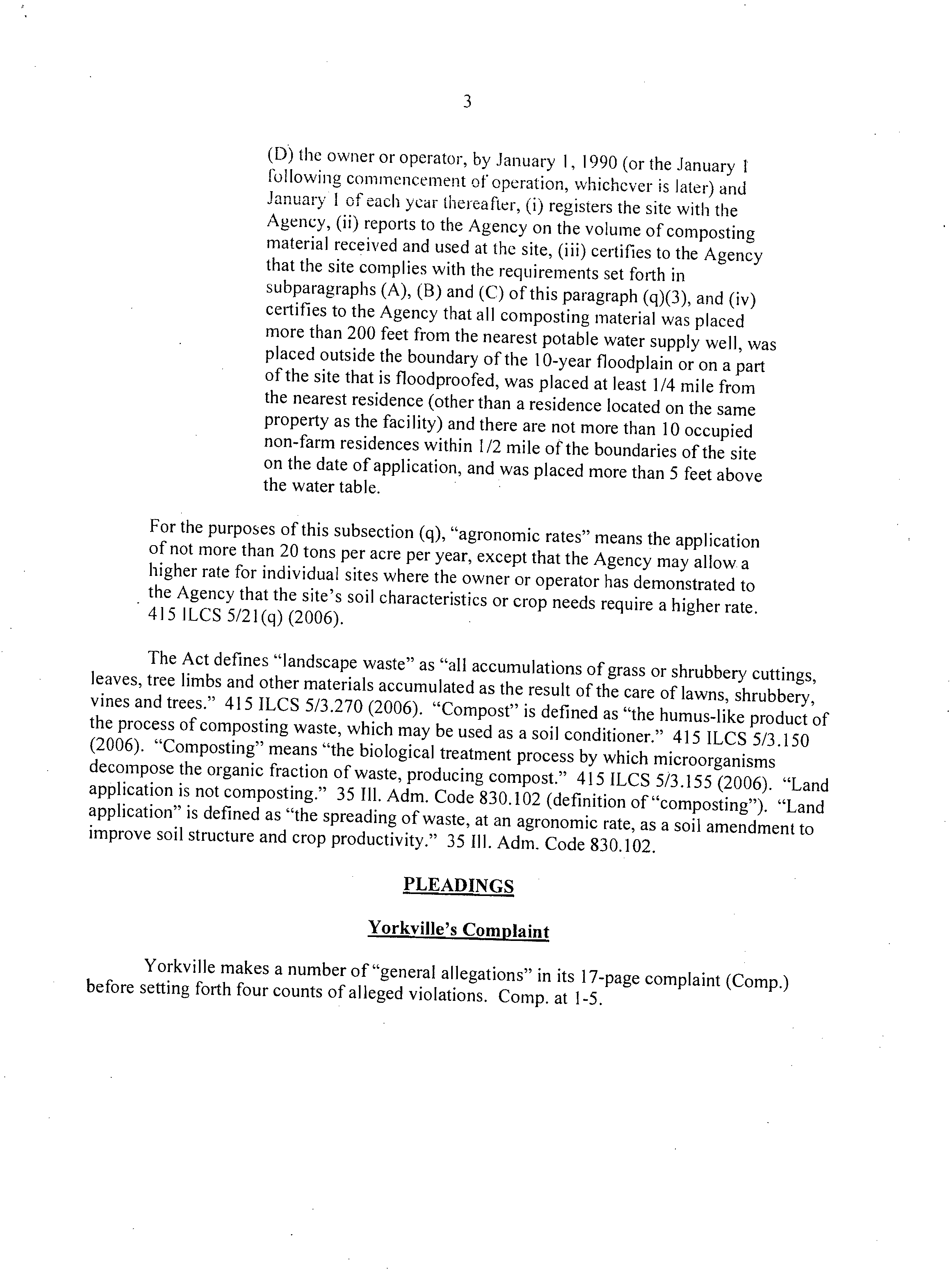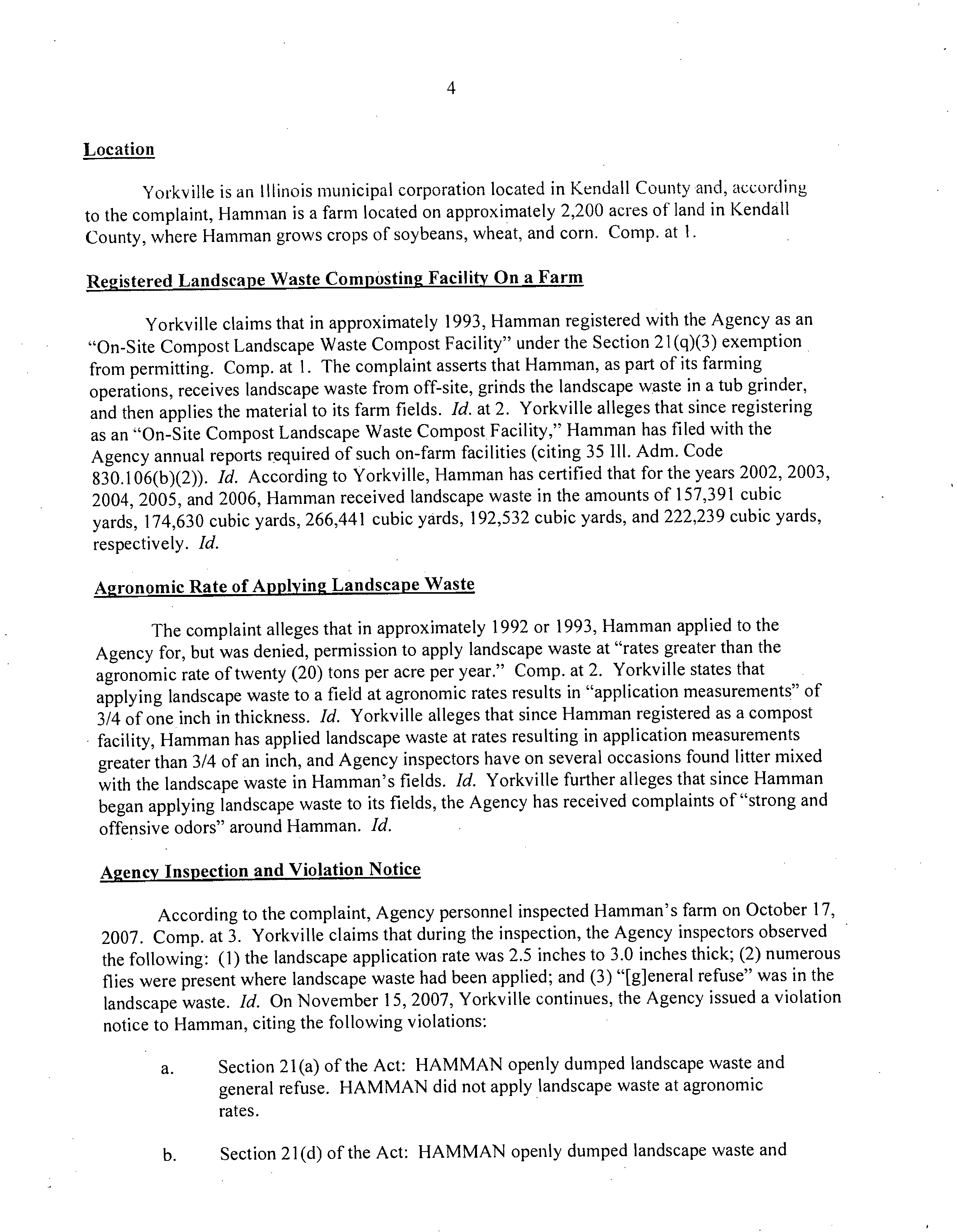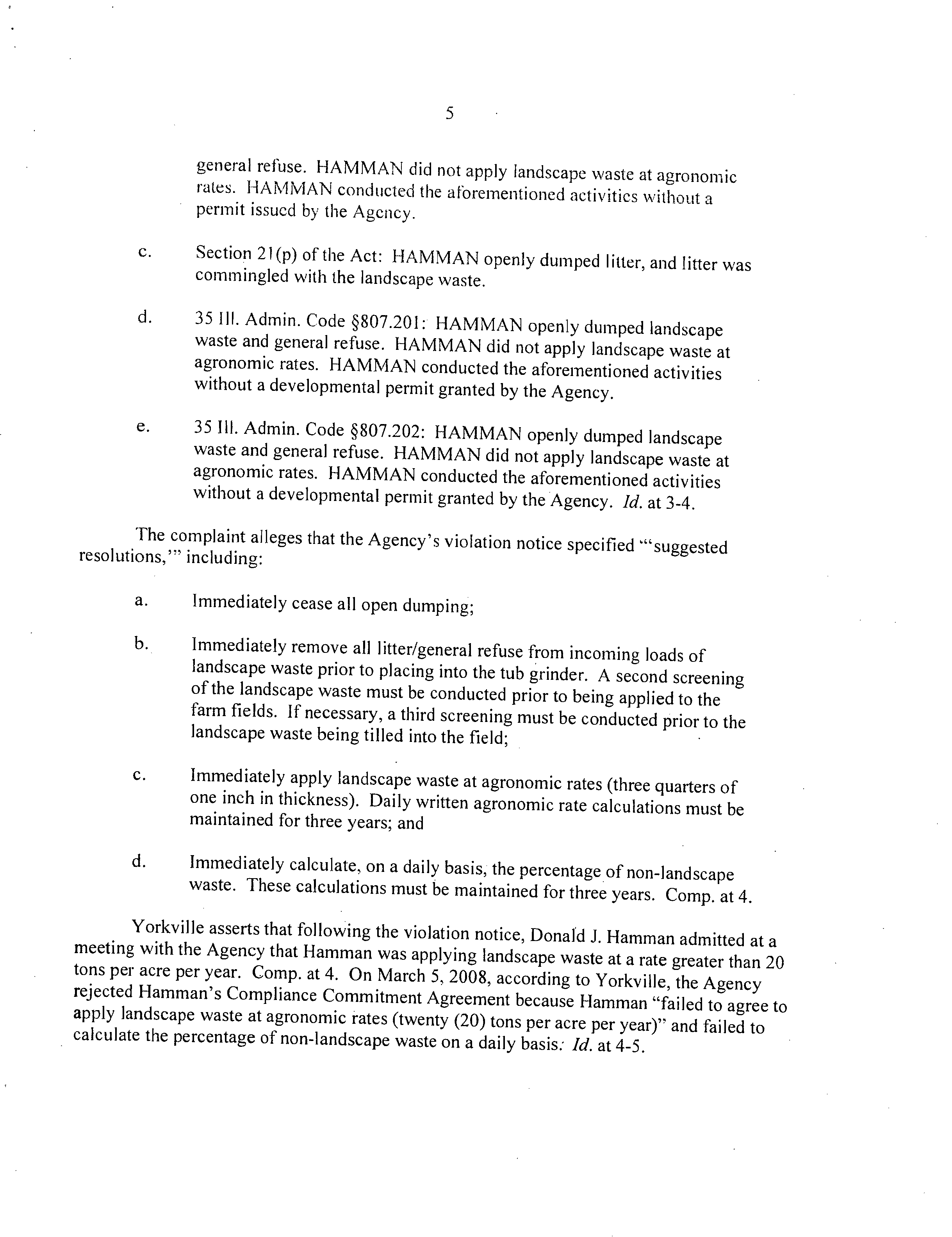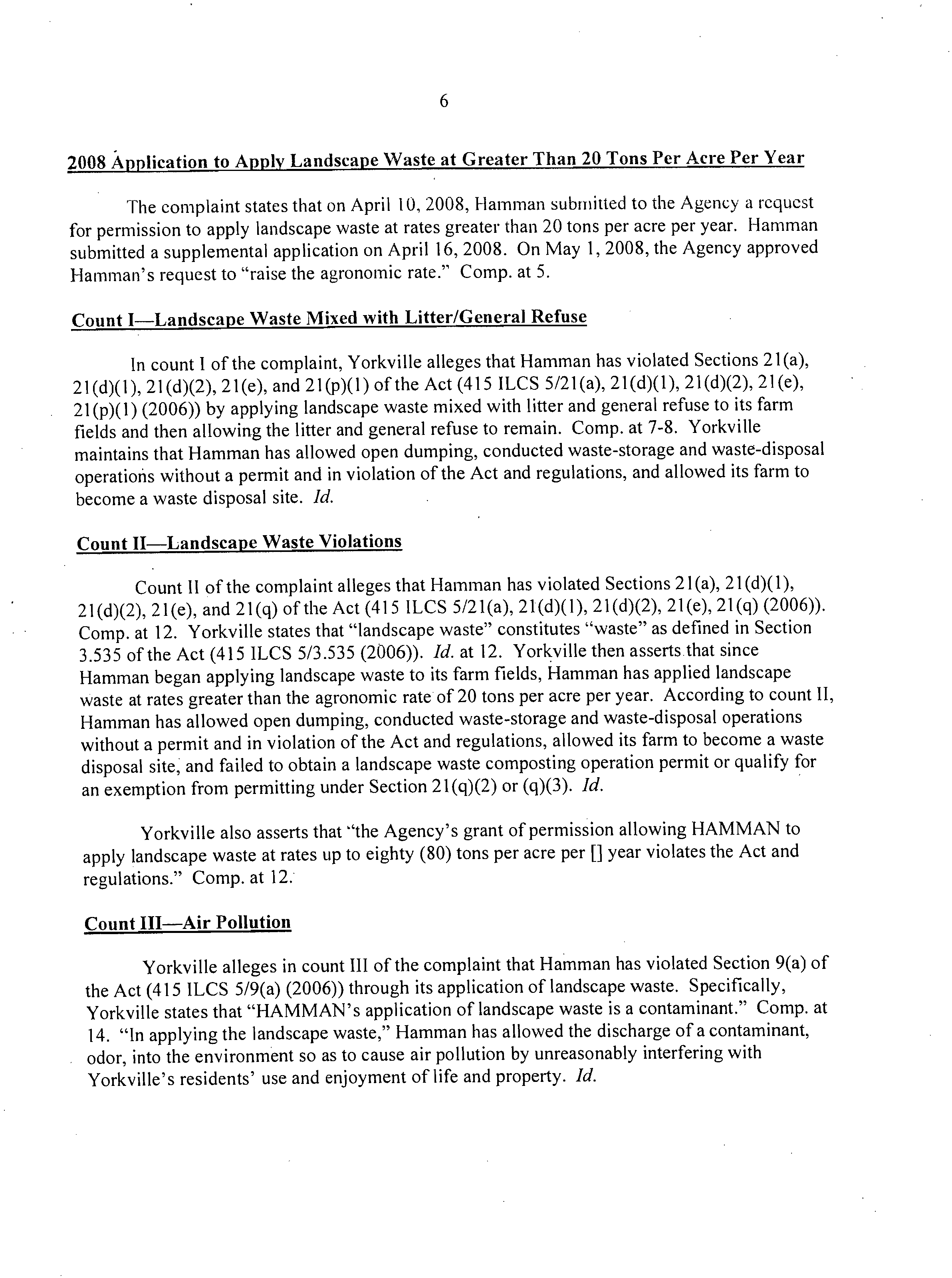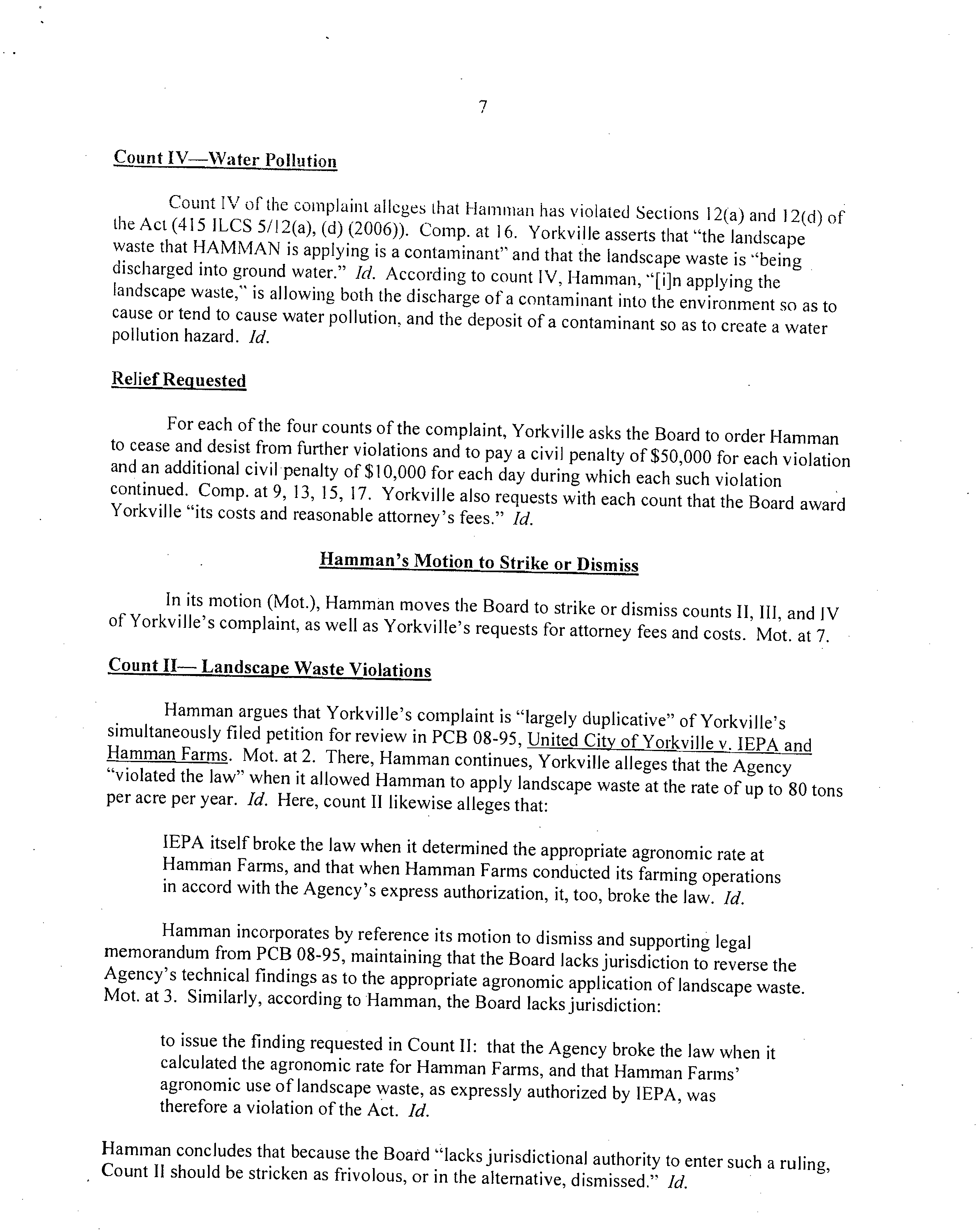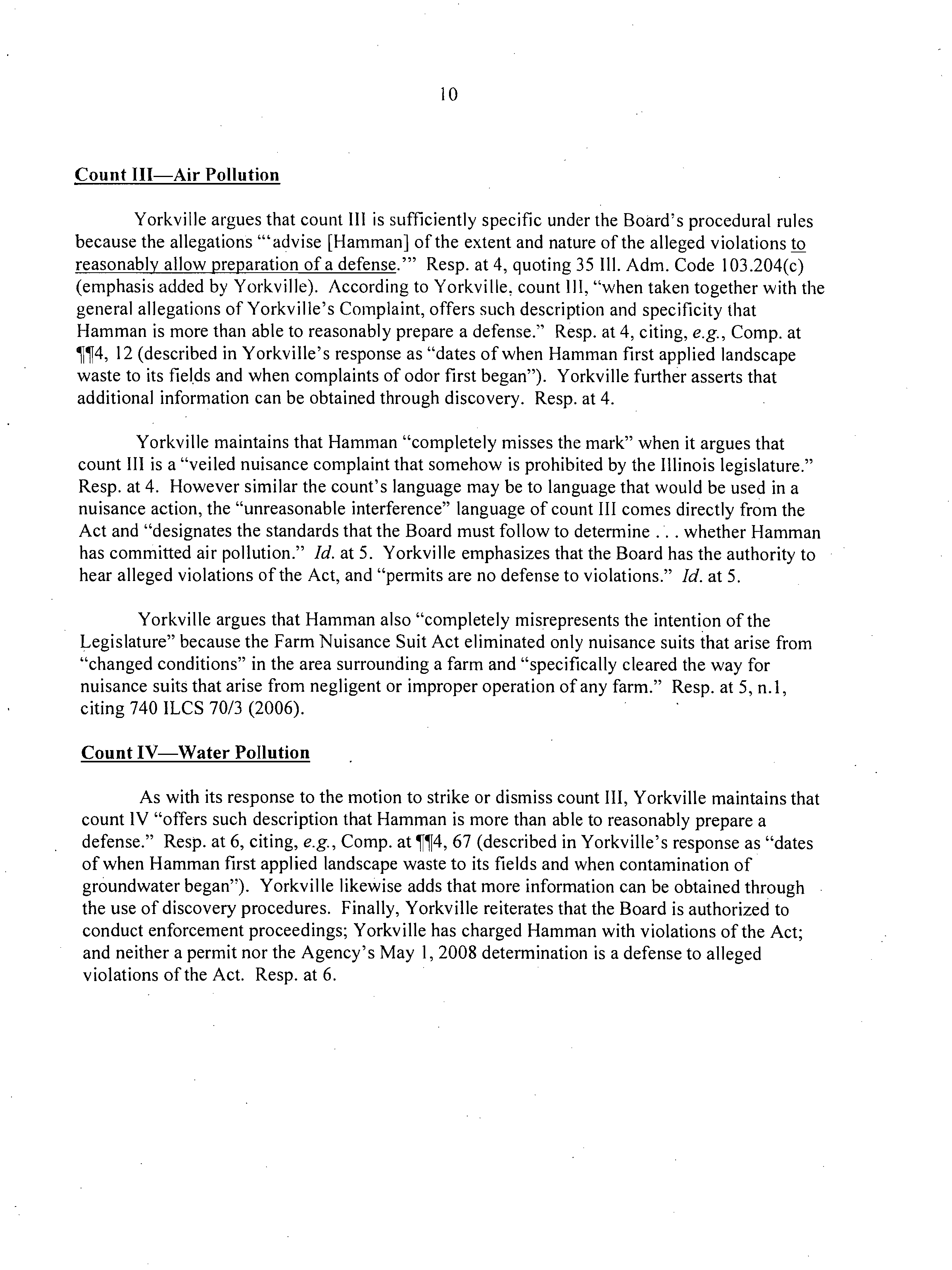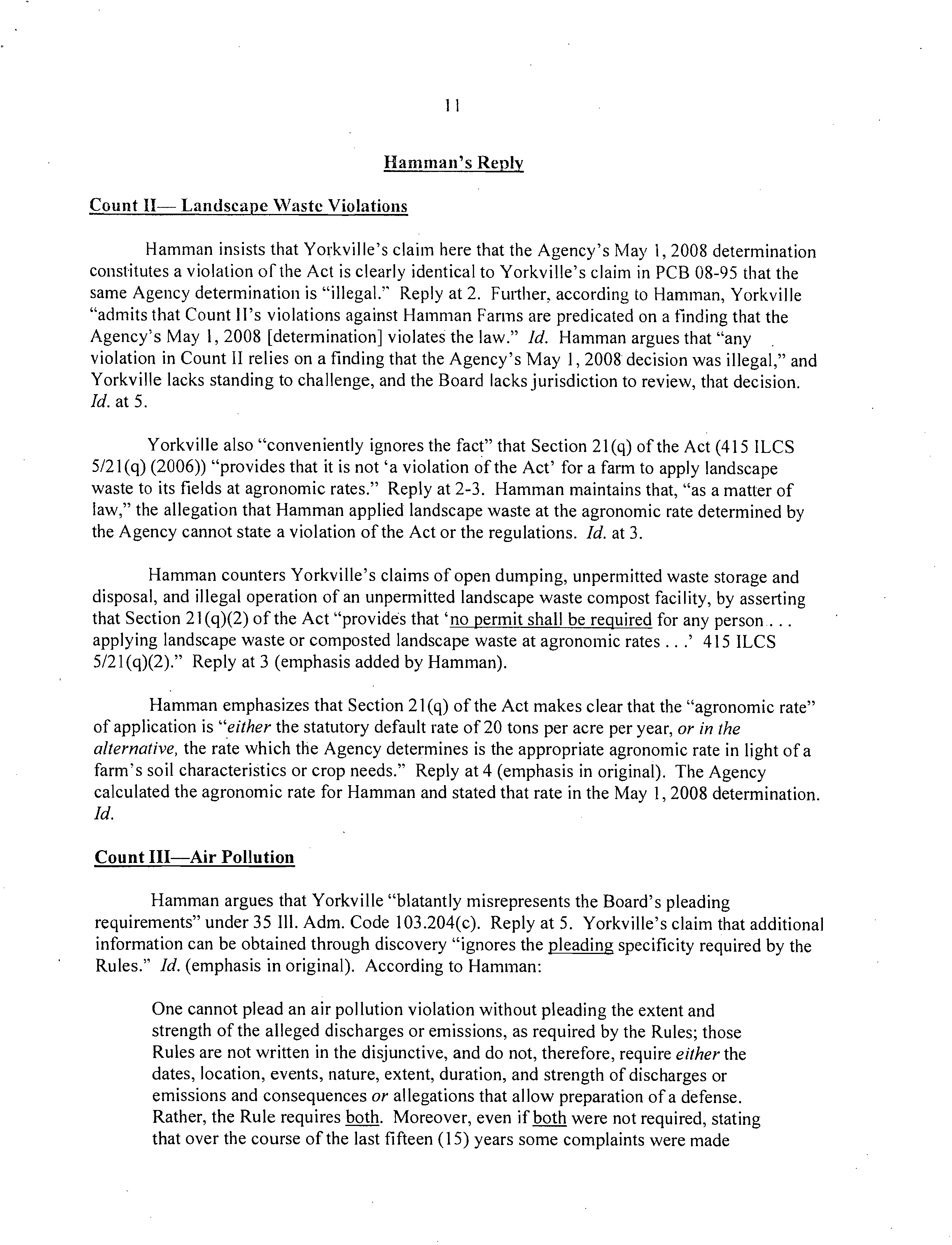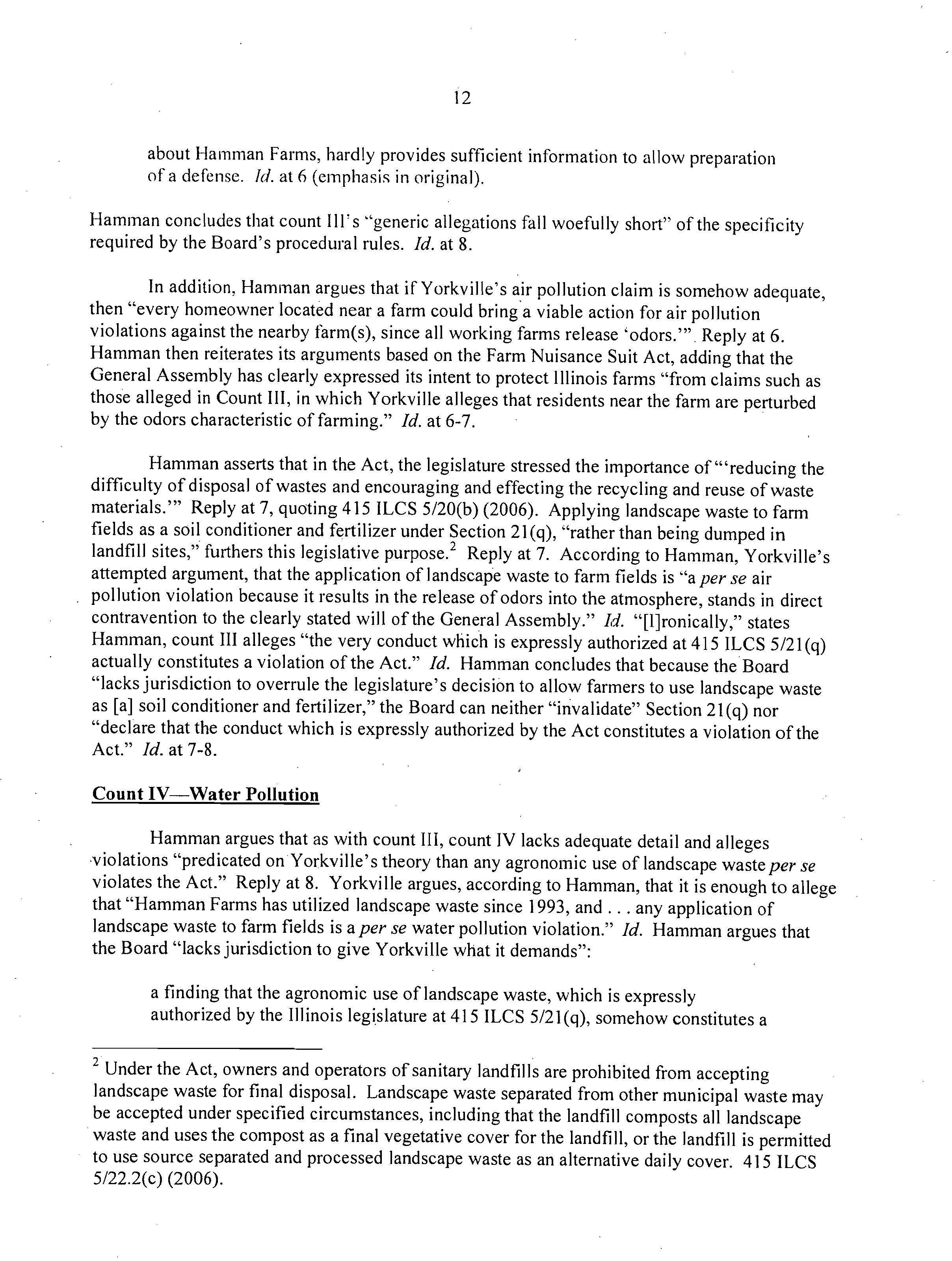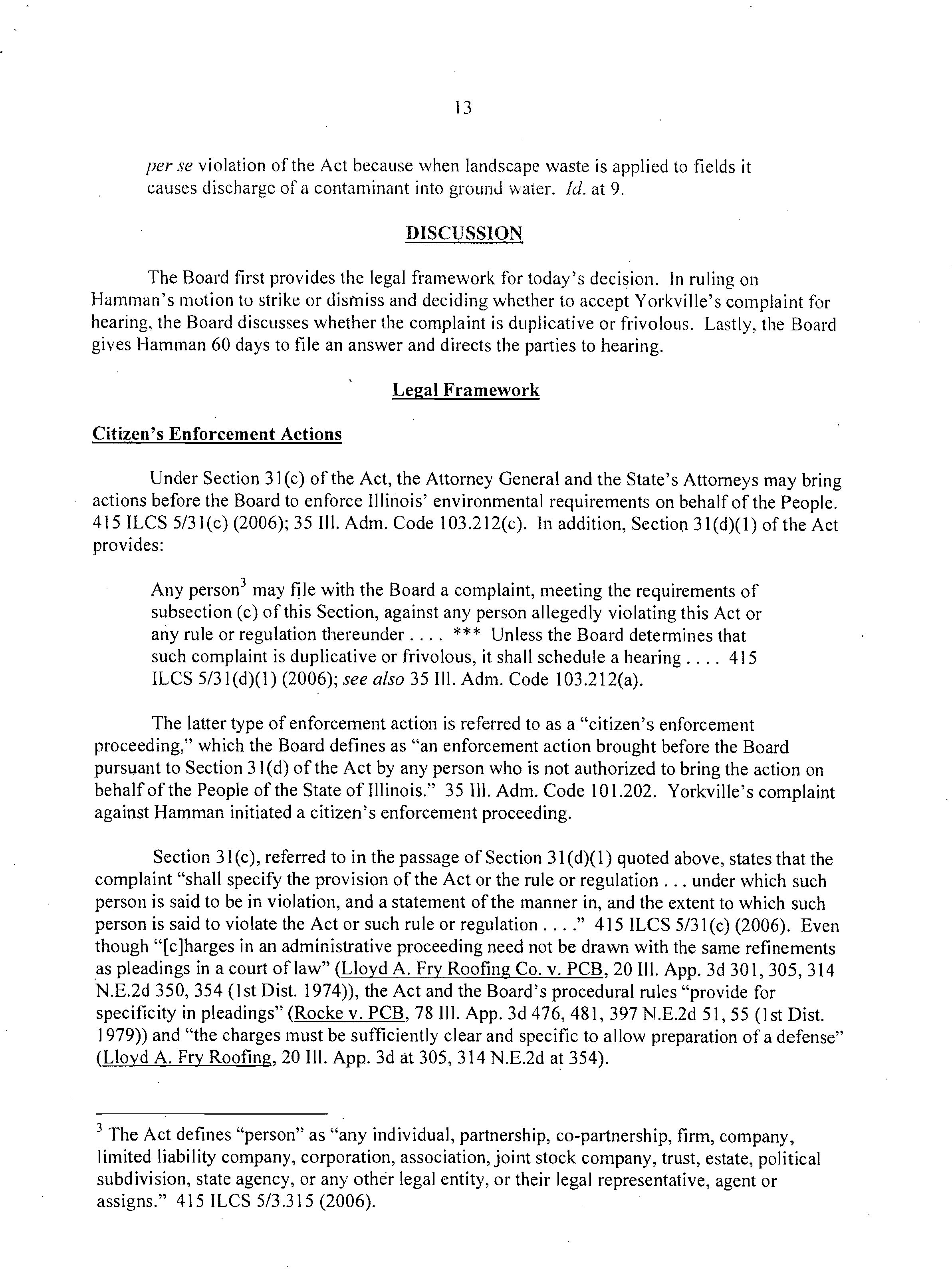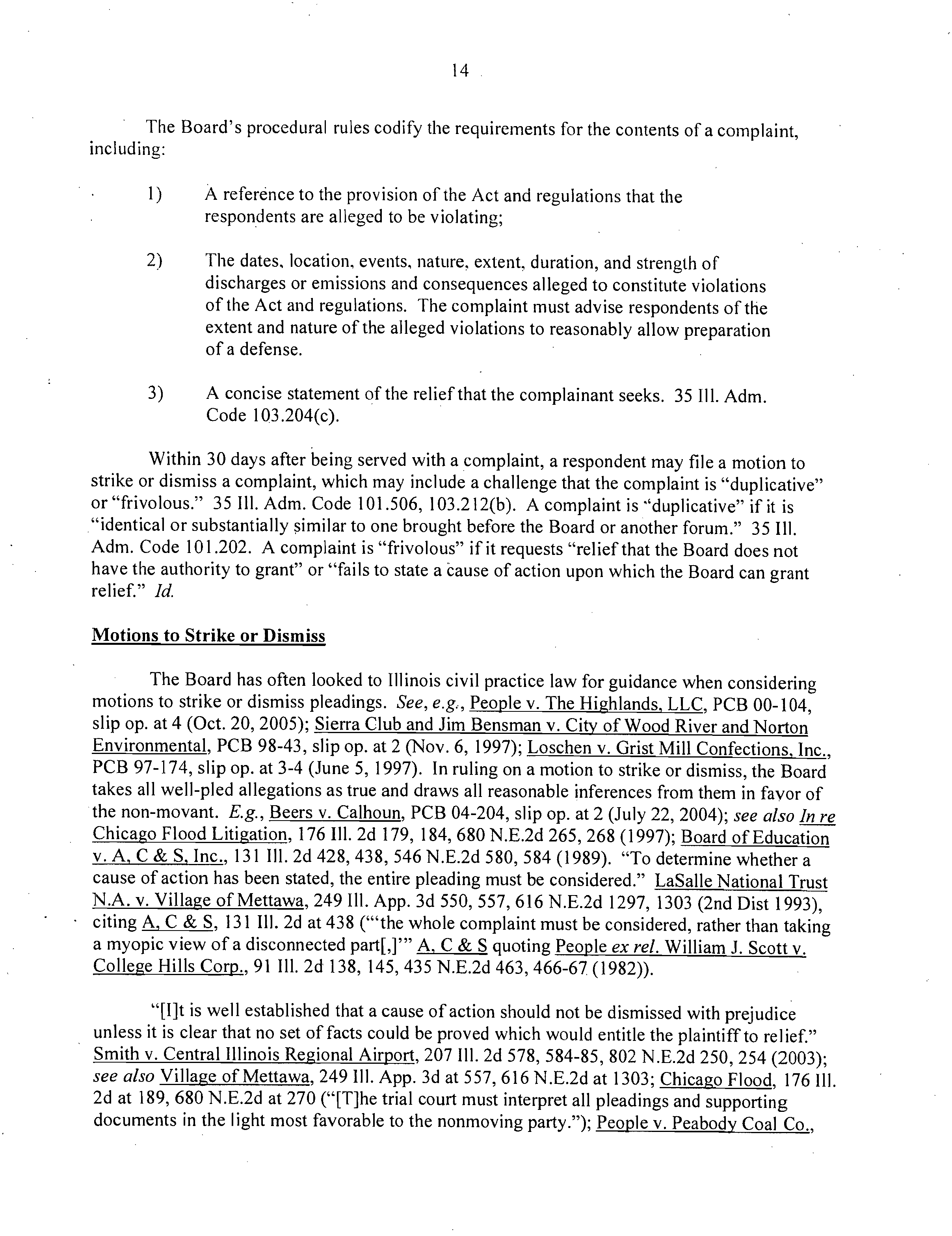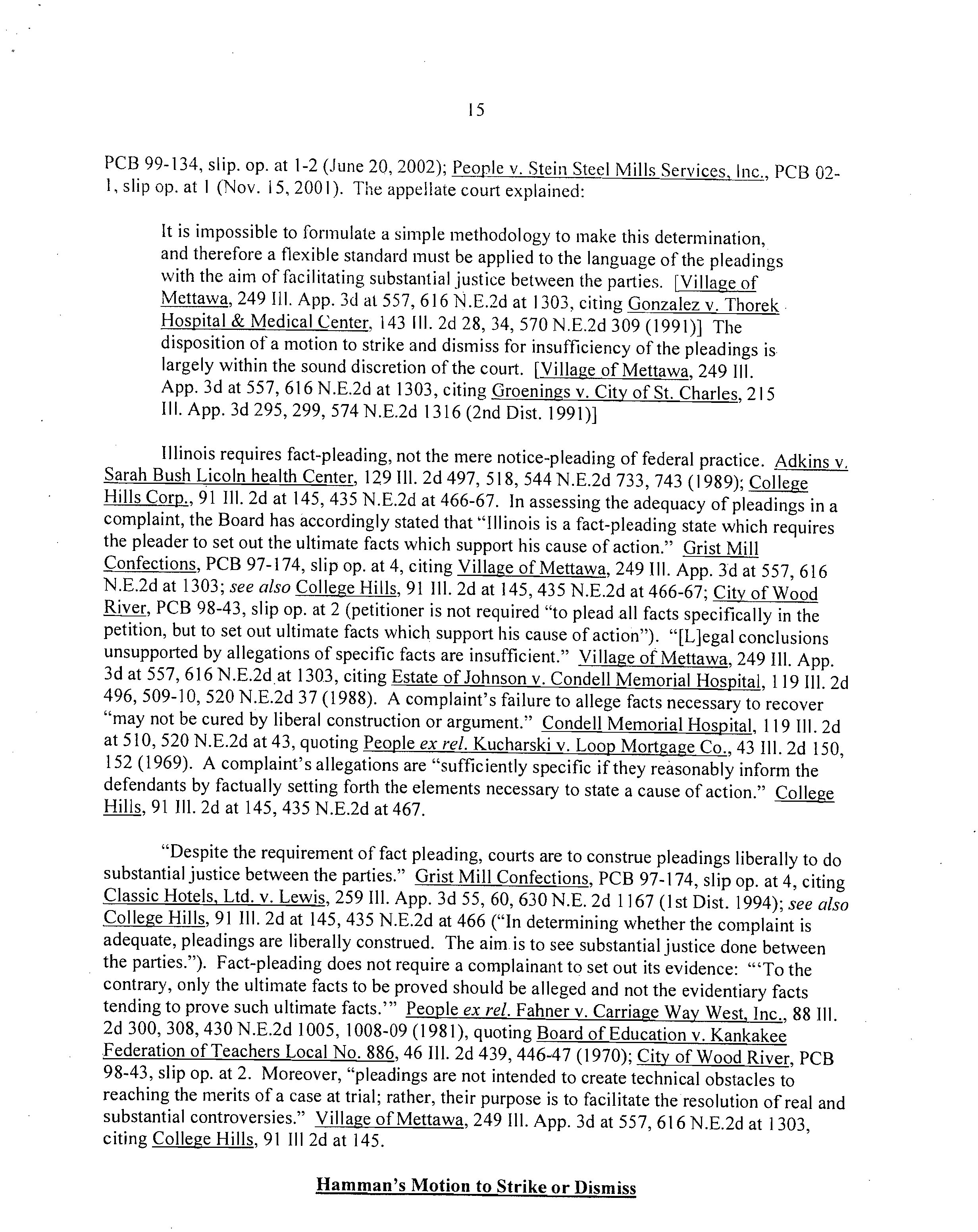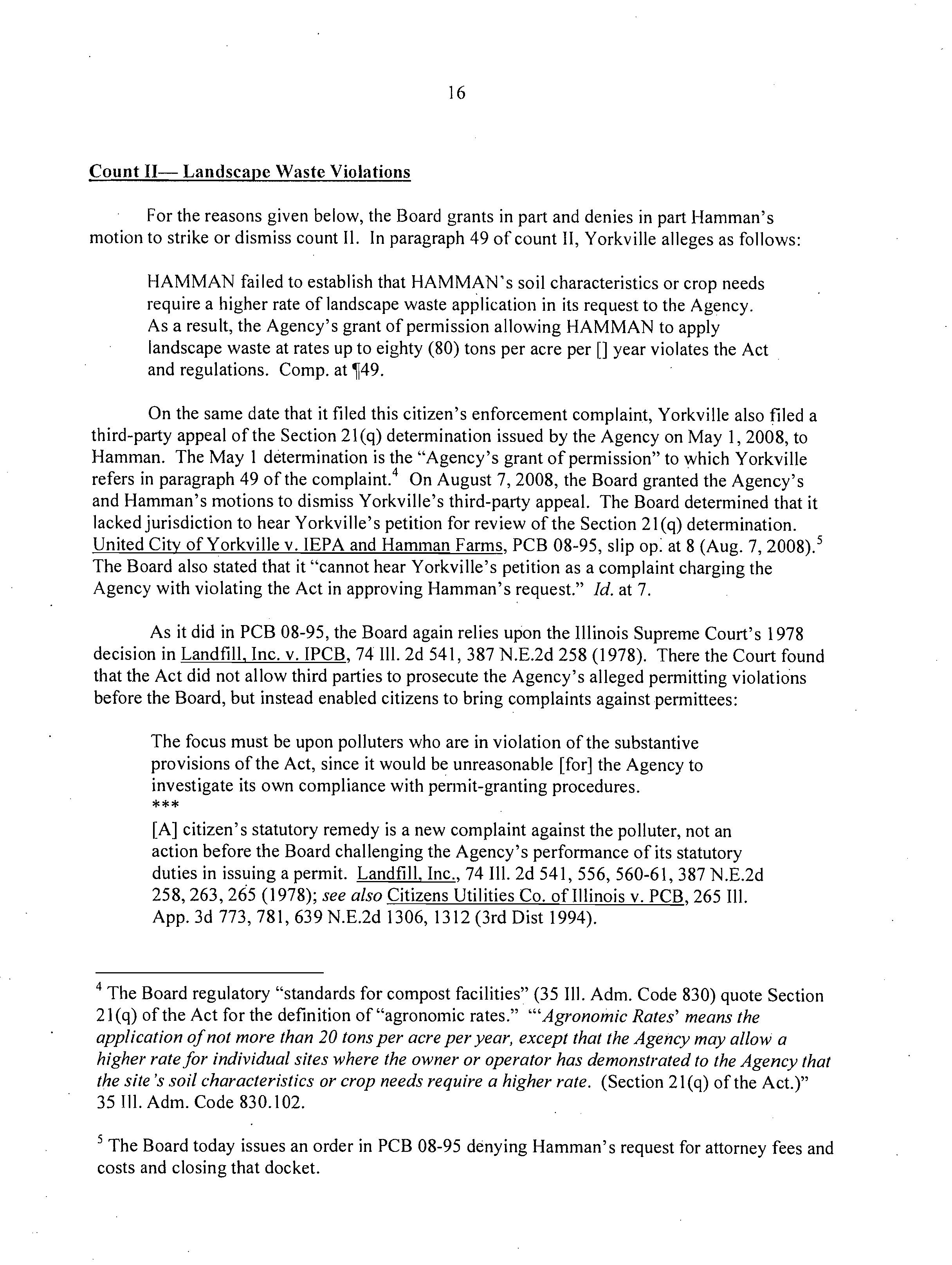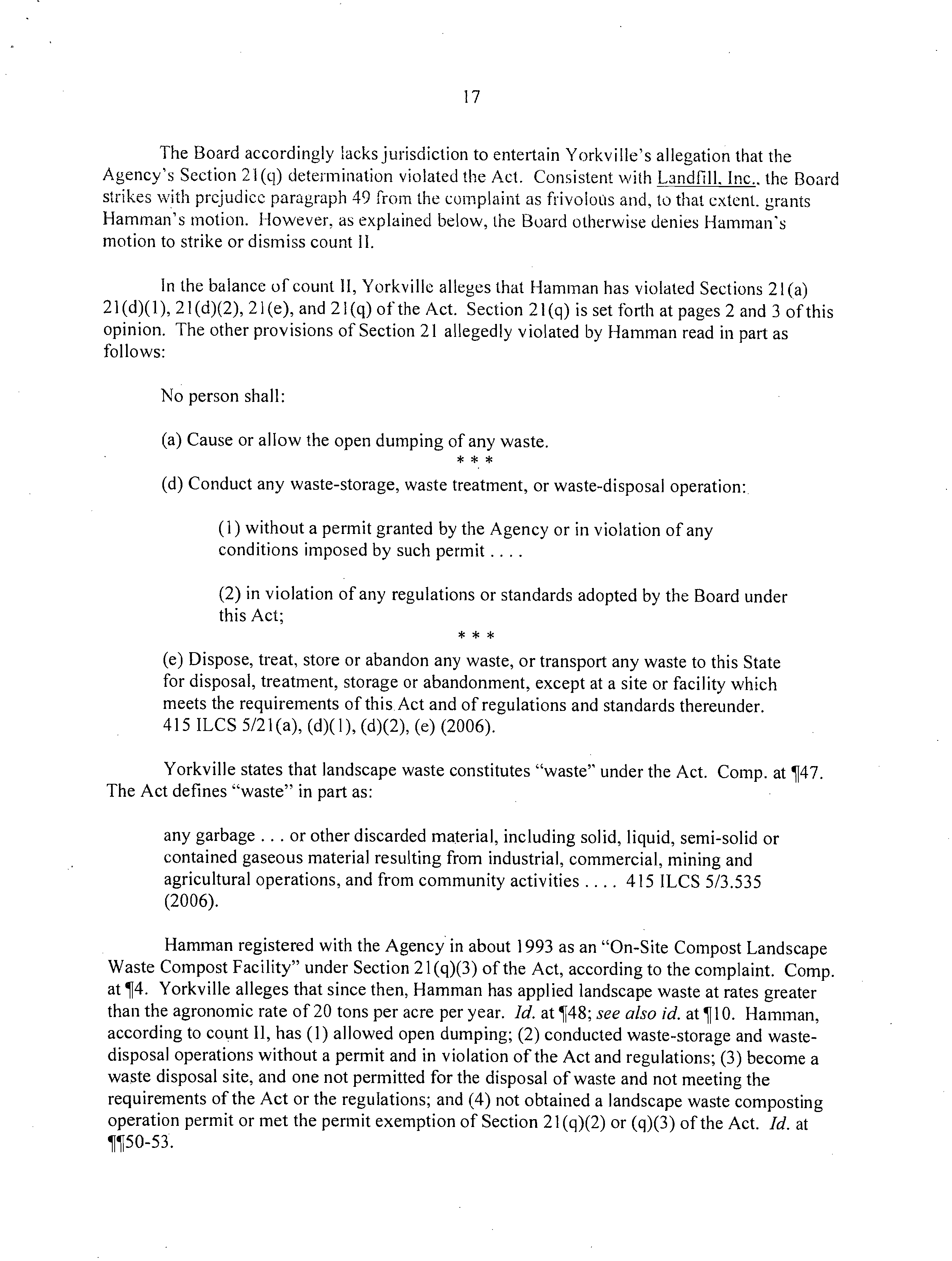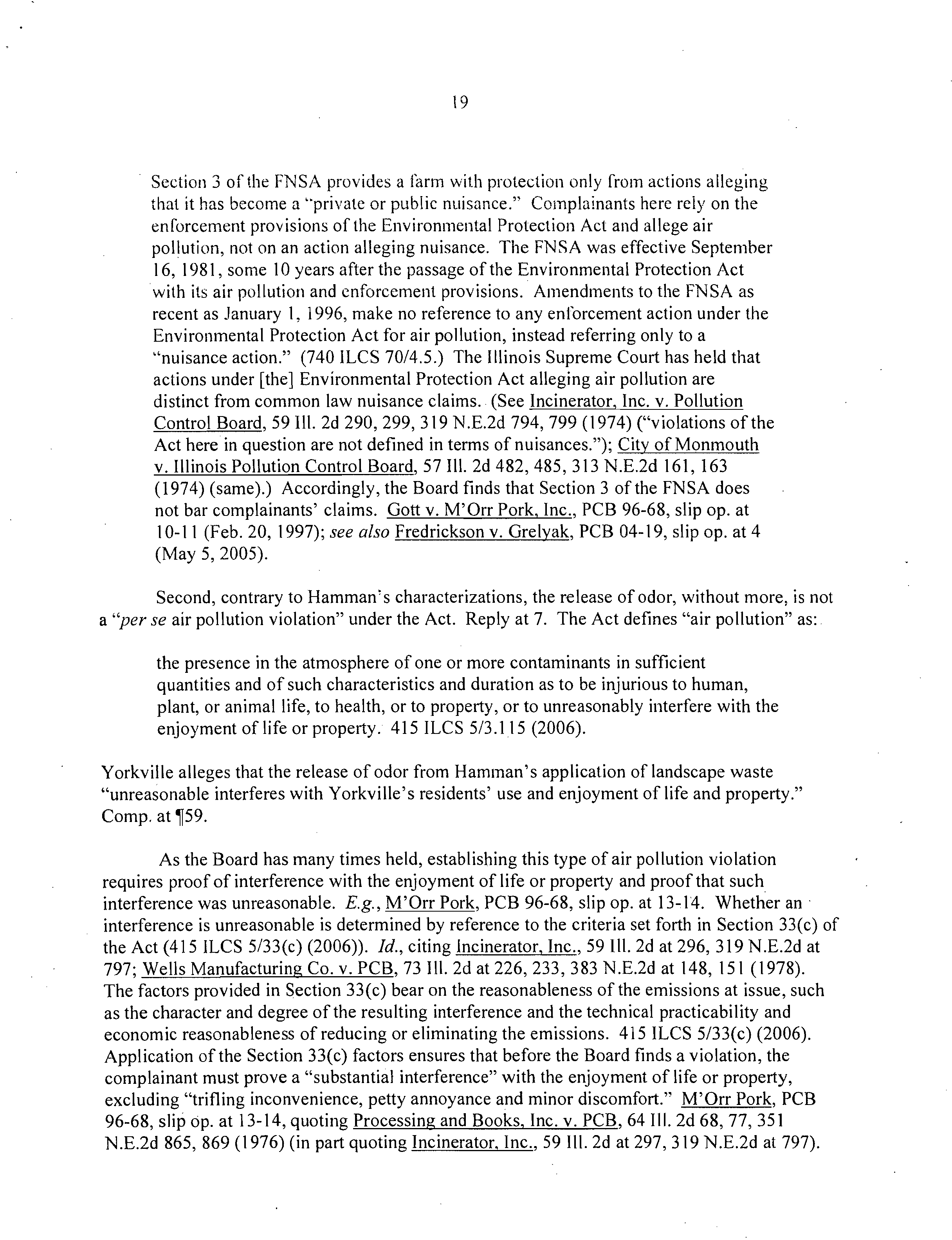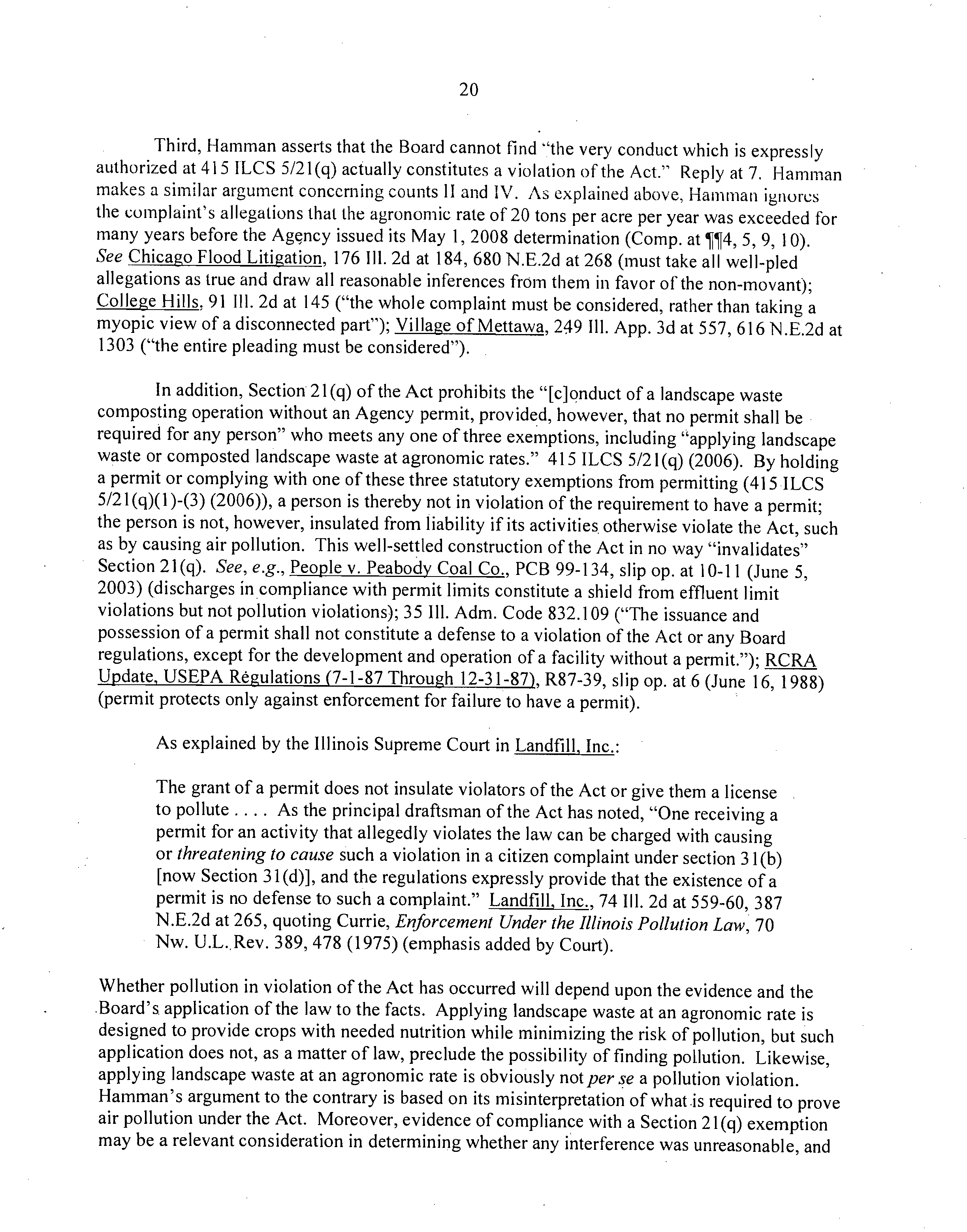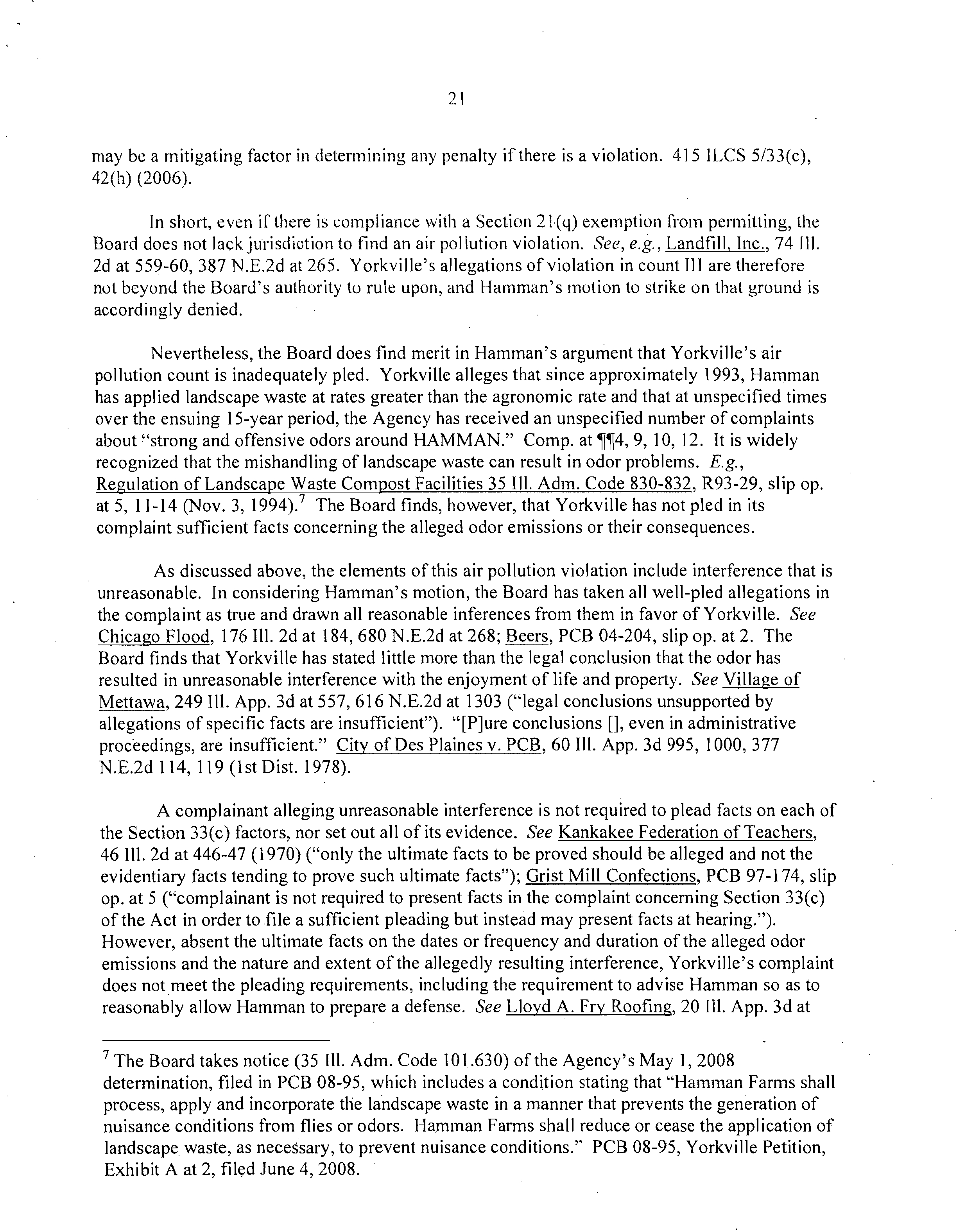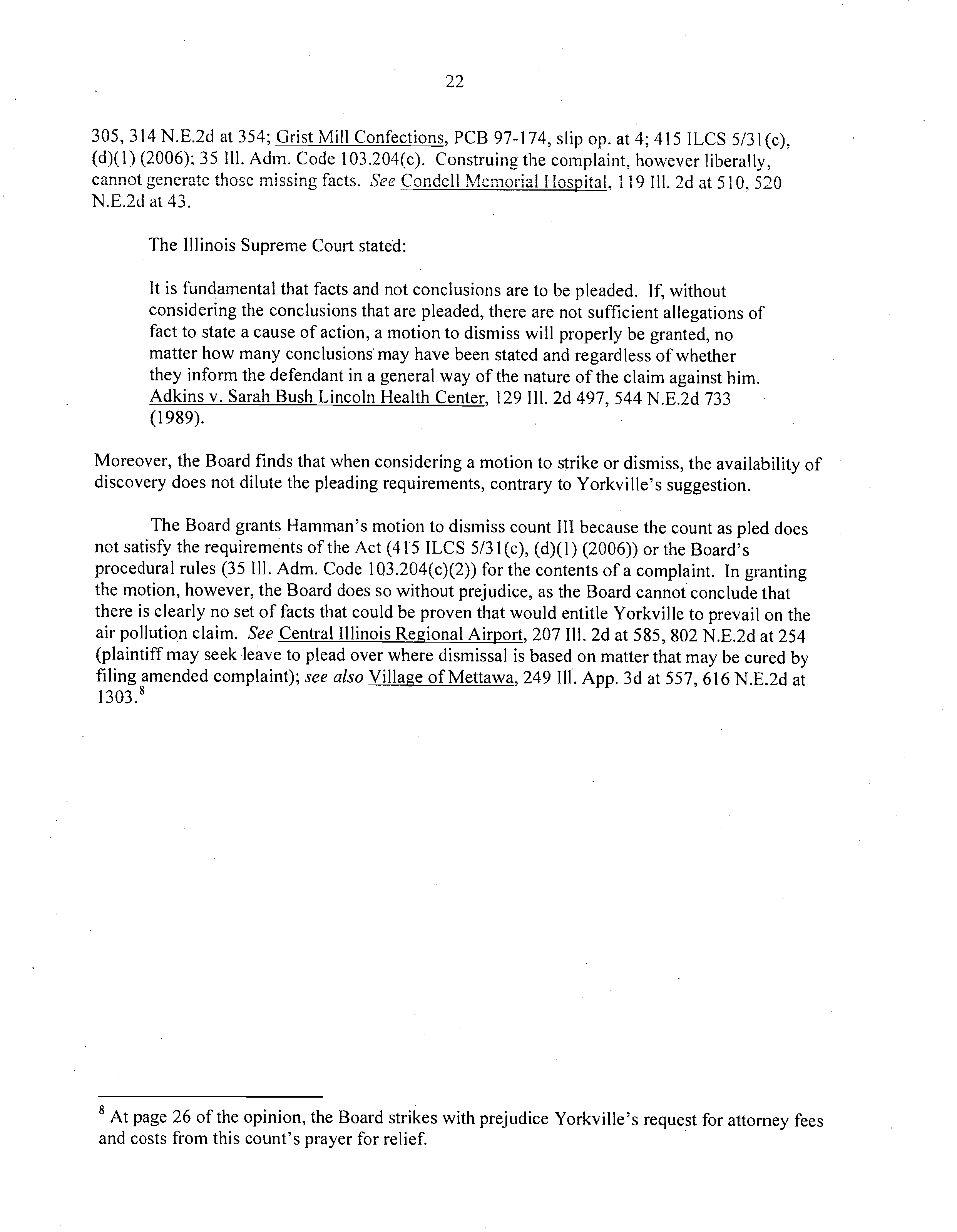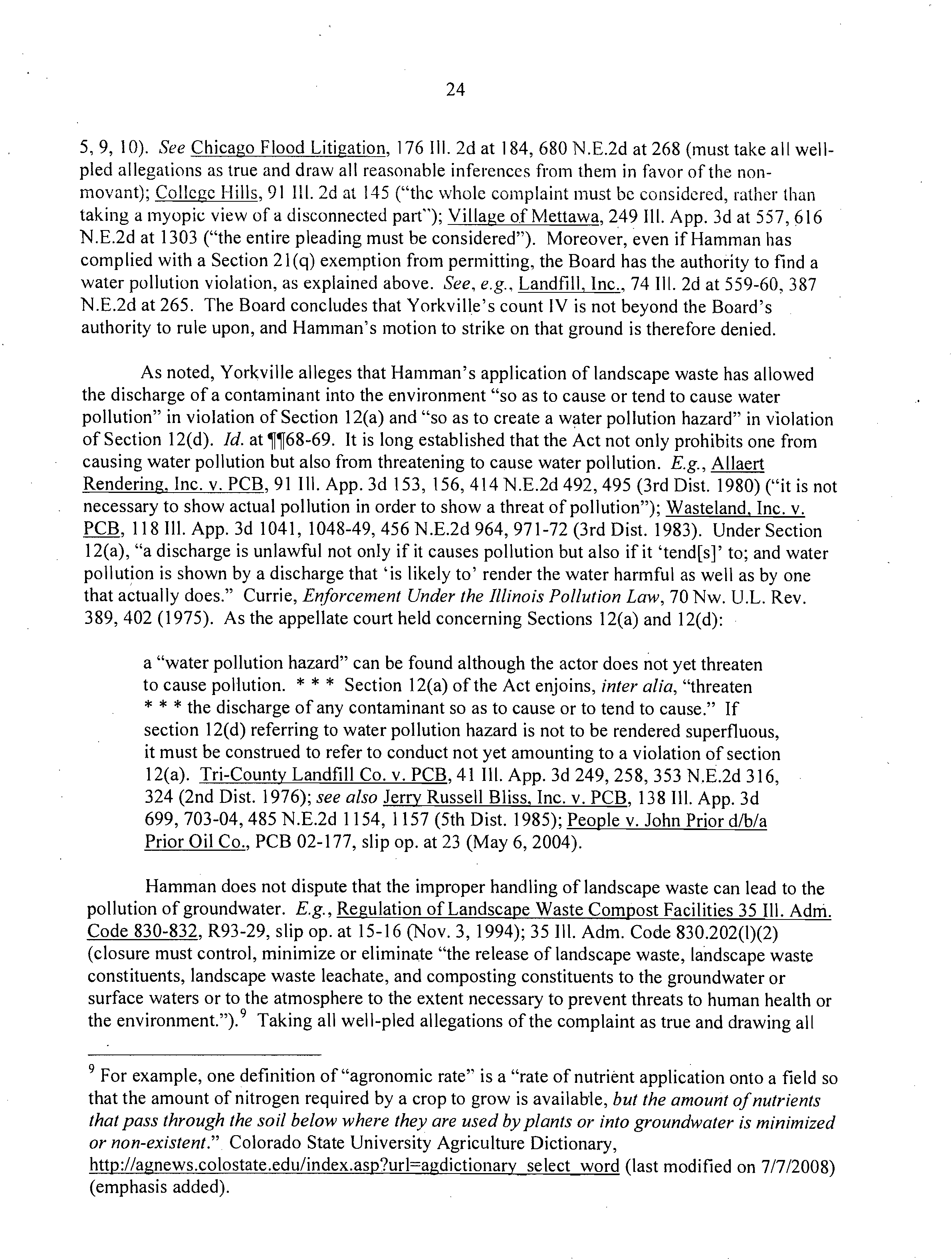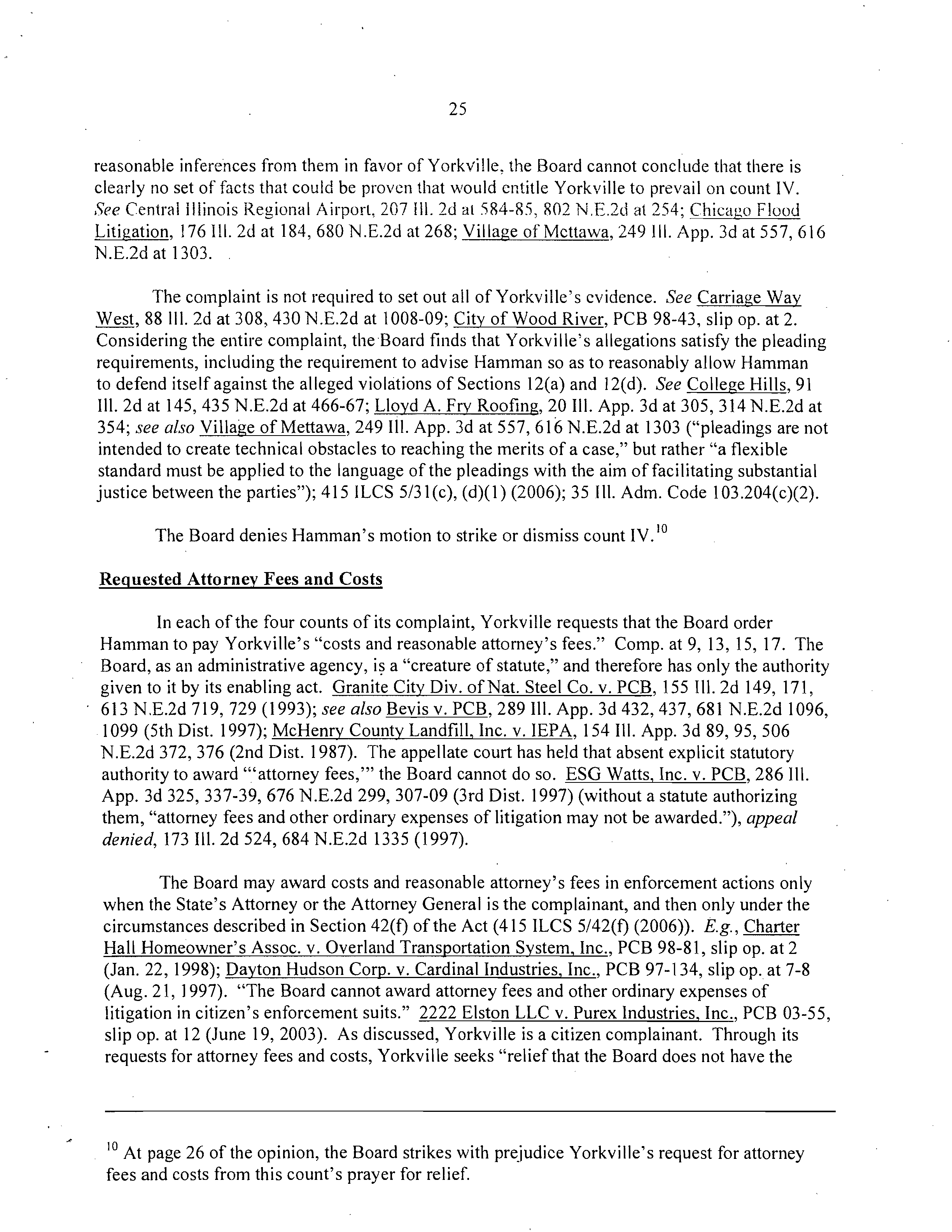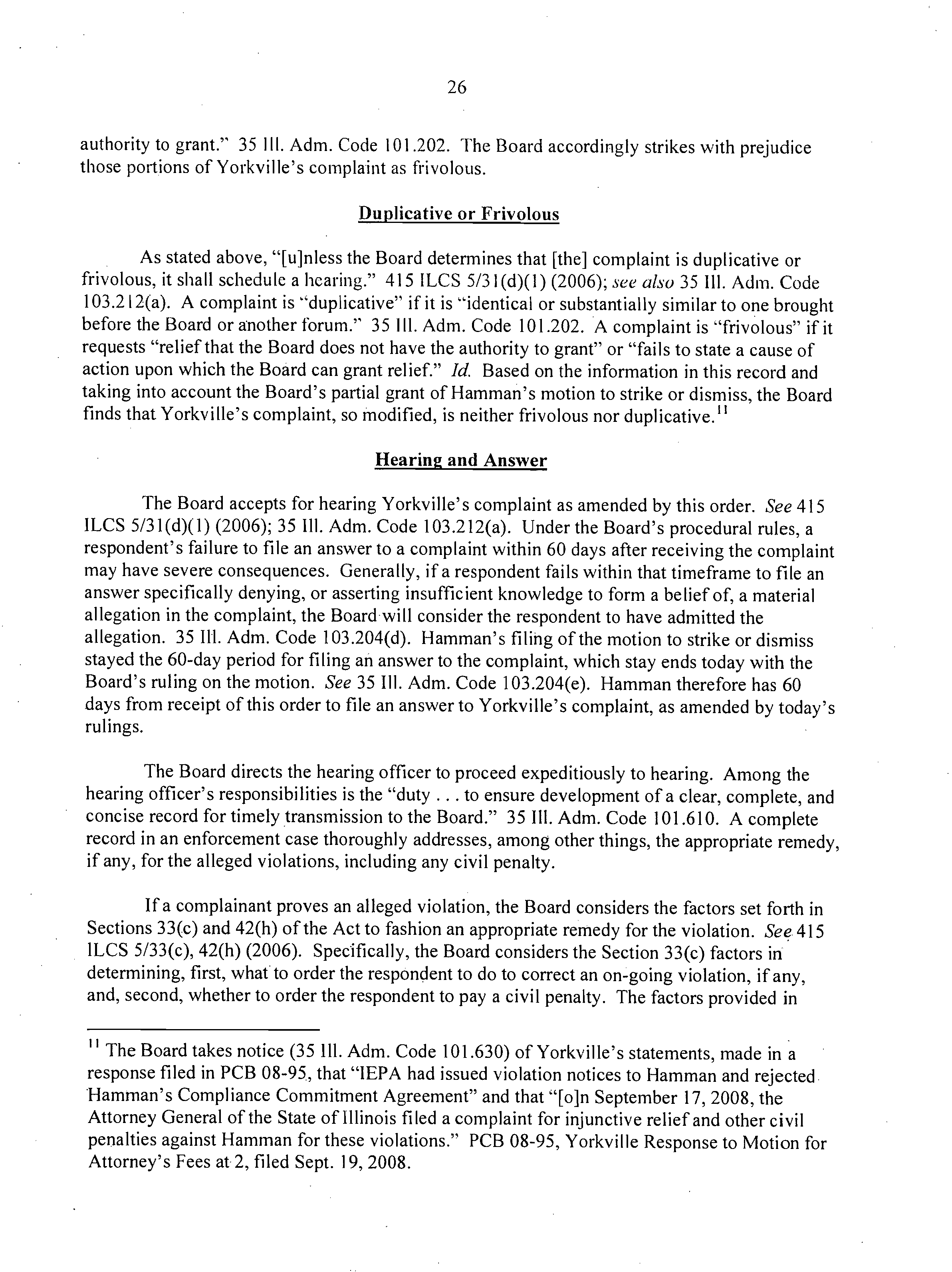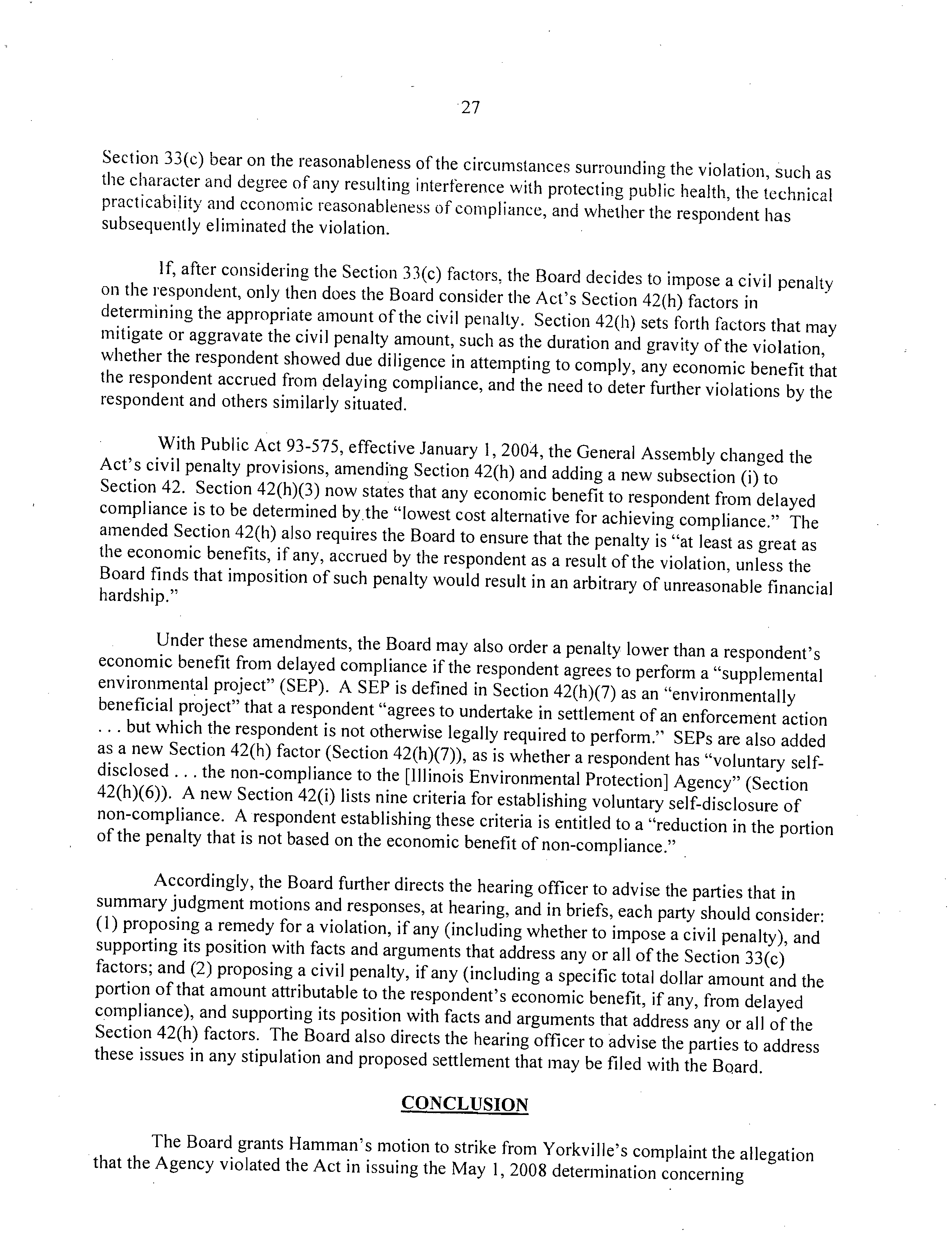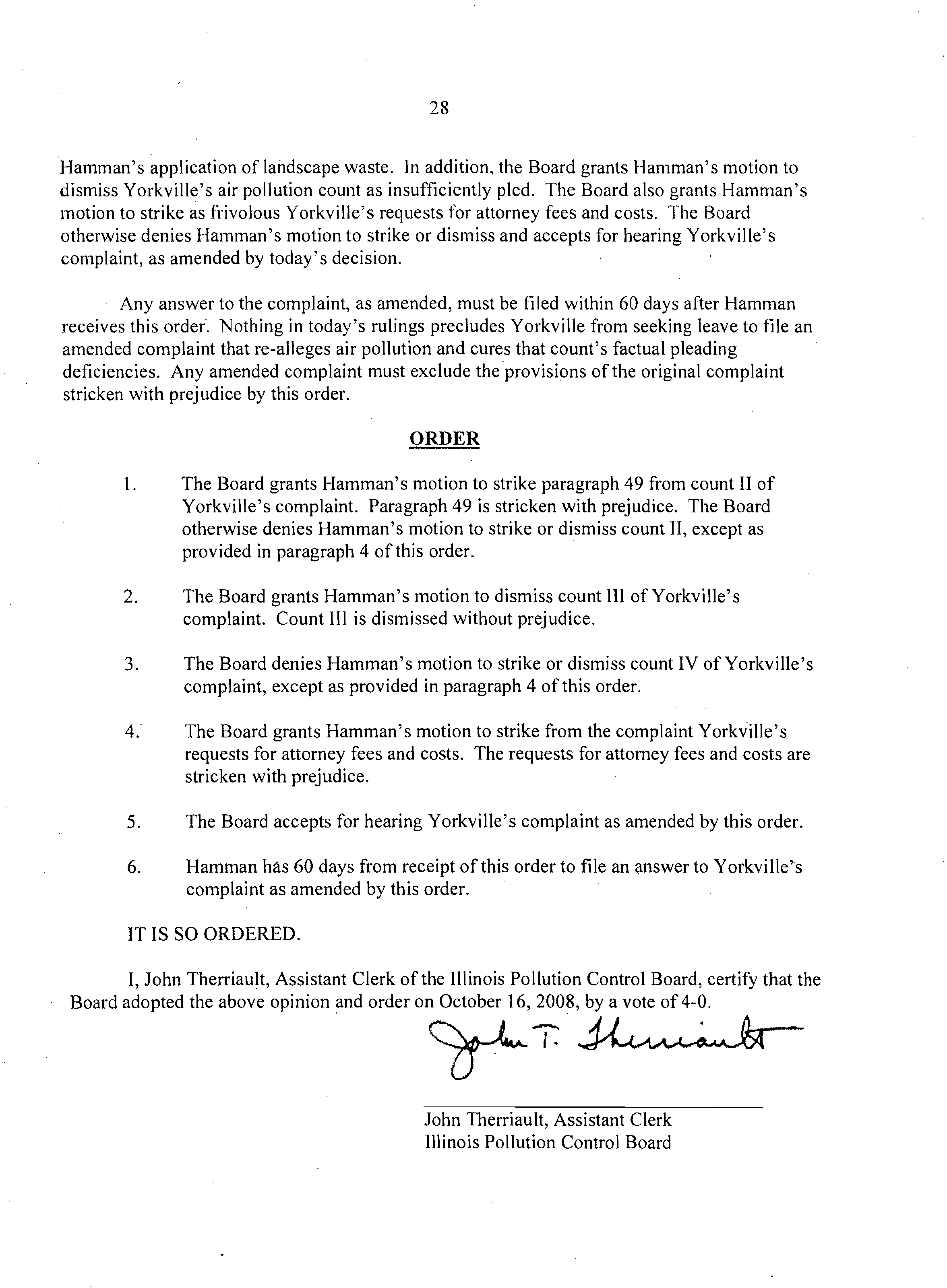BEFORE
THE
ILLINOIS
UNITED
CITY
OF
YORKVILLE,
A
MUNICIPAL
CORPORATION,
Petitioner,
V.
ILLINOIS
ENVIRONMENTAL
PROTECTION
AGENCY,
and
HAMMAN
FARMS,
Respondents.
CEVE’
CLERKS
OFFICE
POLLUTION
CONTROL
BOARD
DEC
Ol
2008
)
Pollution
STATE
OF
Control
ILLINOIS
Board
)
)
PCB
No.
08-96
)
Enforcement-Land,
Air, Water
)
)
)
)
)
NOTICE
OF FILING
TO: SEE
PERSONS
ON ATTACHED
SERVICE
LIST
PLEASE
TAKE
NOTICE
that I have
today
filed with
the
Office
of Clerk
of
the
Illinois
Pollution
Control
Board,
an original
and nine copies
each
of YORKVILLE’S
RESPONSE
TO
RESPONDENT’S
MOTION
TO
DISMISS
COUNTS
I AND
II
AS DUPLICATIVE,
copies
of which
are
herewith
served
upon
you.
Dated: December
1,
2008
Thomas G.
Gardiner
Michelle
M. LaGrotta
GARDINER
KOCH
&
WEISBERG
53 W
Jackson
Blvd.,
Ste. 950
Chicago,
IL 60604
(312)
362-0000
Atty
ID:
29637
Respectfully
submitted,
UNITED
THIS FILING
IS SUBMITTED
ON RECYCLED
PAPER
CERTIFICATE
OF
SERVICE
I,
Michelle
M.
LaGrotta,
the
undersigned
certify
that
on December
1, 2008,
1 have
served
the
attached
YORKVILLE’S
RESPONSE
TO
RESPONDENT’S
MOTION
TO
DISMISS
COUNTS I AND
II AS
DUPLICATIVE,
upon:
Mr.
John
T. Therriault,
Assistant
Clerk
Illinois
Pollution
Control
Board
100
West
Randolph
Street
James
R. Thompson Center,
Suite
11-500
Chicago,
Illinois
60601-3218
(via
hand
delivery)
Bradley
P.
Halloran
Hearing
Officer
Illinois
Pollution
Control
Board
James
R.
Thompson
Center,
Ste.
22-500
100
W
Randolph
Street
Chicago,
IL
60601
(via
hand delivery)
Charles
F. Heisten
Nicola
A. Nelson
Hinshaw
&
Culbertson
100
Park Avenue
P.O.Box1389
Rockford,
IL
61105-1389
(via
email
to:
NNelson@hinshawlaw.com
and
CHelsten@hinshawlaw.com,
and
U.S.
Mail)
ihi
//47/
Michelle
M.
LaGrotta
BEFORE
THE
ILLINOIS
POLLUTION
CONTROL
BOARD
12008
UNITED
CITY
OF YORKVILLE,
A
)
STATE
OF
ILLINO,
lIUtiOn
Control
MUNiCIPAL
CORPORATION,
)
8o$
Complainant,
)
)
PCB
No.
08-96
v.
)
(Enforcement-Land,
Air,
Water)
)
HAMMAN
FARMS,
)
Respondent.
)
YORKVILLE’S
RESPONSE
TO
RESPONDENT’S
MOTION
TO
DISMISS
COUNTS
I
AND
II
AS DUPLICATIVE
NOW
COMES,
the
Complainant,
United
City
of
Yorkville,
by
and
through
its
attorneys,
Gardiner
Koch
Weisberg
& Wrona,
and
for
its
response
to
Respondent’s
Motion
to
Dismiss
Counts
I
and
II
as
Duplicative,
it
states
as
follows:
I. BECAUSE
THE
BOARD
RULED
YORKVILLE’S
COMPLAINT
IS
NOT
DUPLICATIVE
IN
THE
BOARD’S
OPINION
AND
ORDER
OF
OCTOBER
16,
2008,
IT
MUST
DENY
THIS
MOTION
On
July
8,
2008,
Respondent
Hamman
Farms
filed
a
Motion
to
Strike
and/or
Dismiss
portions
of
the
United
City
of
Yorkville’s
Complaint,
which
was
filed
on
June
4,
2008.
That
motion
argued,
inter
alia,
that
Yorkville’s
Complaint
should
be
dismissed
as
duplicative.
On
October
16,
2008,
the
Illinois
Pollution
Control
Board
denied
Hamman
Farms’
motion
because
it
found
the
Complaint
was
not
duplicative.
See
page
26
of
the
October
16,
2008
Opinion
and
Order
attached
hereto
as
Exhibit
“A.
“.
In
Footnote
11
of its
Opinion
and
Order,
the
Board
specifically
stated
that
“the Board
takes
notice..
.of
Yorkville’s
statements
made
in
a
response
filed
in
PCB
08-95,
that
‘IEPA
had issued
violation
notices
to
Hamman
and
rejected
Hamman’s
Compliance
Commitment
Agreement’
and
that
‘[ojn
September
17,
2008
that
the
Attorney
General
of
the
State
of
Illinois
filed
a
Complaint
for
injunctive
relief
and
other
civil
penalties
against
Hamman
for
these
violations.”
When
the
Board
took
notice
of
that information,
the
information
that the
Illinois
Attorney
General
filed a
complaint
for
these
violations
in
the
Illinois
Circuit
Court
became
a
part
of
the
record
for these
proceedings
in
PCB
08-96.
The Board
then
denied
the
motion,
stating
“[bjased
on
the
information
in
this record.
.
.the
Board
finds
that
the
Yorkville’s
complaint,
so
modified,
is
neither
frivolous
nor
duplicative.”
Consequently,
the
Board
has
already
examined
the
issue
of
whether
Yorkville’s
complaint
is
duplicative
of
the
Complaint
filed
by
the Illinois
Attorney
General
on
September
17,
2008,
and
the
Board
has
held
that this
action
is
pp
duplicative
of
that
of
the
Illinois
Attorney
General’s
action.
Because
the
Board
has
ruled
previously
that
Yorkville’s
Complaint
is
not duplicative,
Hamman
Farms’
Motion
to
Dismiss
Counts
I
and
II
as
Duplicative
must
be
stricken
or
denied.
II.
HAMMAN
FARM’S
MOTION
TO
DISMISS
MUST
BE
DENIED
BECAUSE
IT
WAS
FILED
MORE
THAN
THIRTY
DAYS
AFTER
HAMMAN
FARMS
WAS
SERVED
Pursuant
to
section
101.506,
any
motion
to
dismiss
must
be
filed
within
thirty
days
after
service
of
the
challenged
document,
unless
the
Board
determines
material
prejudice
would
result.
Here,
Yorkville
filed
its
Complaint,
the
challenged
document,
on
June 4,
2008.
Hamman
Farms
was
served
with
the
Complaint
on
or
about
June
18,
2008,
and
Section
101.506’s
thirty-day
deadline
ran
on
July
18, 2008.
Hamman
Farms
filed
its
Motion
to
Dismiss
Counts
I
and
II
as
Duplicative
on
November
17,
2008,
which
was
more
than
five
months
after
Hamman
Farms
was
served.
Furthermore,
Hamman
Farms
is
not
entitled
to
an
extension
because
no
material
prejudice
would
result
should
the
Board
strike
Hamman
Farms’
motion.
In
fact,
Hamman
Farms
does not
even
allege
any
material
prejudice
that
would
entitle
Hamman
Farms
to
file
this
motion
beyond
the
thirty-day
time
period
imposed
by
Section
101.506.
Because
Hamman
Farms
filed
2
its
motion to
dismiss
beyond
the
thirty-day
time
period,
the
Board
must
strike
or
deny
1-lamman
Farm’s
Motion
to
Dismiss.
1
III. BECAUSE
VILLAGE
OF
DePUE
DOES
NOT APPLY
TO
THESE
PROCEEDINGS,
THE
MOTION
MUST BE DENIED
1-lamman
Farms argues
that
pursuant
to
Seventh
Circuit’s
ruling
in
Village
of
DePue,
Ill.
V.
Exxon
Mobil Corp.,
537
F.3d
775
(7’
Cir.
2008), Yorkville’s
complaint
should
yield
to
the
Attorney
General’s
action.
However,
the
circumstances
before
the
Seventh
Circuit
in
Village
of
DePue
are
distinguishable
to
the
circumstances
now
pending
before
the
Board.
Thus,
the
holding
in
Village
of
DePue
does not
apply
here.
In
Village
of
DePue,
the
Illinois
Attorney
General
filed
a
suit
against
Exxon
for
alleged
violations
of
the
Illinois
Environmental
Protection
Act
that
stemmed
from
an
environmentally
hazardous
site
in
the
Village
of
DePue,
Illinois.
537
F.3d at
780.
The state
court
entered
an
interim
consent
order
as
a
partial
settlement
between
the
parties
that
required
Exxon
to
perform
a
phased
investigation
and
perform
certain
remedial
measures.
Then
in
2006,
the
Village
of
DePue
posted
Notices
to
Abate
Nuisance
at
the
site.
Id.
at
781. Through
these notices,
the
Village
sought
to
impose
immediate
site-wide
clean-up
obligations
on
Exxon.
4.
When
Exxon
failed
to
comply
with
the
notices,
the
Village
filed
a
complaint
in
state
court
based
on
the
Village’s
nuisance
ordinance.
id.
Exxon
moved
to
dismiss
the
Complaint
in
part because
the
Village’s claims
were
preempted
by
the
Illinois
Environmental
Protection
Act.
14
at778.
In
affirming
the
District
Court’s
holding
that
the
Village’s
claims
were
preempted,
the
Seventh
Circuit
found
that
“[t]he
Village’s
application
of
its
nuisance
ordinance
in
this
case
is
overreaching
because
it
attempts
to
regulate
an
environmental
hazard
that
is
not
Hamman
Farms
didn’t
even
bother
tofile
its
motion
on
this
basis
within
30
days
of
receiving
notice
of
the
Attorney
General’s
Complaint.
3
local
in
nature
and
that
already
is
subject
to
a
cleanup
under
the
authorization
and
the
direction
of
the
state.”
Hamman
Farms
correctly
states
that
the
Act
“establishes
‘a
unified,
state-wide
program
supplemented
by private
remedies,
to
restore,
protect,
and
enhance
the
quality
of
the
environment,’
and
specifically,
authorizes
the Illinois
Attorney
General
to
‘institute
a
civil
action
for
injunction,
prohibitory
or
mandatory,
to
restrain
violations
of
this Act,.
.or
to
require
such
other
actions
as
may
be
necessary
to
address
the
violations
of
this
Act...”
However,
Hamman
Farms
omits
a
key element
of
the
Act,
namely
that
the
Act
also
allows
citizen
enforcement
actions.
Pursuant
to
section
3
1(d) of
the Act,
“[a]ny
person
may file
with
the
Board
a
complaint,
meeting
the requirements
of
subsection
(c)
of
this
Section,
against
any
person
allegedly
violating
this
Act,
any rule
or
regulation
adopted
under
this
Act,
any
permit
or
term
or
condition
of
a
permit,
or
any
Board
order.”
As
a
result,
unlike
the
matter
in
Village
of
DePue,
Yorkville
is
not
pursuing
action that
conflicts
with that
of
the
Attorney
General’s
nor
is
Yorkville
attempting
to
enact
or
pursue
relief
under
an
ordinance
that
Yorkville
did
not
have
the
authority
to
enact.
415
ILCS 5/31(d).
Rather,
Yorkville
is
seeking
relief
in
accordance
with
those
measures
that
the
Illinois
legislature
deemed
appropriate
for
a
citizen.
Because
there
is
no
local
ordinance
in
conflict
with
a
statute,
there
can
be
no
issue
of
preemption.
Thus,
Village
of
DePue
does
not
apply
to
these proceedings,
and
Hamman
Farms’
Motion
to
Dismiss
must
be
denied.
IV.
THE ACTIONS
ARE
NOT
DUPLICATIVE
Although
some
of
the
factual
allegations
of
the
Attorney
General’s
Complaint
are
similar,
Yorkville’s
complaint
is
not
duplicative
of
the
Attorney
General’s
Complaint.
The
Board
considers
a
complaint
to
be
duplicative
if
it
is
“identical
or
substantially
similar
to
one
brought
before
the
Board
or
another
forum.”
35
ILL.
ADMIN.
CODE
§
101.202.
Here,
Yorkville’s
4
Complaint
includes
allegations
that
Hamman
Farms
violated
the
Illinois
Environmental
Protection
Act
since
approximately
1993.
On
the
other
hand,
the
Attorney
General’s
Complaint
contains
allegations
that
Hamman
Farms
violated
the
Act only
since
September
21,
2007.
With
Yorkville covering
almost
fourteen
additional
years
of
alleged
violations
compared
to the
Attorney
General’s
one year,
the
two
complaints
can
not
be
considered
substantially
similar.
Accordingly,
Yorkville’s Complaint
is
not duplicative,
and
Hamman’s
Farms
Motion
to
Dismiss
fails.
V.
CONCLUSION
In
its
Opinion
and
Order
of
October
16,
2008,
the
Board
examined
whether
Yorkville’s
Complaint
was
duplicative.
At
the
time
of
the
Board’s
ruling,
evidence
that
the
Illinois
Attorney
General had
filed
a complaint
alleging
similar
violations
was
part
of
the
record
of
these
proceedings. Taking
into
account
the entire
record,
the
Board
found
that
Yorkville’s
Complaint
was
not duplicative.
In addition,
Hamman
Farms
failed
to
comply
with
the time
limits
imposed
by
the
Board
in
Section
101.506
of Title
35
of the
Illinois
Administrative
Code.
Because
the
Board
already
ruled
on
this
issue
and
because
Hamman
Farms
failed
to
comply
with
§
101.506,
the
Board
must
strike
or
deny
Hamman
Farms’
Motion
to
Dismiss
Counts
I and
II
as
Duplicative. More
importantly
though,
Hamman
Farms’
arguments
fail
because
Village
of
DePue,
Ill.
v.
Exxon
Mobil
Corp.
does
not apply
to
these
circumstances
and
the
Attorney
Generals’ Complaint
is not
substantially
similar
to
Yorkville’s.
Therefore,
the
Board
must
deny
Respondent
Hamman
Farms’
Motion
to
Dismiss
because
Yorkville’s
Complaint
is
not
duplicative.
WHEREFORE,
for
all
the
above-mentioned
reasons,
the
United
City
of
Yorkville
respectfully
requests
the
Illinois
Pollution
Control
Board
to
strike
or deny
the
Respondent’s
5
Motion
to
Dismiss
Counts
I
and
II as
Duplicative
and
grant
such
other
relief
as
the
Board
Deems
just
and
equitable.
Dated:
December
1,
2008
Thomas
G. Gardiner
Michelle
M.
LaGrotta
Gardiner
Koch
Weisberg
& Wrona
53
W Jackson
Blvd.,
Ste.
950
Chicago,
IL
60604
(312)
362-0000
Law
Firm
ID:
29637
Respectfully
submitted,
UNITED
6
ILLINOiS
POLLUTION
CONTROL
BOARD
October
16,
2008
UNITED
CITY
OF
YORKVILLE,
a
municipal)
corporation,
)
)
Complainant,
)
v.
)
PCB
08-96
)
(Citizen’s
Enforcement—
Land,
Air,
HAMMAN
FARMS,
)
Water)
)
Respondent.
)
OPINION
AND
ORDER
OF
THE
BOARD
(by T.E.
Johnson):
Today
the
Board
partially
grants
and
partially
denies
Hamman
Farms’
motion
to
strike
or
dismiss
portions
of
United
City
of
Yorkville’s
enforcement
complaint.
In
addition,
the
Board
finds
that
the
complaint,
as
amended
by this
order,
is
neither
duplicative
nor
frivolous
and
accepts
the
modified
complaint
for
hearing.
Hamman
Farms
has
60
days
from
its
receipt
of
this
order
to
file
an
answer.
On June
4,
2008,
United
City
of
Yorkville
(Yorkville)
filed
a
four-count,
citizen’s
enforcement
complaint
against
Hamman
Farms
(Hamman)
concerning
Hamman’s
application
of
landscape
waste
to
Hamman’s
farmland
in
Kendall
County.
Yorkville
alleges
that
Hamman
has
violated
provisions
of
the
Environmental
Protection
Act
(Act)
(415
1LCS
5
(2006))
prohibiting
land,
air,
and
water
pollution
and
unpermitted
waste
handling
activities.
On
July
8,
2008,
Hamman
filed
a
motion
to
strike
or
dismiss
most
of
Yorkville’s
complaint.
Yorkville
filed
a
response
on
July 22,
2008.
On
August
1,
2008,
Hamman
filed
a
motion
for
leave
to
file
a
reply,
attaching
the
reply.
Hamman’s
motion
for
leave
to
file,
which
Yorkville
did
not
oppose,
is
granted.
The
Board
grants
Hamman’s
motion
to
strike
from
Yorkville’s
complaint
the
allegation
that
the
Illinois
Environmental
Protection
Agency(Agency)
has
violated
the
Act.
The
Board
also
grants
Hamman’s
motion
to
dismiss
Yorkville’s
air
pollution
count
as
pled
without
sufficient
factual
allegations.
Further,
the
Board
grants
Hamman’s
motion
to
strike
as
frivolous
Yorkville’s
requests
for
attorney
fees
and
costs.
The
Board
otherwise
denies
Hamman’s
motion
to
strike
or
dismiss
and
accepts
for
hearing
Yorkville’s
complaint,
as
modified
by
today’s
decision.
The
reasoning
behind
the
Board’s
rulings
is
detailed
below.
Yorkville
is
not
precluded
from
seeking
leave
to
file
an
amended
complaint
to
remedy
the
pleading
deficiencies
of
its
air
pollution
count.
In
this
opinion,
the
Board
first
sets
forth
a
key
provision
of
the
Act
before
describing
the
pleadings.
Next,
the
Board
provides
the
applicable
legal
framework,
including
a
discussion
of
citizen’s
enforcement
actions
and
the
standards
that
apply
to
motions
to
strike
or
dismiss
pleadings.
The
Board
then
rules
on
Hamman’s
motion
and
determines
whether
Yorkville’s
complaint
can
be
accepted
for
hearing.
2
SECTION
21(g) OF
THE
ACT
Because
Section 21(q)
of the
Act (415
ILCS 5/21(q)
(2006))
is central
to this
enforcement
action,
the Board
sets
forth
the provision
here
in its entirety
to enlighten
the
summary
of pleadings
that follow:
No
person
shall:
***
(q)
Conduct
a
landscape
waste
composting
operation
without
an Agency
permit,
provided,
however,
that
no
permit shall
be required
for
any
person:
(1) conducting
a
landscape
waste
composting
operation
for
landscape
wastes
generated
by
such person’s
own activities
which
are stored,
treated
or disposed
of
within the
site where
such
wastes
are
generated;
or
(2)
applying
landscape
waste
or composted
landscape
waste at
agronomic
rates;
or
(3)
operating a
landscape
waste
composting
facility
on
a farm,
if
the
facility
meets all of
the
following
criteria:
(A) the
composting
facility
is
operated
by the
farmer on
property
on
which
the
composting
material
is utilized,
and
the
composting
facility
constitutes
no
more than
2%
of the
property’s
total
acreage,
except
that the Agency
may
allow
a higher
percentage
for
individual
sites
where
the owner
or
operator
has demonstrated
to
the
Agency that
the
site’s
soil characteristics
or
crop needs
require
a
higher
rate;
(B) the
property
on which
the
composting
facility
is located,
and
any
associated
property
on which
the compost
is used,
is
principally
and
diligently
devoted
to
the
production
of agricultural
crops and
is
not owned,
leased
or otherwise
controlled
by
any
waste
hauler
or
generator
of nonagricultural
compost
materials,
• and the
operator
of the
composting
facility
is not
an employee,
partner,
shareholder,
or in any
way
connected
with
or controlled
by
any
such waste
hauler
or generator;
(C)
all compost
generated
by
the composting
facility
is
applied
at
agronomic
rates
and used
as mulch,
fertilizer or
soil conditioner
on
land
actually
farmed
by
the
person operating
the composting
facility, and
the
finished
compost
is
not
stored
at the
composting
site
for a period
longer
than
1 8
months
prior
to
its application
as
mulch,
fertilizer,
or
soil
conditioner;
3
(F))
the
owner
or
operator,
by
January
1,
1990
(or
the
January
1
Following
commencement
of
operation,
whichever
is
later)
and
January
1
of
each
year
thereafter,
(i)
registers
the
site
with
the
Agency,
(ii)
reports
to
the
Agency
on
the
volume
of
composting
material
received
and
used
at
the
site,(iii)
certifies
to
the
Agency
that
the
site
complies
with
the
requirements
set
forth
in
subparagraphs
(A),
(B)
and
(C)
of
this
paragraph
(q)(3),
and
(iv)
certifies
to
the
Agency
that
all
composting
material
was
placed
more
than
200
feet
from
the
nearest
potable
water
supply
well,
was
placed
outside
the
boundary
of
the
10-year
floodplain
or
on
a
part
of
the
site
that
is
floodproofed,
was
placed
at
least
1/4
mile
from
the
nearest
residence
(other
than
a
residence
located
on
the
same
property
as
the
facility)
and
there
are
not
more
than
10
occupied
non-farm
residences
within
1/2
mile
of
the
boundaries
of
the
site
on
the
date
of
application,
and
was
placed
more
than
5
feet
above
the
water
table.
For
the
purposes
of
this
subsection
(q),
“agrononlic
rates”
means
the
application
of
not
more
than
20
tons
per
acre
per
year,
except
that
the
Agency
may
allow
a
higher
rate
for
individual
sites
where
the
owner
or
operator
has
demonstrated
to
the
Agency
that
the
site’s
soil
characteristics
or
crop
needs
require
a
higher
rate.
415
ILCS
5/21(q)
(2006).
The
Act
defines
“landscape
waste”
as
“all
accumulations
of
grass
or
shrubbery
cuttings,
leaves,
tree
limbs
and
other
materials
accumulated
as
the
result
of
the
care
of
lawns,
shrubbery,
vines
and
trees.”
415
ILCS
5/3.270
(2006).
“Compost”
is
defined
as
“the
humus-like
product
of
the
process
of
composting
waste,
which
may
be
used
as
a
soil
conditioner.”
415
ILCS
5/3.150
(2006).
“Composting”
means
“the
biological
treatment
process
by
which
microorganisms
decompose
the
organic
fraction
of
waste,
producing
compost.”
415
ILCS
5/3.155
(2006).
“Land
application
is
not
composting.”
35
III.
Adm.
Code
830.102
(definition
of”composting”).
“Land
application”
is
defined
as
“the
spreading
of
waste,
at
an
agronomic
rate,
as
a
soil
amendment
to
improve
soil
structure
and
crop
productivity.”
35
111.
Adm.
Code
830.102.
PLEADINGS
Yorkville’s
Complaint
Yorkville
makes
a
number
of
“general
allegations”
in
its
17-page
complaint
(Comp.)
before
setting
forth
four
counts
of
alleged
violations.
Comp.
at
1-5.
4
Location
Yorkville
is
an
Illinois
municipal
corporation
located
in
Kendall
County
and,
according
to
the
complaint,
Hamman
is
a
farm
located
on
approximately
2,200
acres
of
land
in
Kendall
County,
where
Hamman
grows
crops
of
soybeans,
wheat,
and
corn.
Comp.
at
1.
Registered
Landscape
Waste
Composting
Facility
On
a
Farm
Yorkville
claims
that
in
approximately
1993,
Hamman
registered
with
the
Agency
as
an
“On-Site
Compost
Landscape
Waste
Compost
Facility”
under
the
Section
21
(q)(3)
exemption
from
permitting.
Comp.
at
1.
The
complaint
asserts that
Hamman,
as
part
of
its
farming
operations,
receives
landscape
waste
from
off-site,
grinds
the
landscape
waste
in
a
tub
grinder,
and
then
applies
the
material
to
its
farm
fields.
Id.
at
2.
Yorkville
alleges that
since
registering
as
an
“On-Site
Compost
Landscape
Waste
Compost
Facility,”
Hamman
has
filed
with the
Agency
annual
reports
required
of
such
on-farm
facilities
(citing
35
III.
Adm.
Code
830.1
06(b)(2)).
Id.
According
to
Yorkville,
Hamman
has
certified
that
for
the
years
2002,
2003,
2004,
2005,
and
2006,
Hamman
received
landscape
waste
in
the
amounts
of
157,391
cubic
yards,
174,630
cubic
yards,
266,441
cubic
yards,
192,532
cubic
yards,
and
222,239
cubic
yards,
respectively.
Id.
Agronomic
Rate
of
Applying
Landscape
Waste
The
complaint
alleges
that
in
approximately
1992 or
1993,
Hamman
applied
to
the
Agency
for,
but
was
denied,
permission
to
apply
landscape
waste
at
“rates
greater
than the
agronomic
rate
of
twenty
(20)
tons
per
acre per
year.”
Comp.
at
2.
Yorkville
states that
applying
landscape
waste
to
a
field
at
agronomic
rates
results
in
“application
measurements”
of
3/4
of
one
inch
in
thickness.
Id.
Yorkville
alleges
that
since
Hamman registered
as
a
compost
facility,
Hamman
has
applied
landscape
waste
at
rates
resulting
in
application
measurements
greater
than
3/4
of
an
inch,
and
Agency
inspectors
have
on
several
occasions
found
litter
mixed
with
the
landscape
waste
in
Hamman’s
fields.
Id.
Yorkville
further
alleges
that
since
Hamman
began
applying
landscape
waste to
its
fields,
the
Agency
has
received
complaints
of
“strong
and
offensive
odors”
around
Hamman.
Id.
Agency
Inspection
and
Violation
Notice
According
to
the
complaint,
Agency
personnel
inspected
Hamman’s
farm
on
October
17,
2007.
Comp.
at
3.
Yorkville
claims
that
during
the
inspection,
the
Agency
inspectors
observed
the
following:
(1)
the
landscape
application
rate
was
2.5
inches to
3.0
inches
thick;
(2)
numerous
flies
were
present
where
landscape
waste
had
been
applied;
and (3)
“[gjeneral
refuse”
was
in
the
landscape
waste.
Id.
On
November
1
5,
2007,
Yorkville
continues,
the
Agency
issued
a
violation
notice
to
1—lamman,
citing
the
following
violations:
a.
Section
2
1(a)
of
the
Act:
HAMMAN
openly
dumped
landscape
waste
and
general
refuse.
HAMMAN
did
not
apply
landscape
waste at
agronomic
rates.
b.
Section
2
1(d)
of
the
Act:
HAMMAN
openly
dumped
landscape
waste
and
5
general
refuse.
I-IAMMAN
did
not
apply
landscape
waste
at
agronomic
rates.
1—lAM
MAN
conducted
the
aforementioned
activities
without
a
permit
issucd
by
the
Agency.
c.
Section
21(p)
of
the
Act:
HAMMAN
openly
dumped
litter,
and
litter
was
commingled
with
the
landscape
waste.
d.
35
Ill.
Admin.
Code
§807.201:
HAMMAN
openly
dumped
landscape
waste
and
general
refuse.
HAMMAN
did
not
apply
landscape
waste
at
agronomic
rates.
HAMMAN
conducted
the
aforementioned
activities
without
a
developmental
permit
granted
by
the
Agency.
e.
35111.
Admin.
Code
§807.202:
HAMMAN
openly
dumped
landscape
waste
and
general
refuse.
1-JAM
MAN
did
not
apply
landscape
waste
at
agronomic
rates.
HAMMAN
conducted
the
aforementioned
activities
without
a
developmental
permit
granted
by
the
Agency.
Id.
at
3-4.
The
complaint
alleges
that
the
Agency’s
violation
notice
specified
“‘suggested
resolutions,’”
including:
a.
Immediately
cease
all
open
dumping;
b.
Immediately
remove
all
litter/general
refuse
from
incoming
loads
of
landscape
waste
prior
to
placing
into
the
tub
grinder.
A
second
screening
of
the
landscape
waste
must
be
conducted
prior
to
being
applied
to
the
farm
fields.
If
necessary,
a
third
screening
must
be
conducted
prior
to
the
landscape
waste
being
tilled
into
the
field;
c.
Immediately
apply
landscape
waste
at
agronomic
rates
(three
quarters
of
one
inch
in
thickness).
Daily
written
agronomic
rate
calculations
must
be
maintained
for
three
years;
and
d.
Immediately
calculate,
on
a
daily
basis,
the
percentage
of
non-landscape
waste.
These
calculations
must
be
maintained
for
three
years.
Comp.
at
4.
Yorkville
asserts
that
following
the
violation
notice,
Donald
J.
Hamman
admitted
at
a
meeting
with
the
Agency
that
Hamman
was
applying
landscape
waste
at
a
rate
greater
than
20
tons
per
acreper
year.
Comp.
at
4.
On
March
5,
2008,
according
to
Yorkville,
the
Agency
rejected
Hamman’s
Compliance
Commitment
Agreement
because
Hamman
“failed
to
agree
to
apply
landscape
waste
at
agronomic
rates
(twenty
(20)
tons
per
acre
per
year)”
and
failed
to
calculate
the
percentage
of
non-landscape
waste
on
a
daily
basis;
id.
at
4-5.
6
2008
Application
to
Apply
Landscape
Waste
at
Greater
Than
20
Tons
Per
Acre
Per
Year
The
complaint
states
that
on
April
10,
2008,
1-lamman
submitted
to
the
Agency a
rcquest
for
permission
to
apply
landscape
waste
at
rates
greater
than
20
tons
per
acre
per
year.
1-lamman
submitted
a
supplemental
application
on
April
16,
2008. On
May
1,2008,
the
Agency approved
Flamman’s
request
to
“raise the
agronomic
rate.” Comp.
at
5.
Count
I—Landscape
Waste
Mixed
with
Litter/General
Refuse
In
count
I
of
the
complaint,
Yorkville
alleges
that
Hamman
has
violated
Sections
2
1(a),
21(d)(1),
21(d)(2),
21(e),
and
2l(p)(l)
of
the
Act
(415
ILCS
5/21(a),
21(d)(1),
21(d)(2),
21(e),
21(p)(l)
(2006))
by
applying
landscape
waste
mixed
with
litter
and
general
refuse
to
its
farm
fields
and
then
allowing
the
litter
and
general
refuse
to
remain.
Comp.
at
7-8.
Yorkville
maintains
that
Hamman
has
allowed open
dumping,
conducted
waste-storage
and
waste-disposal
operations
without
a
permit
and
in
violation
of
the
Act
and
regulations,
and
allowed
its
farm
to
become
a
waste
disposal
site.
Id.
Count
lI—Landscape
Waste
Violations
Count
II
of
the
complaint
alleges that
Hamman
has
violated
Sections
2
1(a),
21(d)(1),
21(d)(2),
21(e),
and
21(q)
of
the
Act
(415
ILCS
5/21(a),
21(d)(1),
21(d)(2),
21(e), 2l(q)
(2006)).
Comp.
at 12.
Yorkville
states
that
“landscape
waste”
constitutes
“waste”
as
defined
in
Section
3.535
of
the
Act
(415
ILCS
5/3.535
(2006)).
Id.
at
12.
Yorkville
then
asserts
that
since
Hamman
began
applying
landscape
waste to
its
farm
fields,
Hamman
has
applied
landscape
waste
at
rates
greater than
the
agronomic
rate
of
20
tons
per
acre
per
year.
According
to
count 11,
Hamman
has
allowed
open
dumping,
conducted
waste-storage
and
waste-disposal
operations
without
a
permit
and
in
violation
of
the
Act
and
regulations,
allowed
its
farm
to
become
a waste
disposal
site,
and
failed
to
obtain
a landscape
waste
composting
operation
permit
or
qualify for
an
exemption
from
permitting
under
Section
21(q)(2)
or
(q)(3).
Id.
Yorkville
also
asserts
that
“the
Agency’s
grant
of
permission
allowing
HAMMAN
to
apply
landscape
waste
at
rates
up
to
eighty
(80)
tons
per
acre
per
[]
year
violates
the
Act
and
regulations.”
Comp.
at
12:
Count
Ill—Air
Pollution
Yorkville
alleges
in
count
Ill
of
the
complaint
that
Hamman
has
violated
Section
9(a)
of
the
Act
(415
ILCS
5/9(a)
(2006))
through
its
application
of
landscape
waste.
Specifically,
Yorkville
states
that
“HAMMAN’s
application
of
landscape
waste
is
a contaminant.”
Comp.
at
14.
“In
applying
the
landscape
waste,”
Hamman
has
allowed
the
discharge
of
a
contaminant,
odor,
into
the
environment
so
as
to
cause
air
pollution
by
unreasonably
interfering
with
Yorkville’s
residents’
use
and
enjoyment
of
life
and
property.
Id.
7
Count
IV—Water
Pollution
Count
IV
of
the
complaint
ailcges
that
1-lamman
has
violated
Sections
12(a)
and
12(d)
of
the
Act
(415
ILCS
5/12(a),
(d)
(2006)).
Comp.
at
16.
Yorkville
asserts
that
“the
landscape
waste
that
HAMMAN
is
applying
is
a
contaminant”
and
that
the
landscape
waste
is
“being
discharged
into
ground
water.”
Id.
According
to
count
IV,
Harnman,
“[i]n
applying
the
landscape
waste,”
is
allowing
both
the
discharge
of
a
contaminant
into
the
environment
so
as
to
cause
or
tend
to
cause
water
pollution,
and
the
deposit
of
a
contaminant
so
as
to
create
a
water
pollution
hazard.
ld.
Relief
Requested
For
each
of
the
four
counts
of
the
complaint,
Yorkville
asks
the
Board
to
order
Hamman
to
cease
and
desist
from
further
violations
and
to
pay
a
civil
penalty
of
$50,000
for
each
violation
and
an
additional
civil
penalty
of
$10,000
for
each
day
during
which
each
such
violation
continued.
Comp.
at
9,
13,
15,
7.
Yorkville
also
requests
with
each
count
that
the
Board
award
Yorkville
“its
costs
and
reasonable
attorney’s
fees.”
Id.
Hamman’s
Motion
to
Strike
or
Dismiss
In
its
motion
(Mot.),
Hamman
moves
the
Board
to
strike
or
dismiss
counts
II,
111,
and
IV
of
Yorkville’s
complaint,
as
well
as
Yorkville’s
requests
for
attorney
fees
and
costs.
Mot.
at
7.
Count
II—
Landscape
Waste
Violations
Hamman
argues
that
Yorkville’s
complaint
is
“largely
duplicative”
of
Yorkville’s
simultaneously
filed
petition
for
review
in
PCB
08-95,
United
City
of
Yorkville
v.
IEPA
and
Hamman
Farms.
Mot.
at
2.
There,
Hamman
continues,
Yorkville
alleges
that
the
Agency
“violated
the
law”
when
it
allowed
Hamman
to
apply
landscape
waste
at
the
rate
of
up
to
80
tons
per
acre
per
year.
Id.
Here,
count
II
likewise
alleges
that:
IEPA
itself
broke
the
law
when
it
determined
the
appropriate
agronomic
rate
at
Hamman
Farms,
and
that
when
Hamman
Farms
conducted
its
farming
operations
in
accord
with
the
Agency’s
express
authorization,
it,
too,
broke
the
law.
Id.
Hamman
incorporates
by
reference
its
motion
to
dismiss
and
supporting
legal
memorandum
from
PCB
08-95,
maintaining
that
the
Board
lacks
jurisdiction
to
reverse
the
Agency’s
technical
findings
as
to
the
appropriate
agronomic
application
of
landscape
waste.
Mot.
at
3.
Similarly,
according
to
Hamman,
the
Board
lacks
jurisdiction:
to
issue
the
finding
requested
in
Count
11:
that
the
Agency
broke
the
law
when
it
calculated
the
agronomic
rate
for
Hamman
Farms,
and
that
Hamman
Farms’
agronomic
use
of
landscape
waste,
as
expressly
authorized
by
IEPA,
was
therefore
a
violation
of
the
Act.
Id.
Hamman
concludes
that
because
the
Board
“lacks
jurisdictional
authority
to
enter
such
a
ruling,
Count
II
should
be
stricken
as
frivolous,
or
in
the
alternative,
dismissed.”
Id.
8
Count 111—Air
Pollution
Hamman
characterizes
count Ill as claiming
that, “as
a
matter
of
law,”
applying
landscape
waste to
farm fields
causes the release of
contaminants
into the air, and therefore
causes air
pollution,
“and
thus the agronomic use
of landscape waste in
farming constitutes
a
violation
of the
Act.”
Mot. at 3.
Hamman
argues that under
Yorkville’s
interpretation of
the
Act, it is apparent
that “farming
should
be declared
illegal”
because “all fertilizers
cause
a
release
of odor
(and
therefore
‘contaminants’) into the
air”
and accordingly
the use of
any
fertilizer
would
constitute
air pollution in
violation
of the Act. Id., n.2.
Hamman points
out that the Illinois
legislature
not only expressly
authorized
landscape
waste
application
to
farm fields,
but
it
also
enacted “special protections
for
Illinois farms to
guard
against those
who
would file
nuisance suits based
on
the
odors associated with
farming.”
Mot. at 4, citing
740 ILCS
70/1 (2006)
(Farm
Nuisance Suit Act).
According to
Hamman,
Yorkville’s claims
of
unreasonable
interference
with its residents’ use
and enjoyment
of life and
property
bear a
“rather striking resemblance
to a
nuisance action”
and are “nothing
more than
a
nuisance
action draped
in statutory clothing.”
Mot. at 4-5. Hamman
argues that count
III should
be dismissed as
frivolous, maintaining
that
the Board lacks jurisdiction:
to overrule
the legislature’s
decision
to allow farmers
to use landscape waste
as a
soil
conditioner and fertilizer,
and
it cannot,
therefore,
invalidate
415
ILCS
5/21(q) and
declare
that
the
conduct it authorizes
is illegal.
‘“
Because
Count
III asks
the
Board to find
that the agronomic
application of
landscape
waste
to
farm
fields,
which
is authorized
by 415 ILCS
5/21(q), .is illegal, the
Board lacks
jurisdiction
to
grant
the
relief sought.
Id. at 5.
Hamman
alternatively
asserts
that count III
should
be dismissed because
it fails
to
comply
with the
Board’s
procedural rules,
which require the complaint
to contain
“[tjhe dates,
location,
events,
nature,
extent,
and strength of discharges
or emissions and
consequences
alleged to
constitute
violations
of the Act
and
regulations.”
Mot. at 4, citing 35 Ill.
Adm Code
103.204(c)(2).
According to
Hamman, Yorkville’s
allegations in count
III are
“nothing more
than sweeping
legal
assertions, which
lack the specificity
demanded by the Rule.”
Mot.
at
4.
Count
IV—Water
Pollution
Hamman
asserts
that count IV and count
III
are predicated
on
the same “theory.”
Mot. at
5. In count
IV,
Hamman explains,
Yorkville alleges
that
the agronomic use of
landscape
waste
in
farming
constitutes
water
pollution
because landscape
waste is
a contaminant being
discharged into
groundwater
and therefore, by
applying landscape
waste,
Hamman
is allowing
the
discharge of a
contaminant
into the environment
so as to cause
or
tend
to cause
water
pollution and
so as to
create
a
water pollution
hazard. Jd. at
5-6
Again,
Hamman argues,
count IV should
be stricken
as
frivolous
because
the Board
lacks
jurisdiction
to give
Yorkville what
it
requests:
9
a
finding
that
the
agronomic
application
of
landscape
waste,
as
authorized
by
the
Illinois
legislature
at
415
ILCS
S/
2
l(q),
and
as expressly
authorized
by
the
IEPA
with
respect
to
I
lamman
Farms,
is
illegal.
Mot.
at
6.
Further,
as
with
count
lii,
Hamman
maintains
alternatively
that
count
IV
should
be
dismissed
because
it
lacks
the
specificity
required
by
the
Board’s
procedural
rules.
Id.,
citing
35
III.
Adrn.
Code
I
03.204(c)(2).
Relief
Req
nested
Hamman
notes
that
in
each
of
the
four
counts,
Yorkville
requests
“an
award
of
attorney’s
fees
and
costs
of
litigation.”
Mot.
at
1.
Because
the
Board
lacks
statutory
authority
to
award
these
expenses
in
citizen
enforcement
actions,
Hamman
asserts
that
Yorkville’s
requests
should
be
stricken
as
frivolous.
Id.
at 1-2.
Yorkville’s
Response
In
Yorkville’s
response
(Resp.), Yorkville
opposes
Hamman’s
motion
to
strike
or
dismiss
counts
11,
III,
and
IV
but
does
not
specifically
respond
to
Hamman’s
position
that
the
requests
for
attorney
fees
and
costs
are
frivolous.
Count
II—
Landscape
Waste
Violations
Yorkville
first
notes
that
the
Board
is
specifically
granted
the
authority
to
conduct
proceedings
upon
complaints
charging
violations
of
the
Act.
Resp.
at
1-2,
citing
415
ILCS
5/5(d)
(2006).
Hamman,
according
to
Yorkville,
“attempts
to
hide
its
violations
behind
this
pseudo-permit,”
referring
to
the
Agency’s
May
1,2008
determination
allowing
Hamman
to
apply
landscape waste
“at
rates
greater
than
the
agronomic
rate.”
Resp.
at
2.
Yorkville
stresses
that
“the
Act
provides
a
permit is
no
defense to
the
charge
of
a violaf
ion
of
the
Act.”
Id.,
citing
35111.
Adm.
Code 201.121.’
If
a
“full
out”
permit
does
not
protect
against
violations,
the
Agency’s
“mere
grant
of permission”
on
May
1,2008,
does
not
protect
Hamman.
Resp.
at
2.
Yorkville
emphasizes
that
Hamman
cannot
use
the
Agency
determination
to
protect
itself
from
the
alleged
violations,
“regardless
of
whether
the
Agency’s
May
1,2008
decision
was
correct or
not:” Resp.
at
2.
Yorkville
adds
that
while
the
Board
is technically
qualified
to do
so,
the
Board
“likely
does
not
need
to
review
and/or
evaluate
the
Agency’s
decision
to
determine
that
Hamman
violated the
Act
under
Count
11.”
Id.
at
3.
Yorkville
distinguishes
this
enforcement
action,
where
Yorkville
seeks
Board
findings
that
Hamman
has
violated
the
Act,
from
the
appeal
where
Yorkville
seeks
Board
review
of
the
Agency’s
decision granting
Hamman permission
to
apply
landscape
waste
at
a greater
rate.
PCB
08-96 and
PCB 08-95,
Yorkville
concludes,
“are
not
duplicative
because
they
are
not
identical
or
substantially
similar.”
Resp.
at
3-4.
That
provision
reads:
“The
existence
of
a
permit
under
this
Part
shall
not
constitute
a
defense
to a
violation
of
the
Act
or
any
rule
or
regulation
of
this
Chapter,
except
for
construction
or
operation
without
a
permit.”
35
III.
Adm.
Code
201
.121.
10
Count 111—Air
Pollution
Yorkville argues that count
Ill is sufficiently
specific
under the
Board’s procedural
rules
because the allegations
“advise [Hamman]
of
the
extent
and nature of
the
alleged
violations to
reasonably
allow preparation
of a defense.” Resp.
at 4, quoting
35111.
Adm.
Code
103.204(c)
(emphasis
added
by Yorkville). According
to Yorkville.
count Ill,
“when taken
together
with
the
general
allegations
of Yorkville’s
Complaint, offers
such description
and
specificity
that
Hamman
is
more than
able to reasonably
prepare
a defense.”
Resp. at
4, citing,
e.g.,
Comp. at
¶J4, 12
(described
in Yorkville’s
response as “dates
of
when
Hamman
first
applied
landscape
waste
to its fields and when
complaints
of odor first began”).
Yorkville
further asserts
that
additional information
can
be
obtained through discovery.
Resp.
at 4.
Yorkville maintains
that
Hamman “completely
misses
the
mark”
when
it argues
that
count III is a
“veiled
nuisance complaint
that somehow
is prohibited
by the Illinois
legislature.”
Resp.
at 4. However
similar
the count’s language
may
be to
language
that
would
be used
in a
nuisance
action, the “unreasonable
interference”
language of
count
III comes
directly
from
the
Act
and “designates
the standards
that the Board must
follow
to determine
. .
. whether
Hamman
has committed
air pollution.”
Id. at 5. Yorkville
emphasizes that
the Board
has the authority
to
hear alleged violations
of the Act, and “permits
are
no defense
to
violations.”
Id. at
5.
Yorkville argues that
Hamman also “completely
misrepresents
the
intention
of the
Legislature” because
the
Farm Nuisance
Suit Act eliminated
only nuisance
suits
that arise from
“changed
conditions” in the area
surrounding a farm
and
“specifically
cleared
the
way for
nuisance suits that
arise from
negligent
or improper
operation
of any farm.”
Resp.
at
5, n.1,
citing 740 ILCS
70/3 (2006).
Count IV—Water
Pollution
As with
its response to
the motion
to
strike or dismiss
count III,
Yorkville
maintains
that
count IV “offers such
description that Hamman
is more
than able
to
reasonably
prepare a
defense.”
Resp.
at
6,
citing, e.g.,
Comp. at ¶4,
67 (described
in Yorkville’s
response
as
“dates
of
when Hamman first applied
landscape waste
to its fields and
when
contamination
of
groundwater began”).
Yorkville likewise
adds that
more information
can
be obtained
through
the use
of discovery procedures.
Finally, Yorkville
reiterates
that
the Board
is authorized
to
conduct
enforcement
proceedings; Yorkville
has
charged
Hamman
with
violations
of the Act;
and
neither
a permit nor the Agency’s
May 1, 2008
determination
is a defense
to alleged
violations
of the Act. Resp.
at
6.
11
Hamman’s
Reply
Count
II—
Landscape
Waste
Violations
Hamman
insists
that
Yorkville’s
claim
here that
the
Agency’s
May
1,
2008
determination
constitutes
a
violation
of the
Act
is
clearly
identical
to
Yorkville’s
claim
in PCB
08-95
that
the
same
Agency
determination
is
“illegal.”
Reply
at 2.
Further,
according
to
Hamman,
Yorkville
“admits
that
Count il’s
violations
against
Harnrnan
Farms
are
predicated
on a
finding
that
the
Agency’s
May
1,
2008
[determination]
violates
the
law.”
Id.
Hamman
argues
that
“any
violation
in Count
11 relies
on
a
finding
that
the Agency’s
May
1, 2008
decision
was
illegal,”
and
Yorkville
lacks
standing
to
challenge,
and
the Board
lacks
jurisdiction
to
review,
that
decision.
Id.
at 5.
Yorkviile
also
“conveniently
ignores
the fact”
that
Section
21(q)
of the
Act
(415 ILCS
5/21(q)
(2006))
“provides
that
it
is
not ‘a violation
of
the
Act’
for a farm
to apply
landscape
waste
to
its fields
at agronomic
rates.”
Reply
at
2-3. Hamman
maintains
that, “as
a matter
of
law,” the
allegation
that
Hamman
applied
landscape
waste
at the agronomic
rate
determined
by
the
Agency
cannot
state
a
violation
of
the
Act or
the
regulations.
Id.
at
3.
Hamman
counters
Yorkville’s
claims
of open
dumping,
unpermitted
waste
storage
and
disposal,
and
illegal
operation
of an
unpermitted
landscape
waste
compost
facility,
by
asserting
that
Section
21(q)(
2
)
of
the
Act
“provides
that
‘no
permit
shall
be required
for
any
person
applying
landscape
waste
or composted
landscape
waste
at agronornic
rates .
.
.‘
415
ILCS
5121(q)(2).”
Reply
at
3 (emphasis
added
by
Hamman).
Hamman
emphasizes
that
Section
2 1(q)
of
the Act
makes
clear
that
the
“agronomic
rate”
of
application
is
“either
the statutory
default
rate
of
20
tons
per acre
per
year,
or
in
the
alternative,
the rate
which
the
Agency
determines
is
the
appropriate
agronomic
rate
in
light
of a
farm’s
soil
characteristics
or crop
needs.”
Reply
at 4 (emphasis
in
original).
The
Agency
calculated
the
agronomic
rate
for
Hamman
and stated
that
rate in the
May
1, 2008
determination.
Id.
Count
111—Air
Pollution
Hamman
argues
that
Yorkville
“blatantly
misrepresents
the Board’s
pleading
requirements”
under
35
111. Adm.
Code
103.204(c).
Reply
at
5. Yorkville’s
claim
that
additional
information
can
be obtained
through
discovery
“ignores
the
pleading
specificity
required
by
the
Rules.”
Id.
(emphasis
in
original).
According
to
Hamman:
One
cannot
plead
an air
pollution
violation
without
pleading
the
extent
and
strength
of
the
alleged
discharges
or emissions,
as
required
by
the
Rules;
those
Rules
are
not
written
in
the
disjunctive,
and do
not, therefore,
require
either
the
dates,
location,
events,
nature,
extent,
duration,
and strength
of discharges
or
emissions
and consequences
or
allegations
that
allow
preparation
of
a
defense.
Rather,
the
Rule
requires
both.
Moreover,
even
if
both were
not required,
stating
that
over
the
course of
the last
fifteen
(15)
years
some
complaints
were
made
12
about
Hamman
Farms,
hardly
provides
sufficient
information
to
allow
preparation
of
a
defense.
Id.
at
6
(emphasis
in
original).
Hamman
concludes
that
count
Ill’s “generic
allegations
fall woefully
short”
of
the
specificity
required
by
the
Board’s
procedural
rules.
Id.
at
8.
In
addition,
Hamrnan
argues
that
ifYorkville’s
air
pollution
claim
is
somehow
adequate,
then
“every homeowner
located
near
a farm
could
bring
a viable
action
for
air
pollution
violations
against
the
nearby
farm(s),
since
all
working
farms
release
odors.”.
Reply
at
6.
Hamman
then
reiterates
its
arguments
based
on
the
Farm
Nuisance
Suit Act,
adding
that
the
General
Assembly
has
clearly
expressed
its
intent
to
protect
Illinois
farms
“from
claims
such
as
those alleged
in
Count
IH,
in
which
Yorkville
alleges
that
residents
near
the
farm
are
perturbed
by
the
odors characteristic
of
farming.”
Id.
at
6-7.
Hamman
asserts that
in
the
Act,
the
legislature
stressed
the
importance
of
“reducing
the
difficulty
of
disposal
of
wastes
and
encouraging
and
effecting
the
recycling
and
reuse
of
waste
materials.”
Reply
at
7,
quoting
415
ILCS
5/20(b)
(2006).
Applying
landscape
waste
to
farm
fields
as
a
soil
conditioner
and fertilizer
under
Section
21(q),
“rather
than
being
dumped
in
landfill
sites,”
furthers
this
legislative
purpose.
2
Reply at
7.
According
to
Hamman,
Yorkville’s
attempted
argument,
that
the
application
of
landscape
waste
to
farm
fields
is “a
per
se
air
pollution
violation
because
it
results in
the
release
of
odors
into
the
atmosphere,
stands
in
direct
contravention
to
the
clearly
stated
will
of
the
General
Assembly.”
Id.
“[I]ronically,”
states
Hamman,
count
III
alleges
“the
very conduct
which
is
expressly
authorized
at
415
ILCS
5/21(q)
actually
constitutes
a violation
of
the
Act.” Id.
Hamman
concludes
that
because
the
Board
“lacks
jurisdiction
to
overrule
the legislature’s
decision
to
allow
farmers
to
use
landscape
waste
as
[a]
soil conditioner
and
fertilizer,”
the
Board
can
neither
“invalidate”
Section
21(q)
nor
“declare
that
the
conduct
which
is
expressly
authorized
by
the
Act
constitutes
a
violation
of
the
Act.” Id.
at
7-8.
Count IV—Water
Pollution
Hamnian
argues that
as
with
count
III,
count
IV
lacks
adequate
detail
and
alleges
violations
“predicated
on
Yorkville’s
theory
than
any
agronomic
use
of
landscape
waste
per
se
violates
the
Act.” Reply
at
8.
Yorkville
argues,
according
to
Hamman,
that
it
is
enough
to
allege
that “Hamman
Farms
has
utilized
landscape
waste
since
1993,
and
.
. .
any
application
of
landscape
waste
to
farm
fields
is
aper
se
water
pollution
violation.”
Id.
Hamman
argues
that
the
Board
“lacks
jurisdiction
to
give
Yorkville
what
it
demands”:
a
finding
that
the
agronomic
use
of
landscape
waste,
which
is
expressly
authorized
by
the
Illinois
legislature
at
415
ILCS
5/21(q),
somehow
constitutes
a
2
Under
the
Act, owners
and
operators
of
sanitary
landfills
are
prohibited
from
accepting
landscape
waste for
final
disposal.
Landscape
waste
separated
from
other
municipal
waste
may
be
accepted
under specified
circumstances,
including
that
the
landfill
composts
all
landscape
waste
and
uses
the compost
as
a
final
vegetative
cover
for
the
landfill,
or
the
landfill
is
permitted
to
use
source
separated
and
processed
landscape
waste
as
an
alternative
daily
cover.
415
ILCS
5/22.2(c)
(2006).
13
per
se
violation
of the Act
because
when landscape
waste
is applied
to
fields
it
causes
discharge
of a
contaminant
into
ground
vater.
Id.
at 9.
DISCUSSiON
The
Board
first
provides
the
legal
framework for
today’s
decision.
In
ruling
on
Hamman’s
motion
to strike
or
dismiss
and
deciding
whether
to
accept
Yorkville’s
complaint
for
hearing,
the
Board
discusses
whether
the complaint
is duplicative
or
frivolous.
Lastly,
the
Board
gives
Hamman
60
days to
file an
answer
and directs
the
parties to
hearing.
Le2aI
Framework
Citizen’s
Enforcement
Actions
Under
Section
3 1(c)
of
the Act,
the Attorney
General
and
the
State’s
Attorneys
may
bring
actions
before
the
Board
to
enforce
Illinois’
environmental
requirements
on
behalf
of the
People.
415
ILCS
5/31(c)
(2006);
35 III.
Adm.
Code
103.212(c).
In
addition,
Section
31(d)(l)
of
the Act
provides:
Any person
3
may
file with
the
Board
a
complaint,
meeting
the
requirements
of
subsection
(c)
of
this Section,
against
any
person
allegedly
violating
this Act
or
any
rule or
regulation
thereunder
Unless
the
Board
determines
that
such
complaint
is duplicative
or frivolous,
it
shall
schedule
a hearing
. .
.
. 415
ILCS
5/31(d)(1)
(2006);
see
also
35
Ill.
Adm.
Code 103.212(a).
The
latter
type of
enforcement
action
is referred
to
as a
“citizen’s
enforcement
proceeding,”
which
the Board
defines
as
“an enforcement
action
brought
before
the
Board
pursuant
to
Section
31(d)
of the
Act
by
any person
who
is not
authorized
to
bring
the action
on
behalf
of
the
People
of the
State of
Illinois.”
35111.
Adm.
Code
101.202.
Yorkville’s
complaint
against
Hamman
initiated
a
citizen’s
enforcement
proceeding.
Section
3
1(c),
referred
to
in
the passage
of
Section
31(d)(I)
quoted
above,
states
that
the
complaint
“shall
specify
the provision
of
the
Act
or the
rule
or
regulation
. . .
under
which
such
person
is said
to
be in
violation,
and
a statement
of
the
manner
in,
and the
extent
to which
such
person
is said
to
violate
the
Act or
such
rule
or
regulation
.
. .
.“ 415
ILCS
5/31(c)
(2006).
Even
though
“[c]harges
in
an administrative
proceeding
need
not
be
drawn
with
the
same
refinements
as pleadings
in a
court
of law”
(Lloyd
A.
Fry
Roofing
Co. v.
PCB, 20
III. App.
3d
301,
305,
314
N.E.2d
350,
354 (1st
Dist.
1974)),
the
Act
and the
Board’s
procedural
rules
“provide
for
specificity
in
pleadings”
(Rocke
v.
PCB, 78111.
App.
3d 476,
481,
397
N.E.2d
51,55(1st
Dist.
1979))
and “the
charges
must
be
sufficiently
clear
and
specific
to
allow
preparation
of
a
defense”
(Lloyd
A.
Fry
Roofing,
20111.
App.
3d
at
305,
314
N.E.2d
at 354).
The
Act defines
“person”
as “any
individual,
partnership,
co-partnership,
firm,
company,
limited
liability
company,
corporation,
association,
joint
stock
company,
trust,
estate,
political
subdivision,
state
agency,
or any
other
legal
entity,
or
their
legal
representative,
agent
or
assigns.”
415
ILCS
5/3.3
15 (2006).
14
The
Board’s
procedural rules
codify
the
requirements
for
the
contents of
a complaint,
including:
•
1)
A
reference
to
the
provision
of the
Act
and
regulations
that
the
•
respondents
are
alleged
to
be violating;
2)
The
dates,
location,
events,
nature,
extent,
duration,
and
strength
of
discharges
or
emissions
and
consequences
alleged
to
constitute
violations
of
the
Act
and
regulations.
The
complaint
must
advise
respondents
of
the
extent
and
nature
of
the
alleged
violations
to
reasonably
allow
preparation
of a
defense.
3)
A
concise
statement
of the
relief
that
the
complainant
seeks.
35 III.
Adm.
Code
103
.204(c).
Within
30
days
after
being
served
with
a complaint,
a respondent
may
file
a motion
to
strike
or
dismiss
a
complaint, which
may
include
a challenge
that
the
complaint
is
“duplicative”
or”frivolous.”
35111.
Adm.
Code
101
.506,
103.212(b).
A complaint
is’duplicative”
if
it
is
“identical
or
substantially
similar
to
one
brought
before
the
Board
or
another
forum.”
35
III.
Adm.
Code
101.202.
A
complaint
is
“frivolous”
if it
requests
“relief
that
the Board
does
not
have
the
authority
to
grant”
or
“fails
to
state
a èause
of
action
upon
which
the
Board
can
grant
relief.”
Id.
Motions
to
Strike
or
Dismiss
The
Board
has
often
looked
to Illinois
civil
practice
law for
guidance
when
considering
motions
to
strike
or
dismiss
pleadings.
See,
e.g..,
People
v.
The
Highlands,
LLC,
PCB
00-104,
slip
op.
at
4 (Oct.
20, 2005);
Sierra
Club
and
Jim
Bensman
v.
City
of Wood
River
and
Norton
Environmental,
PCB
98-43,
slip
op.
at
2 (Nov.
6, 1997);
Loschen
v.
Grist
Mill
Confections,
Inc.,
PCB
97-174,
slip
op.
at
3-4
(June
5,
1997).
In
ruling
on
a
motion
to strike
or dismiss,
the
Board
takes
all
well-pled
allegations
as
true
and
draws
all reasonable
inferences
from
them
in
favor
of
the
non-movant.
E.g.,
Beers
v. Calhoun,
PCB
04-204,
slip
op.
at 2
(July
22,
2004);
see
also
Inre
Chicago
Flood
Litigation,
176
III.
2d
179,
184,
680N.E.2d
265,
268
(1997);
Board
of
Education
v.
A,
C &
5,
Inc.,
131
III.
2d
428,
438,
546
N.E.2d
580,
584
(1989).
“To
determine
whether
a
cause
of action
has
been
stated,
the
entire
pleading
must
be
considered.”
LaSalle
National
Trust
N.A.
v.
Village
of
Mettawa,
249
Iii.
App.
3d
550,
557,
616
N.E.2d
1297,
1303
(2nd
Dist
1993),
citing
A,
C
& 5,
131111.
2d
at
438
(“the
whole
complaint
must
be
considered,
rather
than
taking
a
myopic
view
of
a disconnected
part[,J”
A.
C &
S
quoting
People
ex
rel.
William
J.
Scott
v.
College
Hills
Corp.,
91111.
2d
138,
145,
435
N.E.2d
463,
466-67
(1982)).
“[ljt
is
well
established
that
a
cause
of
action
should
not
be dismissed
with
prejudice
unless
it
is
clear
that
no set
of
facts
could
be
proved
which
would
entitle
the
plaintiff
to
relief.”
Smith
v.
Central Illinois
Regional
Airport,
207
Ill.
2d 578,
584-85,
802
N.E.2d
250,
254
(2003);
see
also
Village
of
Mettawa,
249
III.
App.
3d
at 557,
616
N.E.2d
at 1303;
Chicago
Flood,
176
Ill.
2d
at
189,
680
N.E.2d
at 270
(“[T}he
trial
court
must
interpret
all
pleadings
and
supporting
documents
in the
light
most
favorable
to the
nonmoving
party.”);
People
v.
Peabody
Coal
Co.,
15
PCB
99-134,
slip.
op.
at
1-2
(June
20, 2002);
People
v.
Stein
Steel
Mills
Services,
Inc.,
PCB
02-
1,
slip
op.
at
1
(Nov.
1
5,
2001).
The
appellate
court
explained:
It
is
impossible
to
formulate
a
simple
methodology
to
make
this
determination,
and therefore
a
flexible
standard
must
be
applied
to
the
language
of
the
pleadings
with
the
aim
of
facilitating
substantial
justice
between
the
parties.
[Village
of
Mettawa,
249
Ill.
App.
3d
at
557,
616
N.E.2d
at
1303,
citing
Gonzalez
v.
Thorek
Hospital
& Medical
Center.
143
III.
2d
28,
34,
570
N.E.2d
309
(1991)]
The
disposition
of
a
motion
to strike
and
dismiss
for
insufficiency
of
the
pleadings
is
largely
within
the
sound
discretion
of
the
court.
[Village
of
Mettawa,
249
Ill.
App.
3d
at
557,
616
N.E.2d
at
1303,
citing
Groenings
v.
City
of
St.
Charles,
215
Ill.
App.
3d
295,
299,
574
N.E.2d
1316
(2nd
Dist.
1991)]
Illinois
requires
fact-pleading,
not
the
mere
notice-pleading
of
federal
practice.
Adkins
v.
Sarah
Bush
Licoln
health
Center,
129
Ill.
2d
497,
518,
544
N.E.2d
733,
743
(1989);
College
Hills
Corp.,
91111.
2d
at
145,
435
N.E.2d
at
466-67.
In
assessing
the
adequacy
of
pleadings
in
a
complaint,
the
Board
has
accordingly
stated
that
“Illinois
is
a
fact-pleading
state
which
requires
the
pleader
to
set
out the
ultimate
facts
which
support
his
cause
of
action.”
Grist
Mill
Confections,
PCI3
97-174,
slip
op.
at
4,
citing
Village
of
Mettawa,
249
Ill.
App.
3d
at
557,
616
N.E.2d
at
1303;
see also
College
Hills,
91111.
2d
at
145,
435
N.E.2d
at
466-67;
City
of
Wood
River,
PCB
98-43,
slip
op.
at
2
(petitioner
is
not
required
“to
plead
all
facts
specifically
in
the
petition,
but
to
set
out
ultimate
facts
which
support
his cause
of
action”).
“[Ljegal
conclusions
unsupported
by
allegations
of specific
facts
are
insufficient.”
Village
of
Mettawa,
249
Ill.
App.
3d
at
557,
616
N.E.2dat
1303,
citing
Estate
of
Johnson
v.
Condell
Memorial
Hospital,
119
Ill.
2d
496,
509-10,
520
N.E.2d
37
(1988).
A
complaint’s
failure
to
allege
facts
necessary
to
recover
“may
not
be cured
by
liberal
construction
or
argument.”
Condell
Memorial
Hospital,
119
Ill.
2d
at
510,
520
N.E.2d
at
43, quoting
People
ex
rel.
Kucharski
v.
Loop
Mortgage
Co.,
43111.
2d
150,
152
(1969).
A complaint’s
allegations
are
“sufficiently
specific
if
they
reasonably
inform
the
defendants
by factually
setting
forth
the
elements
necessary
to
state
a
cause
of
action.”
Collegç
Hills,
91111.
2d
at
145,
435
N.E.2d
at
467.
“Despite
the
requirement
of
fact
pleading,
courts
are
to
construe
pleadings
liberally
to
do
substantial
justice
between
the
parties.”
Grist
Mill
Confections,
PCB
97-174,
slip
op.
at
4,
citing
Classic
Hotels,
Ltd.
v.
Lewis,
259
Ill.
App.
3d
55,
60,
630 N.E.
2d
1167
(1St
Dist.
1994);
see
also
College
Hills,
91111.
2d
at
145,
435
N.E.2d
at
466
(“In
determining
whether
the
complaint
is
adequate,
pleadings
are
liberally
construed.
The
aim
is
to
see
substantial
justice
done
between
the parties.”).
Fact-pleading
does
not
require
a
complainant
to
set
out its
evidence:
“To
the
contrary,
only
the ultimate
facts
to
be
proved
should
be
alleged
and not
the
evidentiary
facts
tending
to
prove
such
ultimate
facts.”
People
ex
rel.
Fahner
v.
Carriage
Way
West,
Inc.,
88
Ill.
2d
300,
308,
430N.E.2d
1005,
1008-09
(1981),
quoting
Board
of
Education
v.
Kankakee
Federation
of
Teachers
Local
No.
886,
46
III.
2d
439,
44647
(1970);
City
of
Wood
River,
PCB
9
8-43,
slip
op.
at
2.
Moreover,
“pleadings
are
not
intended
to
create
technical
obstacles
to
reaching
the merits
of
a
case
at
trial; rather,
their
purpose
is
to
facilitate
the
resolution
of
real
and
substantial
controversies.”
Village
of
Mettawa,
249
Ill.
App.
3d
at
557,
616
N.E.2d
at
1303,
citing
College
Hills,
91111
2d
at
145.
Hamman’s
Motion
to
Strike
or
Dismiss
16
count
ii—
Landscape Waste
Violations
For
the
reasons
given
below,
the Board
grants
in
part and
denies
in
part
Hamman’s
motion
to
strike
or
dismiss
count
11.
In
paragraph
49 of
count
11,
Yorkville
alleges
as follows:
HAMMAN
failed
to
establish
that
HAMMAN’s
soil
characteristics
or crop
needs
require
a
higher
rate
of landscape waste
application
in
its request
to the
Agency.
As a
result,
the
Agency’s
grant
of
permission
allowing
HAMMAN
to
apply
landscape
waste
at
rates
up
to
eighty
(80)
tons
per
acre
per
[]
year
violates
the
Act
and
regulations.
Comp.
at
¶49.
On
the
same
date
that
it filed
this
citizen’s
enforcement
complaint,
Yorkville
also
filed
a
third-party appeal
of
the Section
21(q)
determination
issued
by the
Agency
on
May
1,2008,
to
Hamman.
The
May
1
determination
is the
“Agency’s
grant
of
permission”
to
which
Yorkville
refers
in paragraph
49
of
the
complaint.
4
On August
7, 2008,
the
Board
granted
the
Agency’s
and
Hamman’s
motions
to
dismiss
Yorkville’s
third-party
appeal.
The
Board
determined
that
it
lacked
jurisdiction
to hear
Yorkville’s
petition
for
review
of the
Section
21(q)
determination.
United
City
of
Yorkville
v.
IEPA
and Hamman
Farms,
PCB
08-95,
slip
op
at
8
(Aug.
7,
2008).
The
Board
also
stated
that
it “cannot
hear Yorkville’s petition
as
a complaint
charging
the
Agency
with
violating
the
Act
in approving Hamman’s
request.”
Id.
at
7.
As
it
did in
PCB
08-95,
the
Board
again
relies
upon
the
Illinois
Supreme
Court’s
1978
decision
in
Landfill,
Inc.
v.
IPCB,
74111.
2d 541,
387
N.E.2d
258 (1978).
There
the
Court
found
that
the
Act
did
not
allow
third
parties
to
prosecute
the Agency’s
alleged
permitting
violations
before
the
Board,
but instead
enabled
citizens
to
bring
complaints
against
permittees:
The
focus
must
be
upon
polluters
who
are
in
violation
of the
substantive
provisions of the
Act,
since
it
would
be
unreasonable
[for]
the
Agency
to
investigate
its
own
compliance
with permit-granting
procedures.
***
[A]
citizen’s
statutory
remedy
is
a new
complaint
against
the
polluter,
not an
action
before
the Board
challenging
the Agency’s
performance
of its
statutory
duties
in
issuing
a
permit.
Landfill.
Inc.,
74
Ill. 2d
541,
556,
560-61,
387
N.E.2d
258,
263,
265
(1978);
see
also
Citizens
Utilities
Co.
of
Illinois
v.
PCB,
265
111.
App.
3d 773,
781,
639
N.E.2d
1306,
1312
(3rd
Dist
1994).
The
Board
regulatory
“standards
for
compost
facilities”
(35
Ill.
Adm.
Code
830)
quote
Section
2
1(q)
of the
Act
for
the
definition
of”agronomic
rates.”
“Agronomic
Rates’
means
the
application
of
not
more
than
20
tons per
acre
per
year,
except
that
the
Agency
may
allow
a
higher
rate
for
individual
sites
where
the
owner
or operator
has
demonstrated
to
the
Agency
that
the
site
‘s
soil
characteristics
or crop
needs
require
a
higher
rate.
(Section
21(q)
of
the Act.)”
35
III. Adm.
Code
830.102.
The
Board
today
issues
an
order
in
PCB
08-95
denying
Hamman’s
request
for attorney
fees
and
costs
and
closing
that
docket.
17
The
Board
accordingly
lacks
jurisdiction
to
entertain
Yorkville’s
allegation
that
the
Agency’s
Section
21
(q)
determination
violated
the
Act.
Consistent
with
Landfill.
Inc.,
the
Board
strikes
with
prejudice
paragraph
49
from
the
complaint
as
frivoloUs
and,
to
that
extent.
grants
Hamman’s
motion.
However,
as
explained
below,
the
Board
otherwise
denies
Hamman’s
motion
to
strike
or
dismiss count
II.
In
the
balance
of
count
11,
Yorkvillc
alleges
that
Hamman
has
violated
Sections
21(a)
21(d)(1),
21(d)(2),
21(e),
and
21(q)
of
the
Act.
Section
21(q)
is
set
forth
at
pages
2
and
3
of
this
opinion.
The
other
provisions
of
Section
21
allegedly
violated
by
Hamman
read
in
part
as
follows:
No
person
shall:
(a)
Cause
or
allow
the
open
dumping of
any
waste.
***
(d)
Conduct
any
waste-storage,
waste treatment,
or
waste-disposal
operation:
(1)
without
a
permit
granted
by
the
Agency
or
in
violation
of
any
conditions
imposed
by
such
permit.
(2)
in
violation
of
any
regulations
or
standards
adopted
by
the
Board
under
this
Act;
**
*
(e)
Dispose,
treat,
store
or
abandon
any
waste,
or
transport
any
waste
to
this
State
for
disposal,
treatment,
storage
or
abandonment,
except
at a
site
or
facility
which
meets
the
requirements
of
this
Act
and
of
regulations
and
standards
thereunder.
415
ILCS
5/21(a),
(d)(l),
(d)(2), (e)
(2006).
Yorkville
states
that
landscape
waste
constitutes
“waste”
under
the
Act.
Comp.
at
¶47.
The
Act
defines ‘waste”
in
part
as:
any
garbage
.
. . or
other
discarded
material,
including
solid,
liquid,
semi-solid
or
contained
gaseous material
resulting
from
industrial,
commercial,
mining
and
agricultural
operations,
and
from
community
activities
.
.
.
.
415
ILCS
5/3.535
(2006).
Hamman
registered
with
the
Agency
in
about
1993
as
an
“On-Site
Compost
Landscape
Waste
Compost
Facility”
under
Section
21(q)(3)
of
the
Act,
according
to
the
complaint.
Comp.
at
¶4.
Yorkville
alleges
that
since
then,
Hamman
has
applied landscape
waste
at
rates
greater
than
the
agronomic
rate
of
20
tons
per
acre
per
year.
Id.
at
¶48;
see
also
Id.
at
¶10.
Hamman,
according
to
count
11,
has
(1)
allowed
open dumping;
(2)
conducted
waste-storage
and
waste-
disposal
operations
without
a
permit
and
in
violation
of
the
Act
and
regulations;
(3)
become
a
waste disposal
site,
and
one
not
permitted
for
the
disposal
of
waste and
not
meeting
the
requirements
of
the
Act
or
the
regulations;
and
(4)
not
obtained
a
landscape
waste
composting
operation
permit
or
met
the
permit
exemption
of
Section
21(q)(2)
or
(q)(3)
of
the
Act.
Id.
at
¶50-53.
18
The
Board
disagrees
with
I-larnman
that
“any’
violation
in
Count
II
relies
on
a finding
that
the
Agency’s
May 1,
2008
decision
was
illegal.”
Reply
at
5.
The
complaint
was
filed
roughly
one
month
after
the
Agency
issued
that
determination.
In
the
count
II
allegations
enumerated
above, Yorkville
claims
violations
by
1-lamman
dating
back
to
around
1993.
These
include
the
allegation
that
Hamman
has
applied
landscape
waste
at
a
rate
greater
than
the
agronomic
rate
of
20
tons
per
acre per
year
without
obtaining
a permit
or
qualifying
for
a
Section
2 1(q)
exemption
from
permitting.
See
College
Hills, 91111.
2d
at
145
(“the
whole
complaint
must
be
considered,
rather
than taking
a
myopic
view
of
a
disconnected
part”); Village
of
Mettawa,
249 111.
App.
3d
at
557,
616
N.E.2d
at
1303
(“the entire
pleading
must
be
considered”).
Taking
all
well-pled
allegations
of
the
complaint
as
true
and
drawing
all
reasonable
inferences
from them
in
favor
of
Yorkville,
the
Board
cannot conclude
that
there
clearly
is no
set
of
facts
that
could
be
proven
that
would entitle
Yorkville
to
prevail
on
count
II.
See
Central
illinois
Regional
Airport,
207
III.
2d
at
584-85,
802
N.E.2d
at
254;
Chicago
Flood
Litigation,
176
Ill.
2d
at
184,
680
N.E.2d
at
268; Village
of
Mettawa,
249
111.
App.
3d
at
557,
616
N.E.2d
at
1303.
The
Board
denies
Hamman’s
motion
to
strike
or
dismiss
these
allegations.
6
Count
111—Air
Pollution
For
the
reasons
discussed
below,
the
Board
denies
Hamman’s
motion
to
strike
count
III
as
beyond
the
Board’s
jurisdiction,
but
grants
Hamman’s
alternative
motion
to
dismiss
count
III
as
insufficiently
pled.
Count III
is
dismissed,
however,
without
prejudice.
In
count
111
of
the
complaint,
Yorkville
alleges
that
Hamman
has
violated
Section
9(a)
of
the
Act.
Comp. at
13-14. Section
9(a)
provides:
No
person
shall:
(a)
Cause
or
threaten
or
allow
the
discharge
or
emission
of
any
contaminant
into
the
environment
in
any
State
so
as
to
cause
or
tend
to
cause
air
pollution
in
Illinois,
either alone
or
in
combination
with
contaminants
from
other
sources,
or
so
as
to
violate
regulations
or
standards
adopted
by
the
Board
under
this
Act.
415
ILCS
519(a)
(2006).
Yorkville
alleges
that
Hamnian’s
landscape
waste
application
has
allowed
the
“discharge
of
[a]
contaminant
into
the
environment
so
as
to
cause
air
pollution.”
Comp.
at
¶60.
The
Act
defines
“contaminant”
as
“any
solid,
liquid, or
gaseous
matter,
any
odor,
or
any
formof
energy,
from
whatever
source.”
415
ILCS 5/3.165
(2006).
Yorkville
alleges
that
the
contaminant
at
issue
is
odor, which
is
emitted
from
Hamman’s
application
of
landscape
waste.
Comp.
at
¶58.
Initially,
the
Board
must
dispose
of
three
arguments
made
by
Hamman.
First,
Hamman’s
reliance
on
the
Farm
Nuisance
Suit
Act
(FNSA)
(740 ILCS
70
(2006))
is
misplaced.
As
the
Board held
in
another
farm
odor
case,
the
FNSA
does
not
provide
a
defense
to
a
statutory
cause
of
action
alleging
an
air
pollution
violation:
6
At
page
26
of
the
opinion,
the
Board
strikes
with
prejudice
Yorkville’s
request
for
attorney
fees
and
costs
from
this count’s
prayer
for
relief.
19
Section 3
of the FNSA provides a
farm with
protection
only
from
actions
alleging
that it has
become a “private or
public nuisance.”
Complainants
here rely
on the
enforcement
provisions
of
the Environmental Protection Act
and
allege air
pollution,
not
on
an action alleging nuisance. The
FNSA
was
effective
September
1 6, 1981,
some 10 years
after
the
passage of
the
Environmental Protection
Act
with
its
air
pollution and enforcement provisions. Amendments
to
the FNSA as
recent as
January 1, 1996, make no reference to any enforcement action under the
Environmental Protection
Act for
air
pollution, instead referring only to
a
“nuisance action.” (740 ILCS 70/4.5.)
The
Illinois Supreme
Court
has held
that
actions under [the]
Environmental Protection Act alleging air pollution are
distinct
from common law
nuisance claims. (See Incinerator, Inc.
v.
Pollution
Control
Board,
59111. 2d 290, 299, 319 N.E.2d 794, 799 (1974)
(“violations
of the
Act here in
question are not defined in
terms
of nuisances.”);
City
of Monmouth
v.
Illinois
Pollution Control
Board, 57 Ill. 2d 482, 485, 313 N.E.2d 161, 163
(1974)
(same).)
Accordingly, the Board finds that Section 3 of the FNSA does
not
bar
complainants’ claims.
Gott
v.
M’Orr Pork, Inc., PCB 96-68, slip
op.
at
10-1 1 (Feb.
20, 1997); see also
Fredrickson
v.
Grelyak, PCB 04-19, slip
op. at
4
(May 5, 2005).
Second,
contrary
to
Hamman’s
characterizations,
the release of odor, without more, is
not
a
“per se air
pollution violation”
under the Act. Reply at 7. The Act defines “air pollution”
as:
the presence
in the atmosphere of one or more
contaminants
in
sufficient
quantities and of such
characteristics and duration as to be injurious to human,
plant,
or animal
life,
to
health, or to property, or to unreasonably interfere with the
enjoyment of
life or property. 415 ILCS 5/3.115 (2006).
Yorkville
alleges
that the release of
odor
from Hamman’s
application
of landscape waste
“unreasonable
interferes
with Yorkville’s residents’
use
and enjoyment of life
and
property.”
Comp. at59.
As
the
Board has many times held, establishing this type of
air
pollution
violation
requires
proof of
interference with the enjoyment of life or property
and
proof that such
interference
was
unreasonable. E.g.,
M’Orr
Pork,
PCB
96-68, slip op. at 13-14. Whether
an
interference
is
unreasonable
is determined
by
reference
to
the criteria set forth
in
Section
33(c) of
the
Act
(415 ILCS
5/33(c) (2006)). Id., citing Incinerator, Inc.,
59111. 2d
at 296,
319
N.E.2d at
797;
Wells
Manufacturing
Co. v. PCB, 73 Ill. 2d at 226, 233, 383
N.E.2d
at 148, 151 (1978).
The
factors
provided in Section 33(c)
bear on the reasonableness of the emissions
at issue, such
as
the
character
and degree of
the resulting interference and the technical practicability and
economic
reasonableness
of reducing or
eliminating
the emissions.
415
ILCS 5/33(c) (2006).
Application
of the
Section 33(c) factors
ensures
that
before
the
Board finds
a violation, the
complainant
must
prove a “substantial
interference” with
the
enjoyment
of life or property,
excluding
“trifling
inconvenience,
petty
annoyance and minor discomfort.”
M’Orr
Pork, PCB
96-68,
slip
op.
at
13-14,
quoting
Processing
and
Books,
Inc.
v.
PCB, 64111.
2d 68, 77, 351
N.E.2d
865, 869
(1976) (in part
quoting Incinerator, Inc., 59 Ill. 2d at 297,
319 N.E.2d
at
797).
20
Third,
Hamman
asserts
that
the
Board
cannot
find
“the
very conduct
which
is
expressly
authorized
at
415
ILCS
5/21(q)
actually
constitutes
a
violation
of
the
Act.”
Reply
at?.
Hamman
makes
a
similar
argument
concerning
counts
11
and
IV.
As
explained
above,
Hamman
ignores
the
complaint’s
allegations
that
the
agronornic
rate
of
20
tons
per
acre
per
year
was
exceeded
for
many
years
before
the
Agçncy
issued
its
May
1,
2008
determination
(Comp.
at
4,
5,
9,
1
0).
See
Chicago
Flood Litigation,
176
Ill.
2d
at
184,
680
N.E.2d
at
268
(must
take
all
well-pled
allegations
as
true
and
draw
all
reasonable
inferences
from
them
in
favor
of
the
non-movant);
College
Hills, 91111.
2d
at
145
(“the whole
complaint
must
be
considered,
rather
than
taking
a
myopic
view
of
a
disconnected
part”);
Village
of
Mettawa,
249 III.
App.
3d
at
557,
616
N.E.2d
at
1303
(“the
entire pleading
must
be
considered”).
In
addition,
Section
21(q)
of
the
Act prohibits
the
“cJonduct
of
a
landscape
waste
composting
operation
without
an
Agency
permit,
provided,
however,
that
no
permit
shall
be
required
for
any person”
who
meets
any
one
of
three
exemptions,
including
“applying
landscape
waste
or
composted
landscape
waste
at
agronomic
rates.”
415
ILCS
5/21(q)
(2006).
By
holding
a
permit
or
complying
with
one
of
these three
statutory
exemptions
from
permitting
(415
ILCS
5121(q)(1)-(3)
(2006)),
a
person
is
thereby
not
in
violation
of
the
requirement
to
have
a
permit;
the
person
is
not,
however,
insulated
from
liability
if
its
activities,
otherwise
violate
the
Act,
such
as
by
causing
air pollution.
This
well-settled
construction
of
the
Act
in
no
way
“invalidates”
Section
21(q).
See,
e.g.,
People
v.
Peabody
Coal
Co.,
PCI3
99-134,
slip
op.
at
10-11
(June
5,
2003) (discharges
in
compliance
with
permit
limits
constitute
a
shield
from
effluent
limit
violations
but
not
pollution
violations);
35
Ill.
Adm.
Code
832.109
(“The
issuance
and
possession
of
a permit
shall
not constitute
a
defense
to
a
violation
of
the
Act
or
any
Board
regulations,
except
for
the
development
and
operation
of
a
facility
without
a
permit.”);
RCRA
Update,
USEPA
Regulations
(7-1-87
Through
12-31-87), R87-39,
slip
op.
at
6
(June
16,
1988)
(permit
protects
only
against
enforcement
for
failure
to
have
a
permit).
As
explained
by
the
Illinois
Supreme
Court
in
Landfill,
Inc.:
The
grant
of
a
permit
does
not
insulate
violators
of
the
Act
or
give
them
a license
to
pollute
. .
.
.
As
the
principal
draftsman
of
the
Act
has
noted, “One
receiving
a
permit
for
an
activity
that
allegedly
violates
the
law
can
be
charged
with
causing
or
threatening
to
cause
such
a
violation
in
a
citizen
complaint
under
section
31(b)
know
Section
31(d)J,
and
the
regulations
expressly
provide
that
the
existence
of
a
permit
is
no
defense
to
such
a
complaint.”
Landfill,
Inc.,
74
Ill.
2d
at
559-60,
387
N.E.2d
at
265,
quoting
Currie,
Enforcement
Under
the
Illinois
Pollution
Law,
70
Nw.
U.L.,Rev.
389,
478
(1975)
(emphasis
added
by
Court).
Whether
pollution
in
violation
of
the
Act
has
occurred
will
depend
upon
the
evidence
and
the
Board’s
application
of
the
law
to
the
facts.
Applying
landscape
waste
at an
agronomic
rate
is
designed
to
provide
crops
with
needed
nutrition
while
minimizing
the
risk
of
pollution,
but
such
application
does
not,
as
a
matter
of
law,
preclude
the
possibility
of
finding
pollution.
Likewise,
applying landscape
waste
at
an
agronomic
rate
is
obviously
not
per
Se
a
pollution
violation.
Hamman’s
argument
to
the
contrary
is
based
on
its
misinterpretation
of
what
is
required
to
prove
air
pollution
under
the Act.
Moreover,
evidence
of
compliance
with
a
Section
2
1(q)
exemption
may
be
a
relevant
consideration
in
determining
whether
any
interference
was
unreasonable,
and
21
may be a mitigating
factor
in determining any penalty
if
there
is a
violation. 41
5 ILCS 5/33(c),
42(h) (2006).
In short, even if
there is compliance
with a Section 21(q)
exemption
from permitting,
the
Board does not
lack
jurisdiotion
to find an
air
pollution
violation.
See,
e.g.,
Landfill, Inc., 74 III.
2d
at
559-60,
387
N.E.2d
at 265. Yorkville’s
allegations
of
violation in count Ill
are
therefore
not beyond
the Board’s
authority to rule upon,
and Hamman’s motion
to strike on that ground
is
accordingly denied.
Nevertheless,
the Board does
find merit
in
Hamman’s argument
that Yorkville’s air
pollution count is
inadequately pled.
Yorkville alleges that
since
approximately
1993, Hamman
has applied
landscape
waste at rates greater than
the agronomic rate
and
that at unspecified
times
over
the
ensuing 15-year
period,
the
Agency
has received an unspecified
number
of complaints
about “strong and
offensive odors
around HAMMAN.”
Comp. at ¶J4, 9, 10,
12.
It is widely
recognized
that
the
mishandling of
landscape waste can
result in odor problems.
E.g.,
Regulation of
Landscape
Waste
Compost
Facilities 35111. Adm.
Code
830-832, R93-29,
slip
op.
at 5, 11-14 (Nov.
3, 1994).
The Board finds,
however, that Yorkville
has not pled
in its
complaint sufficient
facts concerning
the
alleged
odor
emissions or their
consequences.
As
discussed above,
the elements of
this air
pollution
violation
include interference
that is
unreasonable. In
considering
Hamman’s motion,
the Board has taken
all well-pled allegations
in
the
complaint as
true and drawn all
reasonable inferences
from them in favor
of Yorkville.
See
Chicago
Flood, 176 III.
2d at 184, 680 N.E.2d
at 268; Beers, PCB
04-204, slip op. at
2. The
Board finds
that
Yorkville
has stated little more
than the
legal
conclusion
that the odor has
resulted in
unreasonable
interference
with the enjoyment
of life and property.
See Village of
Mettawa,
249 Ill. App.
3d at 557,
616
N.E.2d
at
1303 (“legal
conclusions unsupported
by
allegations of
specific
facts
are
insufficient”).
“[Pjure conclusions
[],
even in administrative
proceedings, are
insufficient.”
City of Des
Plaines
v.
PCB, 60 Ill.
App. 3d
995, 1000, 377
N.E.2d
114, 119 (1st
Dist. 1978).
A
complainant
alleging
unreasonable interference
is not required
to plead facts on each
of
the Section
33(c)
factors,
nor set
out
all of its evidence. See
Kankakee Federation
of
Teachers,
46 Ill. 2d
at 446-47 (1970)
(“only the
ultimate
facts to be
proved
should
be alleged and not
the
evidentiary facts
tending to
prove
such ultimate
facts”);
Grist
Mill
Confections,
PCB
97-174,
slip
op.
at 5
(“complainant
is not
required
to present facts
in the complaint concerning
Section 3
3(c)
of the
Act in
order to file
a
sufficient pleading
but
instead may
present facts at hearing.”).
However,
absent
the ultimate
facts on the dates
or frequency and duration
of the alleged odor
emissions
and the
nature
and
extent
of
the
allegedly resulting
interference,
Yorkville’s
complaint
does
not
meet
the pleading
requirements,
including the requirement
to advise Hamman
so
as
to
reasonably
allow Hamman to
prepare
a defense.
See Lloyd A. Fry
Roofing, 20 III. App.
3d
at
The
Board
takes
notice
(35
111. Adm. Code 101.630)
of the Agency’s
May 1,2008
determination,
filed in PCB 08-95,
which includes a condition
stating
that “Hamman
Farms
shall
process,
apply and
incorporate
the
landscape waste in a manner
that
prevents the
generation
of
nuisance
conditions
from
flies
or odors. Hamman
Farms
shall
reduce
or
cease
the application
of
landscape
waste,
as necessary,
to
prevent nuisance
conditions.”
PCI3
08-95, Yorkville Petition,
Exhibit A at
2, filçd
June
4, 2008.
22
305,
314
N.E.2d
at
354;
Grist
Mill
Confections,
PCB
97-174,
slip
op.
at
4;
415
ILCS
5/31(c),
(d)(l)
(2006);
35
Ill.
Adrn.
Code
103.204(c).
Construing the
complaint,
however
liberally,
cannot
generate
those
missing
facts.
Sc
Condcll
Memorial
Hospital,
119 111.
2d
at 510,
520
N.E.2d
at 43.
The
Illinois
Supreme
Court
stated:
It is
fundamental
that
facts
and
not conclusions
are
to
be
pleaded.
If,
without
considering
the
conclusions
that
are
pleaded,
there
are
not
sufficient
allegations
of
fact
to state
a
cause
of
action,
a
motion
to
dismiss
will
properly
be
granted,
no
matter
how
many
conclusions
may
have
been
stated
and
regardless
of whether
they
inform
the
defendant
in
a general
way
of the
nature
of
the
claim
against
him.
Adkins
v. Sarah
Bush
Lincoln
Health
Center,
129
III.
2d
497,
544
N.E.2d
733
(1989).
Moreover,
the
Board
finds
that
when
considering
a
motion
to strike
or dismiss,
the
availability
of
discovery
does
not
dilute
the
pleading
requirements,
contrary
to
Yorkville’s
suggestion.
The
Board
grants
1-lamman’s
motion
to dismiss
count
III
because
the
count
as
pled
does
not
satisfy
the
requirements
of
the
Act
(415
ILCS
5/31(c),
(d)(1)
(2006))
or
the
Board’s
procedural
rules
(35
111.
Adm.
Code
103.204(c)(2))
for
the
contents
of
a complaint.
In
granting
the
motion,
however,
the
Board
does
so
without
prejudice,
as the
Board
cannot
conclude
that
there
is
clearly
no
set
of
facts
that
could
be
proven
that
would
entitle
Yorkville
to
prevail
on
the
air
pollution claim.
See
Central
Illinois
Regional
Airport,
207
Ill.
2d
at 585,
802
N.E.2d
at 254
(plaintiff
may
seek
leave
to
plead
over
where
dismissal
is based
on
matter
that
may
be
cured
by
filing
amended
complaint);
see
also
Village
of Mettawa,
249
III.
App.
3d
at 557,
616
N.E.2d
at
1303.8
8
At
page
26
of the
opinion,
the
Board
strikes
with
prejudice
Yorkville’s
request
for attorney
fees
and
costs
from
this
count’s
prayer
for relief.
23
Count
IV—Water
Pollution
For
the
reasons
provided
below,
the
Board
finds
unpersuasive
Hamman’s
motion
to
strike
or dismiss
count
IV. In
count
IV,
Yorkville
alleges
that
Hamman
violated
Sections
12(a)
and
12(d)
of the
Act.
Comp.
at
15-16.
Sections
12(a)
and
12(d)
provide:
No
person
shall:
(a) Cause
or threaten
or
allow
the discharge
of
any contaminants
into the
environment
in
any
State
so as to
cause
or
tend
to
cause water
pollution
in Illinois,
either
alone
or in
combination
with
matter
from
other sources,
or so
as to violate
regulations
or
standards
adopted
by the
Pollution
Control
Board
under
this Act.
***
(d)
Deposit
any
contaminants
upon
the land
in
such
place
and
manner
so as
to
create
a
water pollution
hazard.
415 ILCS
5/12(a),
(d)
(2006).
The
Act defines
“waters”
as
“all accumulations
of
water,
surface
and underground,
natural,
and
artificial,
public
and
private,
or
parts thereof,
which
are
wholly
or partially
within,
flow
through,
or
border
upon
this
State.”
415
ILCS 5/3.550
(2006).
Yorkville
asserts
that
Hamman’s
landscape
waste,
a
contaminant,
has been
discharged
to
groundwater
and
that Hamman’s
application
of
landscape
waste
has
allowed
the
discharge
of a
contaminant
into
the environment
so as
to cause
or tend
to cause
water
pollution,
and constitutes
the
deposit
of
a
contaminant
so
as
to create
a water
pollution
hazard.
Comp.
at
¶J66-69.
As
with
count
III, Hamman
makes
the
overbroad
argument
that if
count
IV is accepted,
“any application
of
landscape
waste
to
farm
fields
is
aper
se
water
pollution
violation
“because
“when
landscape
waste
is
applied
to fields
it causes
discharge
of
a contaminant
into
ground
water.”
Reply
at 8-9.
According
to Hamman,
the Board
lacks
authority
to
find
that
the
agronomic
use of
landscape
waste,
as authorized
Section
2 1(q), “somehow
constitutes
aper
se
violation
of the
Act
because
when
landscape
waste
is
applied
to fields
it
causes
discharge
of
a
contaminant
into
ground
water.”
Id.
“Water
pollution”
under
the
Act,
however,
is not
defined
as
a contaminant
discharge
to
a
water
of the
State.
“Water
pollution”
is defined
as:
such
alteration
of the
physical,
thermal,
chemical,
biological
or
radioactive
properties
of any
waters
of
the
State, or
such
discharge
of
any contaminant
into
any
waters
of
the State,
as
will
or
is likely
to
create
a nuisance
or
render
such
waters
harmful
or detrimental
or
injurious
to
public
health,
safety
or
welfare,
or to
domestic,
commercial,
industrial,
agricultural,
recreational,
or
other
legitimate
uses,
or
to
livestock,
wild
animals,
birds,
fish,
or
other
aquatic
life.
415
ILCS
5/3.545
(2006).
Further,
as
discussed
above
under
the
air
pollution
count,
Hamman’s
argument
fails
to
address
Yorkville’s allegations
that
Harriman
exceeded
the
agronomic
rate of
20
tons
per
acre per
year
for
some
1
5
years
before
the
Agency
issued
the
May
1, 2008
determination
(Comp.
at ¶4,
24
5, 9,
10).
See
Chicago
Flood
Litigation,
176
111.
2d
at 184,
680
N.E.2d
at
268
(must
take
all well-
pled
allegations
as
true
and
draw
all
reasonable
inferences
from them
in
favor
of
the
non
movant);
College
Hills,
91
Ill. 2d
at
145
(“the
whole
complaint
must
be
considered,
rather
than
taking
a
myopic
view
ofa
disconnected
part”);
Village
of
Mettawa,
249
III. App.
3d
at 557,
616
N.E.2d
at
1303
(“the
entire
pleading
must
be
considered”).
Moreover,
even
if Hamman
has
complied
with
a
Section
2
1(q)
exemption
from
permitting,
the
Board
has
the
authority
to
find
a
water
pollution violation,
as
explained
above.
See,
e.g..
Landfill,
inc., 74
III.
2d at
559-60,
387
N.E.2d
at
265.
The
Board
concludes
that
Yorkville’s
count
IV
is not
beyond
the
Board’s
authority
to
rule
upon,
and
Hamrnan’s motion
to
strike
on
that
ground
is therefore
denied.
As noted,
Yorkville
alleges
that
Hamman’s
application
of
landscape
waste
has allowed
the
discharge
of
a
contaminant
into
the environment
“so as
to cause
or
tend
to cause
water
pollution”
in
violation
of Section
12(a)
and
“so
as
to
create
a
water
pollution
hazard”
in violation
of
Section
12(d).
Id.
at J68-69.
It
is long
established
that
the
Act
not
only
prohibits
one
from
causing
water
pollution
but also
from
threatening
to cause
water
pollution.
E.g.,
Allaert
Rendering.
Inc.
v. PCB,
91111.
App.
3d
153,
156, 414
N.E.2d
492, 495
(3rd
Dist.
1980)
(“it is
not
necessary
to
show
actual
pollution
in
order
to show
a
threat
of
pollution”);
Wasteland,
Inc.
v.
PCB,
118
III. App.
3d
1041,
1048-49,
456
N.E.2d
964,
971-72
(3rd
Dist.
1983).
Under
Section
12(a),
“a
discharge
is
unlawful
not
only
if
it
causes
pollution
but also
if it
‘tend[sj’
to; and
water
pollution
is
shown
by a
discharge
that
‘is
likely
to’
render
the
water
harmful
as well
as
by
one
that
actually
does.”
Currie,
Enforcement Under
the
Illinois
Pollution
Law,
70
Nw. U.L.
Rev.
389,
402
(1975).
As
the appellate
court
held
concerning Sections
12(a)
and
12(d):
a
“water
pollution
hazard”
can
be
found
although
the actor
does
not
yet
threaten
to
cause
pollution.
*
*
*
Section
12(a)
of
the Act
enjoins,
inter
alia,
“threaten
*
*
*
the
discharge
of
any
contaminant
so as
to
cause
or
to tend
to
cause.”
If
section
12(d)
referring
to water
pollution
hazard
is not
to be
rendered
superfluous,
it must
be
construed
to refer
to
conduct
not
yet
amounting
to a
violation
of section
12(a).
Tn-County Landfill
Co.
v.
PCB,
41111.
App.
3d
249,
258,
353
N.E.2d
316,
324
(2nd
Dist.
1976);
see
also
Jerry
Russell
Bliss,
Inc.
v.
PCB,
138
Ill. App.
3d
699,
703-04,
485
N.E.2d
1154,
1157
(5th
Dist.
1985);
People
v. John
Prior
dlb/a
Prior
Oil
Co.,
PCB
02-177,
slip
op.
at
23
(May
6,
2004).
Hamman
does
not
dispute
that
the
improper
handling
of
landscape
waste
can
lead
to
the
pollution
of
groundwater.
E.g.,
Regulation
of Landscape
Waste
Compost
Facilities
35
III. Adm.
Code
830-832,
R93-29,
slip
op.
at 15-16
(Nov.
3, 1994);
35
Ill.
Adm.
Code
830.202(l)(2)
(closure must
control,
minimize
or
eliminate
“the
release
of landscape
waste,
landscape
waste
constituents, landscape
waste
leachate,
and
composting
constituents
to
the
groundwater
or
surface
waters
or to the
atmosphere
to
the
extent
necessary
to prevent
threats
to human
health
or
the
environment.”).
9
Taking
all
well-pled
allegations
of the
complaint
as true
and
drawing
all
For
example,
one
definition
of”agronomic
rate”
is
a
“rate
of nutrient
application
onto
a field
so
that
the
amount
of nitrogen
required
by
a crop
to grow
is
available,
but
the amount
of
nutrients
that pass
through
the
soil
below
where
they
are used
by
plants
or
into
groundwater
is minimized
or
non-existent.” Colorado State
University
Agriculture
Dictionary,
http://agnews.colostate.edu/index.asp?urlagdictionarv_select
word
(last
modified
on 7/7/2008)
(emphasis
added).
25
reasonable inferences from
them
in favor of Yorkville. the
Board
cannot conclude
that there
is
clearly
no
set of facts that could be proven that would entitle
Yorkville
to prevail
on count
I\J.
See Central
Illinois
Regional Airport,
207 lii. 2d
at 584-85,
802
NE.2d at 254;
Chicago Flood
Litigation, 176 III. 2d at
184,
680 N.E.2d at 268; Village
of Mcttawa, 249 Ill. App.
3d at 557, 616
N.E.2dat 1303.
The complaint is not required
to
set out all of
Yorkville’s evidence. See
Carriage Way
West, 88
III.
2d at 308,
430
N.E.2d at
1008-09;
City
of Wood
River,
PCB
98-43, slip op. at
2.
Considering
the
entire complaint, the Board finds that Yorkville’s
allegations
satisfy the pleading
requirements,
including the requirement to advise Hamman
so as
to
reasonably
allow
Hamman
to defend itself against the alleged violations of Sections 12(a)
and 12(d). See College
Hills, 91
Ill. 2d at 145, 435 N.E.2d at 466-67; Lloyd A. Fry Roofing, 20
III. App. 3d at 305, 314 N.E.2d
at
354; see also
Village
of
Mettawa, 249 Iii. App.
3d at 557, 616 N.E.2d at 1303
(“pleadings are
not
intended to
create technical obstacles to reaching the merits
of a case,” but rather
“a flexible
standard
must be
applied
to the
language
of
the
pleadings with the aim of
facilitating substantial
justice between the
parties”); 415 ILCS 5/31(c),
(d)(1) (2006); 35 111. Adm. Code
103.204(c)(2).
The
Board denies Hamman’s motion to strike or dismiss count
IV.’°
Requested Attorney Fees and Costs
In each of the four counts of its complaint, Yorkville requests that the
Board order
Hamman to pay
Yorkville’s “costs and reasonable attorney’s
fees.” Comp. at
9, 13, 15, 17. The
Board, as an
administrative agency, is a “creature of statute,”
and therefore has
only
the
authority
given to
it
by
its enabling act. Granite City Div. of Nat. Steel
Co.
v.
PCB, 155 111. 2d 149, 171,
613 N.E.2d
719, 729 (1993); see also Bevis v. PCB, 289 III. App.
3d 432,
437,
681 N.E.2d 1096,
1099
(5th Dist. 1997);
McHenry County Landfill, Inc.
v. IEPA, 154 Ill.
App. 3d 89, 95, 506
N.E.2d 372, 376
(2nd Dist. 1987). The appellate court has held
that absent explicit statutory
authority to award
“attorney fees,” the Board cannot
do so. ESG Watts, Inc.
v. PCB, 286 III.
App. 3d 325,
337-39, 676 N.E.2d 299, 307-09 (3rd Dist. 1997) (without
a statute authorizing
them,
“attorney fees and other ordinary
expenses
of litigation may
not be
awarded.”),
appeal
denied, 173 III.
2d 524, 684 N.E.2d 1335 (1997).
The Board
may award costs and reasonable attorney’s
fees in enforcement actions
only
when the State’s
Attorney or the Attorney General is the complainant,
and then only
under the
circumstances
described in Section 42(f) of the Act (415 ILCS 5/42(f)
(2006)). E.g.,
Charter
Hall
Homeowner’s
Assoc.
v.
Overland Transportation
System, Inc., PCB
98-8
1,
slip op. at 2
(Jan. 22, 1998);
Dayton Hudson Corp. v. Cardinal
Industries, Inc., PCB 97-134,
slip op. at
7-8
(Aug. 21, 1997).
“The Board cannot
award
attorney fees and
other
ordinary
expenses
of
litigation
in citizen’s enforcement suits.” 2222 Elston LLC v. Purex
lndustries, Inc., PCB
03-55,
slip op.
at 12
(June 19, 2003). As discussed, Yorkville is
a citizen complainant. Through
its
requests for
attorney fees and costs, Yorkville seeks “relief
that the Board does not have
the
°
At
page 26 of the
opinion, the Board
strikes
with prejudice
Yorkville’s request
for attorney
fees
and costs
from
this
count’s prayer for relief.
26
authority
to
grant.”
35111.
Adm.
Code 101.202.
The
Board
accordingly
strikes
with
prejudice
those
portions
of
Yorkville’s
complaint
as frivolous.
Duplicative
or
Frivolous
As stated
above,
“[u]nless
the
Board
determines
that
[the]
complaint
is
duplicative
or
frivolous,
it
shall
schedule
a hearing.”
415
ILCS
5/31(d)(1)
(2006);
see
also
35111.
Adm.
Code
103.2
12(a).
A
complaint is
“duplicative”
if
it
is “identical
or
substantially
similar
to
one
brought
before
the
Board
or
another
forum.”
35
Ill.
Adm.
Code
101.202.
A complaint
is
“frivolous”
if
it
requests
“relief
that
the
Board
does
not
have
the
authority
to
grant”
or
“fails
to
state
a
cause
of
action
upon
which
the
Board
can
grant
relief.”
Id.
Based
on
the
information
in this
record
and
taking
into
account
the
Board’s partial
grant
of
Hamman’s
motion
to
strike
or
dismiss,
the
Board
finds
that
Yorkville’s
complaint,
so
modified,
is neither
frivolous
nor
duplicative.
1
’
Hearin2
and
Answer
The
Board
accepts
for
hearing
Yorkville’s
complaint
as
amended
by
this
order.
See
415
ILCS
5/31(d)(1)
(2006);
35111.
Adm.
Code
103.212(a).
Under
the
Board’s
procedural
rules,
a
respondent’s
failure
to
file
an
answer
to
a
complaint
within
60 days
after
receiving
the
complaint
may
have
severe
consequences.
Generally,
if a
respondent fails
within
that
timeframe
to
file
an
answer
specifically
denying,
or
asserting insufficient
knowledge
to
form
a
belief
of,
a
material
allegation
in the
complaint,
the
Boardwill
consider
the
respondent
to
have
admitted
the
allegation.
35
Ill.
Adm.
Code
103.204(d).
Hamman’s
filing
of the
motion
to
strike
or
dismiss
stayed
the
60-day
period for
filing an
answer
to the
complaint,
which
stay
ends
today
with
the
Board’s
ruling
on the
motion.
See
35
Ill.
Adm.
Code
103.204(e).
Hamman therefore
has
60
days
from
receipt
of
this
order
to
file
an
answer
to
Yorkville’s
complaint,
as
amended
by
today’s
rulings.
The
Board
directs
the
hearing
officer
to proceed
expeditiously
to hearing.
Among
the
hearing officer’s
responsibilities
is
the
“duty
. .
.
to
ensure
development
of
a
clear,
complete,
and
concise record
for
timely transmission
to
the
Board.”
35
Ill.
Adm.
Code
101.610.
A
complete
record
in an
enforcement
case
thoroughly
addresses,
among
other
things,
the
appropriate
remedy,
if
any,
for
the
alleged
violations,
including
any
civil
penalty.
If
a
complainant
proves
an
alleged violation,
the
Board
considers
the
factors
set
forth
in
Sections
33(c)
and
42(h)
of
the
Act
to
fashion
an
appropriate
remedy
for
the
violation.
See
415
ILCS
5/33(c), 42(h)
(2006).
Specifically,
the
Board
considers
the
Section
33(c)
factors
in
determining,
first,
what
to
order
the
respondent
to
do
to correct
an
on-going
violation,
if any,
and,
second, whether
to
order
the
respondent
to
pay
a
civil
penalty.
The
factors
provided
in
The
Board
takes
notice
(35
ill.
Adm.
Code
101.630)
of
Yorkville’s
statements,
made
in
a
response
filed
in
PCB
08-95.,
that
“IEPA
had
issued
violation
notices
to
Hamman
and
rejected
‘Hamman’s
Compliance
Commitment
Agreement”
and
that
“[o]n
September
17,
2008,
the
Attorney General
of the
State
of
Illinois
filed
a complaint
for
injunctive
relief
and
other
civil
penalties
against
Hamman
for
these
violations.”
PCB
08-95,
Yorkville
Response
to Motion
for
Attorney’s
Fees
at’2,
filed
Sept. 19,
2008.
27
Section
33(c)
bear
on
the
reasonableness
of
the
circumstances
surrounding
the
violation,
such
as
the
character
and
degree
of
any
resulting
interference
with
protecting
public
health,
the
technical
practicability
and
economic
reasonableness
of
compliance,
and
whether
the
respondent
has
subsequently
eliminated
the
violation.
If,
after
considering
the
Section
33(c)
factors,
the
Board
decides
to
impose
a
civil
penalty
on
the
respondent,
only
then
does
the
Board
consider
the
Act’s
Section
42(h)
factors
in
determining
the
appropriate
amount
of
the
civil
penalty.
Section
42(h)
sets
forth
factors
that
may
mitigate
or
aggravate
the
civil
penalty
amount,
such
as
the
duration
and
gravity
of
the
violation,
whether
the
respondent
showed
due
diligence
in
attempting
to
comply,
any
economic
benefit
that
the
respondent
accrued
from
delaying
compliance,
and
the
need
to
deter
further
violations
by
the
respondent
and
others
similarly
situated.
With
Public
Act
93-575,
effective
January
I,
2004,
the
General
Assembly
changed
the
Act’s
civil
penalty
provisions,
amending
Section
42(h)
and
adding
a
new
subsection
(i)
to
Section
42.
Section
42(h)(3)
now
states
that
any
economic
benefit
to
respondent
from
delayed
compliance
is
to
be
determined
bythe
“lowest
cost
alternative
for
achieving
compliance.”
The
amended
Section
42(h)
also
requires
the
Board
to
ensure
that
the
penalty
is
“at
least
as
great
as
the
economic
benefits,
if
any,
accrued
by
the
respondent
as
a
result
of
the
violation,
unless
the
Board
finds
that
imposition
of
such
penalty
would
result
in
an
arbitrary
of
unreasonable
financial
hardship.”
Under
these
amendments,
the
Board
may
also
order
a
penalty
lower
than
a
respondent’s
economic
benefit
from
delayed
compliance
if
the
respondent
agrees
to
perform
a
“supplemental
environmental
project”
(SEP).
A
SEP
is
defined
in
Section
42(h)(7)
as
an
“environmentally
beneficial
project”
that
a
respondent
“agrees
to
undertake
in
settlement
of
an
enforcement
action
but
which
the
respondent
is
not
otherwise
legally
required
to
perform.”
SEPs
are
also
added
as
a
new
Section
42(h)
factor
(Section
42(h)(7)),
as
is
whether
a
respondent
has
“voluntary
self
disclosed.
.
.
the
non-compliance
to
the
[Illinois
Environmental
Protectionj
Agency”
(Section
42(h)(6)).
A
new
Section
42(i)
lists
nine
criteria
for
establishing
voluntary
self-disclosure
of
non-compliance.
A
respondent
establishing
these
criteria
is
entitled
to
a
“reduction
in
the
portion
of
the
penalty
that
is
not
based
on
the
economic
benefit
of
non-compliance.”
Accordingly,
the
Board
further
directs
the
hearing
officer
to
advise
the
parties
that
in
summary
judgment
motions
and
responses,
at
hearing,
and
in
briefs,
each
party
should
consider:
(I)
proposing
a
remedy
for
a
violation,
if
any
(including
whether
to
impose
a
civil
penalty),
and
supporting
its
position
with
facts
and
arguments
that
address
any
or
all
of
the
Section
33(c)
factors;
and
(2)
proposing
a
civil
penalty,
if
any
(including
a
specific
total
dollar
amount
and
the
portion
of
that
amount
attributable
to
the
respondent’s
economic
benefit,
if
any,
from
delayed
compliance),
and
supporting
its
position
with
facts
and
arguments
that
address
any
or
all
of
the
Section
42(h)
factors.
The
Board
also
directs
the
hearing
officer
to
advise
the
parties
to
address
these
issues
in
any
stipulation
and
proposed
settlement
that
may
be
filed
with
the
Board.
CONCLUSION
The
Board
grants
1-lamman’s
motion
to
strike
from
Yorkville’s
complaint
the
allegation
that
the
Agency
violated
the
Act
in
issuing
the
May
1,
2008
determination
concerning
28
Hamman’s
application of
landscape waste. in addition, the Board
grants Hamman’s motion to
dismiss Yorkvilie’s
air pollution count as
insufficiently
pled. The Board
also
grants
Haniman’s
motion to strike as
frivolous Yorkville’s requests for attorney fees
and costs.
The Board
otherwise denies
Hamman’s motion to strike or
dismiss
and accepts for hearing Yorkville’s
complaint, as
amended
by
today’s decision.
Any
answer to the complaint, as
amended, must
be filed within 60 days after Hamman
receives this order.
Nothing in today’s rulings precludes Yorkville
from seeking
leave
to file an
amended complaint that
re-alleges air pollution and cures that count’s factual pleading
deficiencies.
Any
amended complaint
must exclude the
provisions of the original complaint
stricken with prejudice by this
order.
ORDER
1.
The Board grants Hamman’s
motion to
strike paragraph 49 from count II of
Yorkville’s complaint. Paragraph
49
is stricken with prejudice. The Board
otherwise denies
Hamman’s motion to strike or dismiss count
II, except as
provided in paragraph 4 of
this order.
2.
The Board grants
Hamman’s motion to dismiss count 111 of Yorkville’s
complaint. Count Ill is dismissed
without
prejudice.
3.
The
Board denies Hamman’s motion to strike or dismiss count IV of Yorkville’s
complaint,
except
as provided in paragraph 4 of this order.
4
The Board
grants
Hamman’s motion to strike from the complaint Yorkville’s
requests for
attorney fees and costs. The requests for attorney fees and costs
are
stricken with prejudice.
5.
The
Board accepts for hearing Yorkville’s complaint as amended
by
this
order.
6.
Hamman
has 60 days from
receipt
of this
order
to file an answer to Yorkville’s
complaint
as amended by this
order.
IT IS SO
ORDERED.
I, John
Therriault, Assistant
Clerk of the Illinois Pollution
Control Board, certify
that the
Board
adopted
the above opinion and order
on October 16,
2008, by a vote of 4-0.
4k
John Therriault, Assistant
Clerk
Illinois
Pollution Control Board


